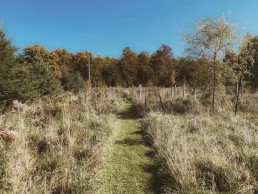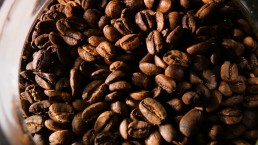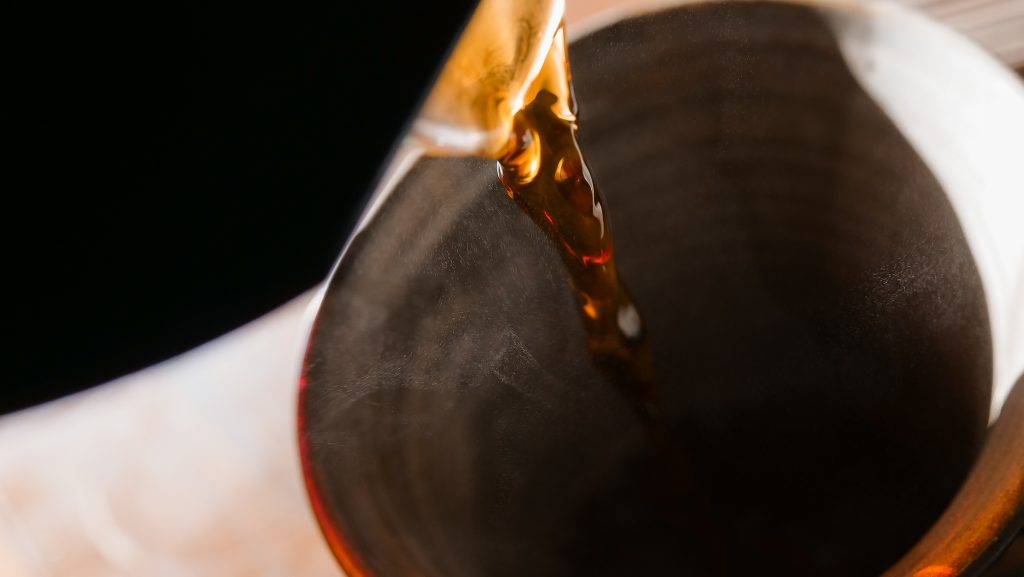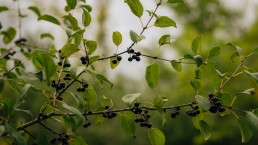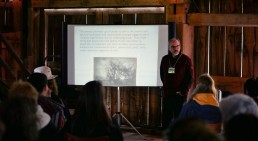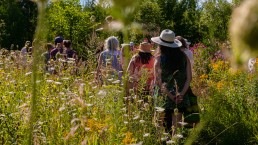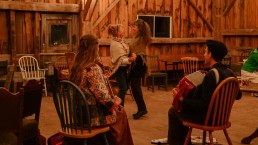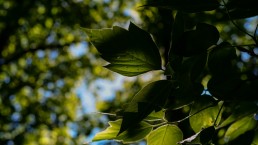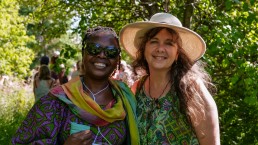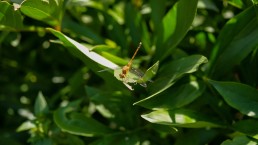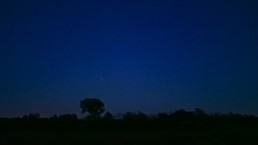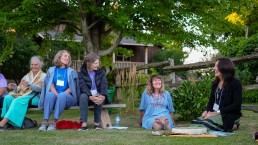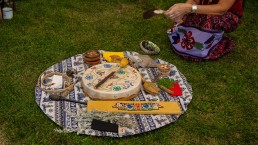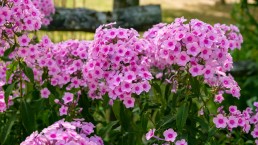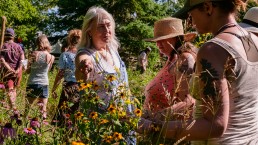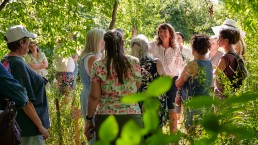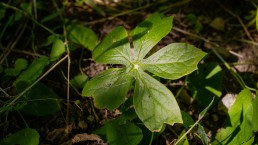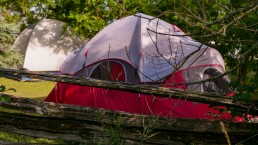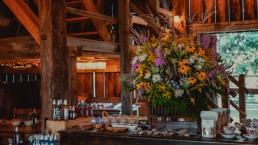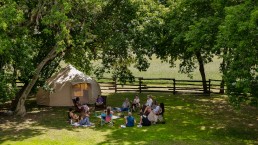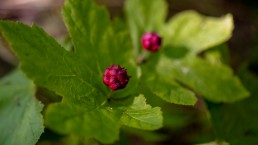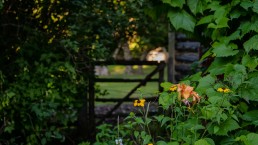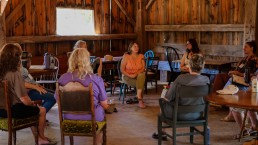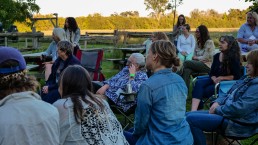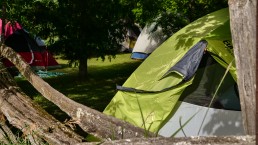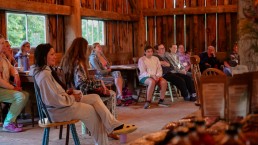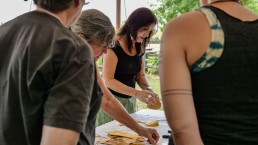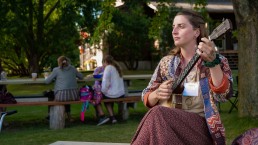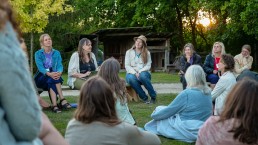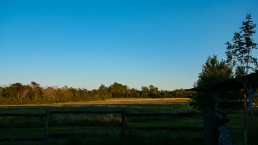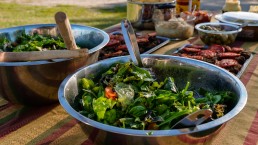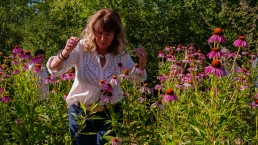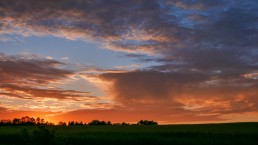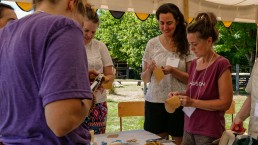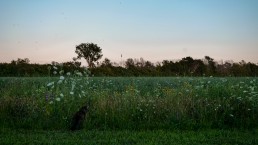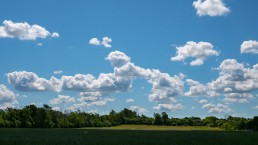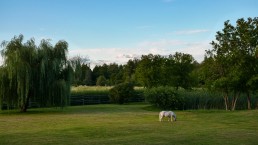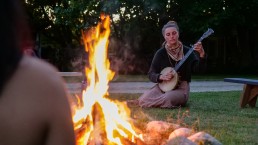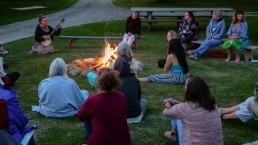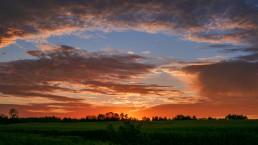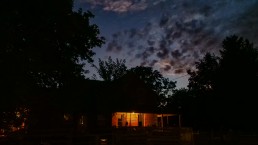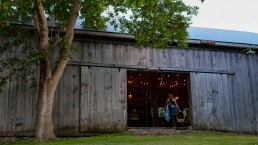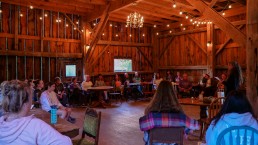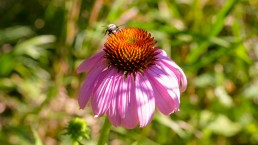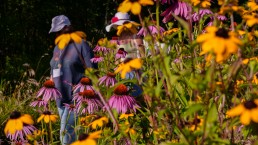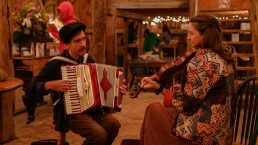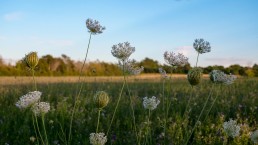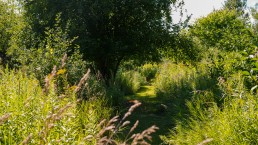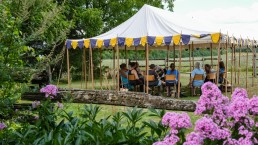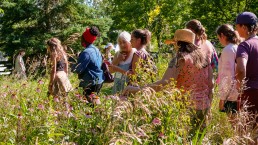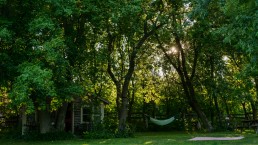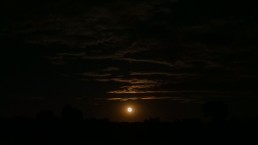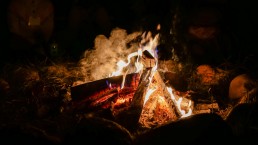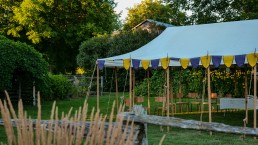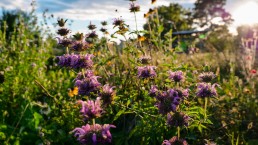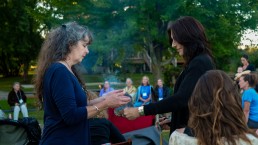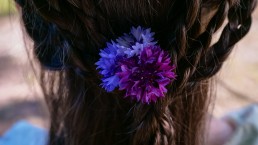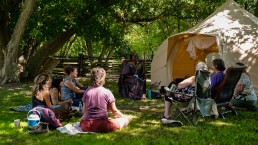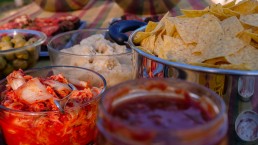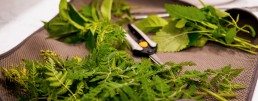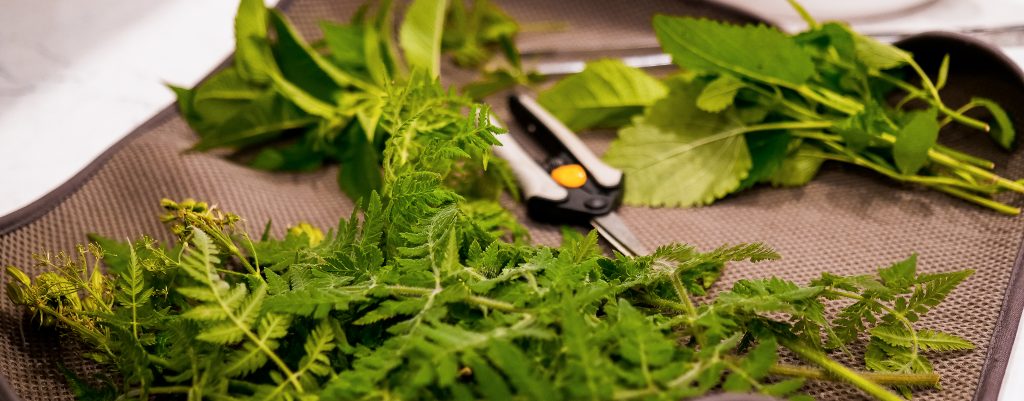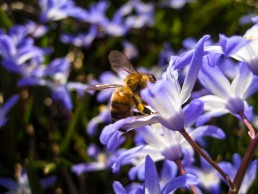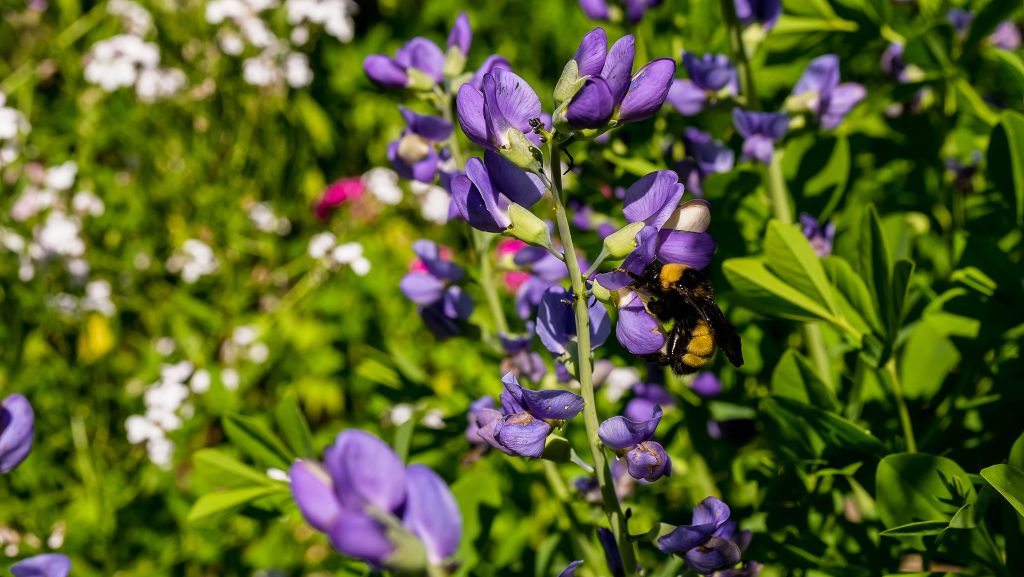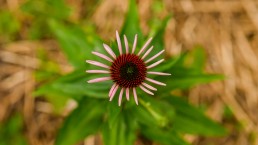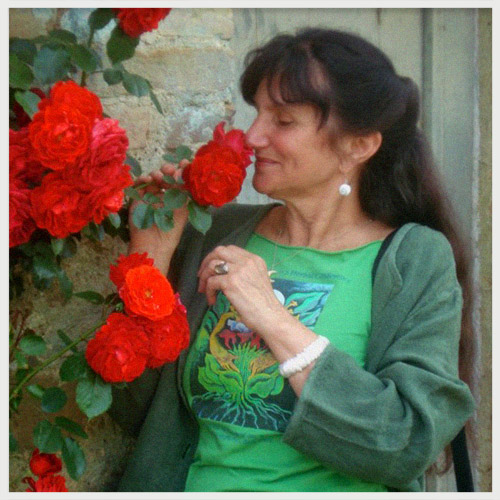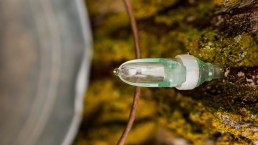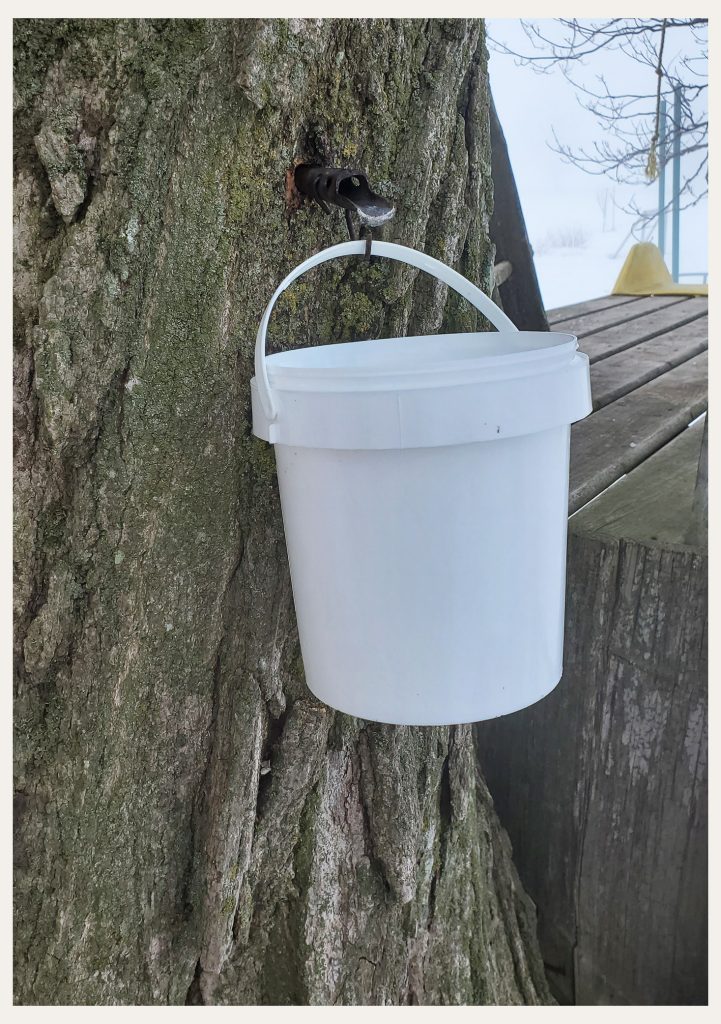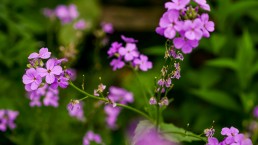For the Love of Our Landscapes
Manicured Gardens and Lawns
For so long, most western societies have valued groomed lawns and manicured gardens; those considered beautiful for their lack of weeds, crisp edges and often symmetrical landscaping. Having lived in urban areas most of my life, it wasn’t until moving to the Bruce Peninsula that I felt a sense of belonging, being surrounded by many other wild and weedy places. However, as our climate continues to change, more and more people are in search of ways to change course from the predicted direction we are headed for.
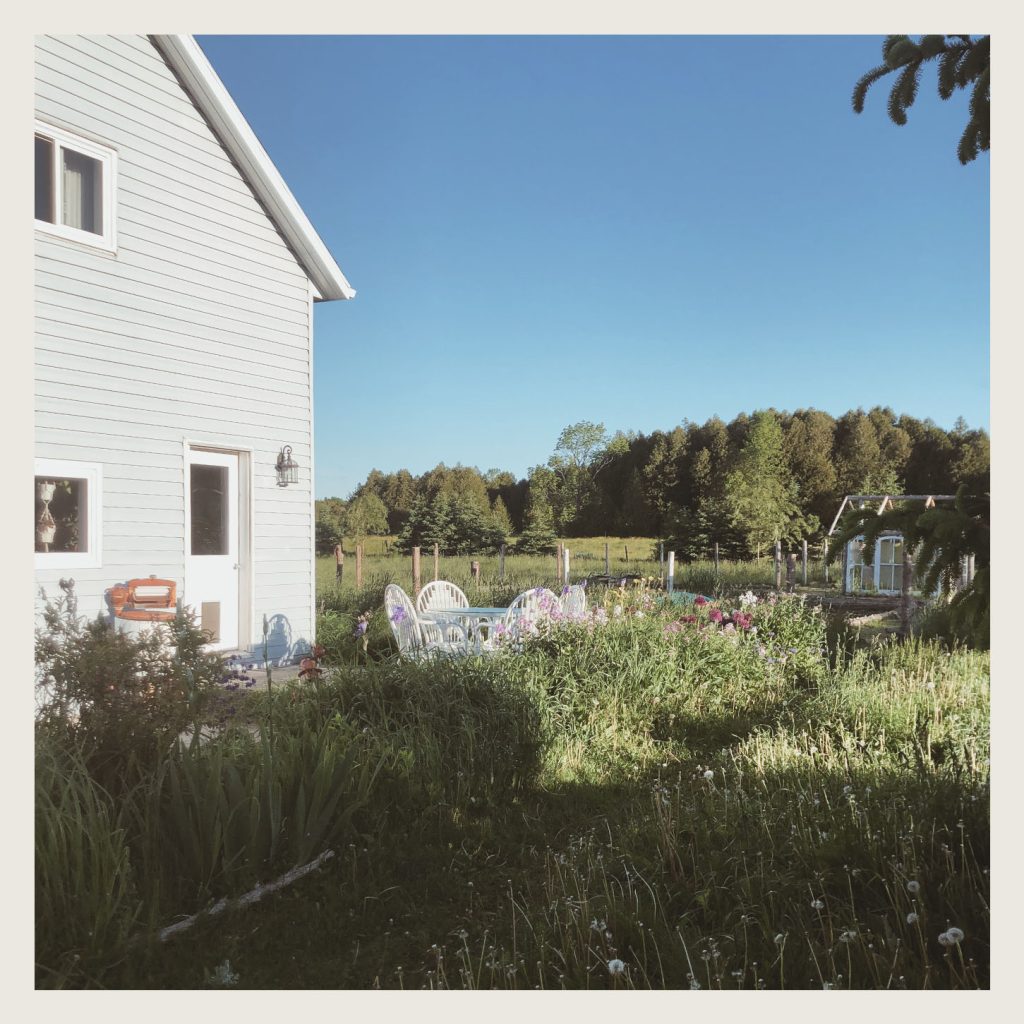
Depending on where you live, some of these impacts may be more noticeable, and in other places, less so. However, on a global scale, many parts of the world are experiencing the effects of rising sea levels, extreme temperatures and warming oceans. Our climate here in Canada is warming twice as fast as the global average. Biodiversity and habitat loss may also be observed, as the conditions of our own health continue to change, while the landscapes around us do too.
Though there are many clever and remarkable ways conservationists are trying to slow the pace of climate change (including the implementation of nature-based solutions and other effective area-based conservation measures), recognizing that many individuals and organizations are implementing strategies to reduce waste and emissions, I would argue that now is time for a change of narrative and for redefining the admirable qualities of the lands that surround us. Whether it be our backyards, community gardens or city parks, these are all opportunities to work together in support of a regenerative way forward, paying respect to every element of life that can help us fight climate change.
Of course, allowing for a wilder landscape is only one of the many actions we can take, it is one that has a cascade of positive outcomes. By creating these naturalized spaces, more land is being added to wildlife corridors (which can exist in different scales and ways), where all forms of life — mammals, birds, fish, amphibians and reptiles — can migrate, feed and drink, and we are connecting more habitats for them to move through as they continue through their different stages of life. Corridors may not have to be continuous, large or perfect to still help.
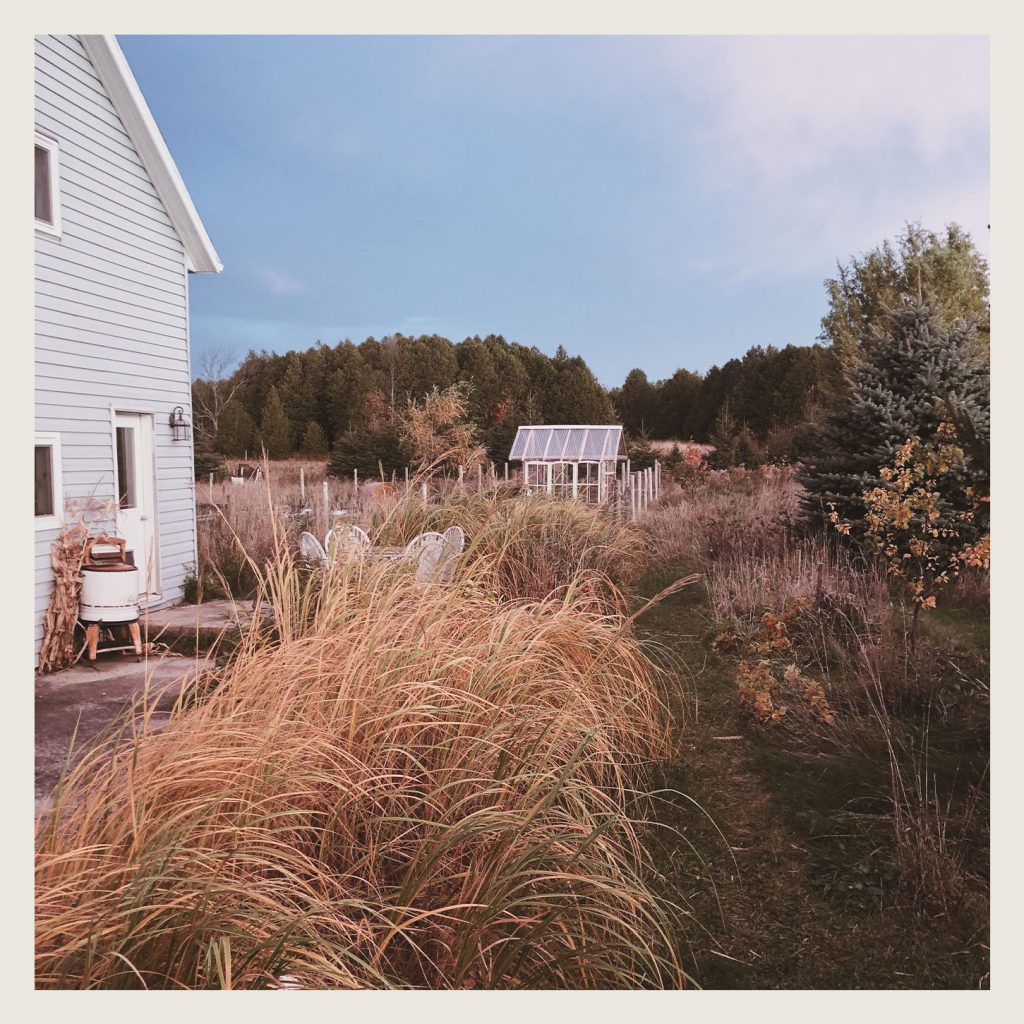
A part of my lawn where only a walking path is mowed and other tall grasses, asters, black-eyed Susans, and more are allowed to flourish
The Impact on Our Own Land
Living in a household surrounded by a naturalized lawn on the Bruce Peninsula of southwestern Ontario, I’ve witnessed these words that I share come to life. Since mowing only enough space for walking paths, planting a vegetable garden and a firepit, my family and I have been able to give back just under half a hectare of land to nature in hopes of creating a small, but thriving, ecosystem. The birdsong, combining melodies of meadowlarks, buntings, blue and blackbirds, sparrows and robins, cheers us along, as we continue to tend to the abundance of new-to-us species — black-eyed Susan, common yarrow, gray goldenrod, and a colourful variety of asters (to name but a few). Though this requires some work, these efforts promote a yard that is, in many ways, self-sufficient.
Another approach to consider is creating a food forest, or planting a diverse array of edible species, in an attempt to mimic the ecosystems and patterns found in nature. This will typically include canopy layers of fruit and nut trees, berry bushes and shrubs, herbaceous plants valuable for food and medicine, ground covers, and, at the root layer, fungi and harvestable root vegetables (this is also a great opportunity to learn what’s native to your area, and to incorporate habitat for species at risk). This concept considers the many necessary layers for maintaining symbiotic relationships, from the tallest tree to the ground below while also creating food for those doing the planting and the species passing through.
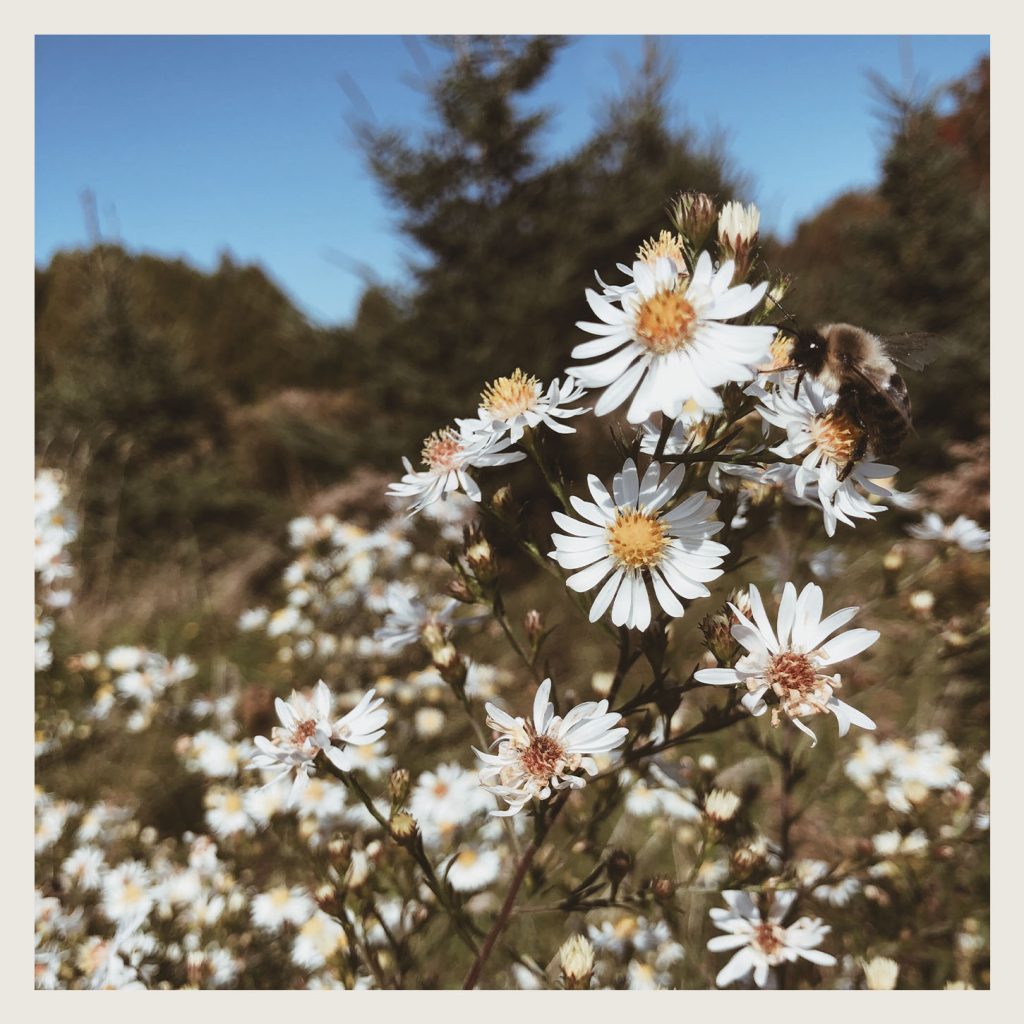
In some cases, municipalities have bylaws about what you can do with your outside areas, ensuring you meet a standard or level of care throughout your subdivision or community. Finding out what policies exist can be a great way to spark change.
Other Ways to Contribute
All this said, more and more people today are taking up residence in urban areas, including suburban neighbourhoods with little to no backyard, condos and apartments, group and community housing. This doesn’t mean you can’t make a difference, though! Along with starting conversations and sparking change, community gardens are another great addition to wildlife corridors, and they usually start thanks to the efforts of one or few people. This can be a great way to build community in an effort toward a viable and more biodiverse future, which will further awareness of the importance of maintaining our greenspaces.
Change doesn’t happen overnight. I encourage you to take a look around you. See the landscapes, both large and small, as opportunities to create food, habitats and pathways for those we share our world with, and remember that we are only as resilient as our ecosystems.
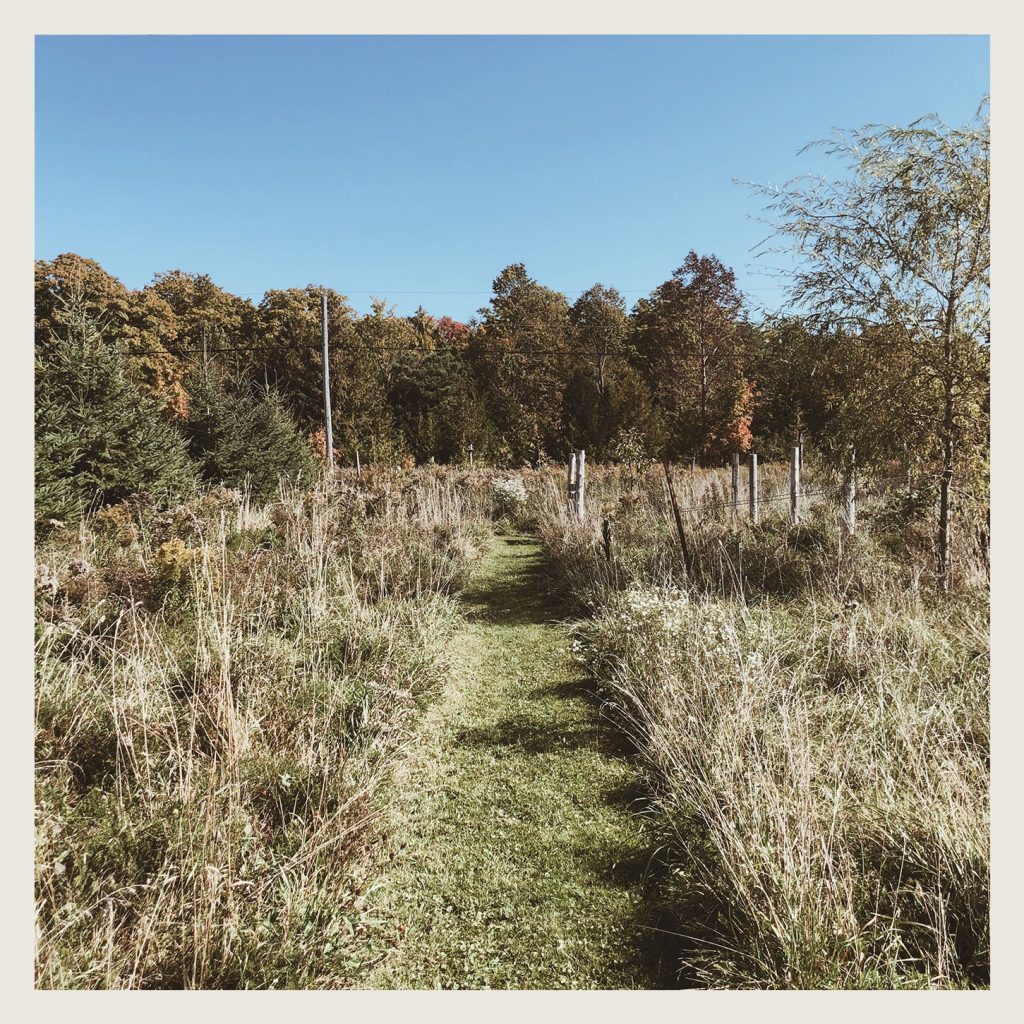
Photos Provided by Chelsea Vieira
Coffee: The Good the Bad and the Ugly
An Historic Global Enterprise
Coffee is one of the most ubiquitous and widely consumed beverages in the world, second only to water. The already extraordinary demand for coffee only seems to be increasing; global coffee production reached 175.35 million 60-kilogram bags as of 2020/2021, increasing from about 165 million 60-kilogram bags in 2019/2020.
Coffee drinking, and the knowledge of the coffee tree as a medicinal substance, dates back to at least the mid 15th century, where we find our first credible historical evidence pertaining to its use in the accounts of Yemini author Ahmed al-Ghaffar. The coffee tree was most likely introduced into Yemen by way of trade routes with Ethiopia from across the Red Sea. Thus, given that the coffee tree was being traded and exported from Africa, it is highly unlikely that its medicinal, recreational, and social values were only realized in the 15th century, in a country where the tree itself was not native. The use of coffee almost certainly reaches back much further than the 15th century, though specifics concerning its initial discovery by the peoples of the African continent and its use in their traditional systems of medicine and culture remain obscure.
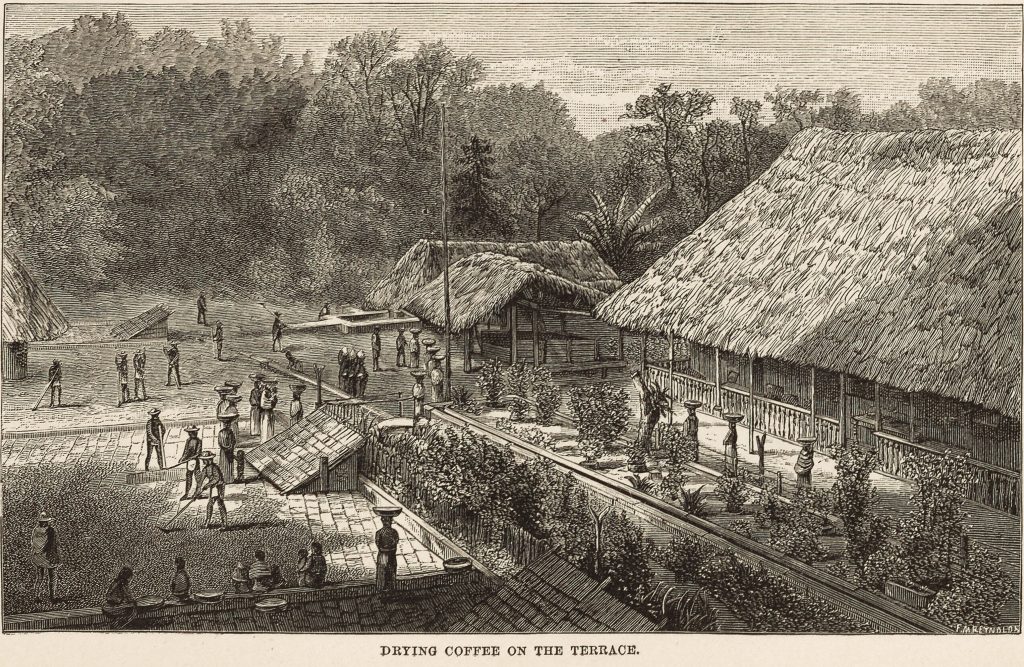
When it comes to the earliest detailed historical records concerning the use of coffee, we can look to the work of Harvard historian Cemal Kafadar, where it is revealed that the social significance of coffee in Islamic society was established by way of its use in Sufi religious rituals:
“To turn to the early history of coffee and coffeehouses, more specifically, there must have been many instances when coffee was consumed as a plant found in the natural environment of Ethiopia and Yemen, but the earliest users who regularized its consumption as a social beverage, to the best of our knowledge, were Sufis in Yemen at the turn of the fifteenth century. Evidently, they discovered that coffee gave them a certain nimbleness of the mind, which they were keen on cultivating during their night-time vigils and symposia. Thus started the long history of the appreciation of coffee as a companion to mental exercise and conviviality, particularly when one wished to stretch or manipulate the biological and social clock.”1
The Start of The Coffee House Phenomenon
It is from this point onward that coffee houses started to appear across Arabia and gradually, over the next three centuries, throughout the rest of the world. The historical significance of the coffee house is inextricably bound up with the historical significance of coffee itself; the coffee house has always served as a kind of public institution and cultural hub through which all manner of information – from the common and mundane to the revolutionary and political – was shared and disseminated amongst the population. Even today, in a world increasingly characterized by digital identities and disembodied forms of social engagement, the coffee house still serves as a place of respite, where people can turn for a semblance of embodied interpersonal interaction and exchange in an evermore alienating and depersonalizing world.
Coffee’s appearance in Europe (especially England and Germany) in the late 17th century coincided with the discovery that clocks could be controlled by harmonic oscillators. This was followed in the 18th century by a series of technological discoveries and breakthrough inventions that lead to increasingly precise clocks, and hence to a heretofore unimaginable regimentation of time itself. Is it a mere coincidence that coffee – utilized by so many for the purposes of maintaining attention and increasing stamina – came to Europe just as machine production and the Industrial Revolution, with the inhuman demands it placed on workers, led to a decline in hand production and the artisanal trades of the past? From the perspective of cultural history, coffee has a dual identity; as a tool for social conviviality and the free flow and exchange of ideas (exemplified by the institution of the coffee house), as well as a crucial ingredient in the engineering of the industrial worker, allowing for the kind of over-stimulation that is required to meet the demands of the fast paced, mechanized world of industrial society. The hegemony of standardized clock time, and the counting of seconds, minutes and hours as measures of productivity and profitability, violated the natural diurnal rhythms that human beings had always used to orient their lives. The question remains as to the extent to which coffee played a role in one of the biggest cultural shifts in recorded history.
Historical Religion and Politics
The opinion of the medical profession with respect to coffee has been divided throughout history. Coffee is exemplary when it comes to demonstrating the degree to which medical opinion can be deeply influenced and shaped by cultural and political trends and assumptions. Indeed, the medical, socio-political and religious views of coffee were at times inextricably bound up with each other, making it next to impossible to disentangle one from the other. Where does religious belief end and medical “fact” begin? We can explore this issue by taking a closer at the early history of coffee in the Islamic world, and the changing tide of opinion with respect to the most influential and powerful drink in the world, next to water itself.
In contrast to the view that the introduction of coffee into liturgical practice was a great blessing in that it allowed worshipers to better execute their devotions to God, other religious scholars argued that coffee should be outlawed insofar as it had never been mentioned in the Quran. Many of these scholars were also concerned about what they perceived to be the deleterious health consequences of coffee consumption. But this controversy is even further muddied when we stop to consider the political climate of the time. While some commentators argue that the various attempts to outlaw coffee in the Islamic world were a consequence of religious and medical opinion, the truth is more likely that coffee (and the social revolution spurred by the birth of the coffee house) was perceived as a political threat.
“Between the early 16th and late 18th centuries, a host of religious influencers and secular leaders, many but hardly all in the Ottoman Empire, took a crack at suppressing the black brew. Few of them did so because they thought coffee’s mild mind-altering effects meant it was an objectionable narcotic (a common assumption). Instead most, including Murad IV [the Ottoman sultan who issued a ban on coffee in 1633], seemed to believe that coffee shops could erode social norms, encourage dangerous thoughts or speech, and even directly foment seditious plots.”2
In what is perhaps an unexpected twist, our brief survey of the cultural and political history of coffee has revealed the extent to which many of our deeply held assumptions, sometimes taken as objective fact, in actuality rest upon a socio-political and theological underpinning of opinion and currents of dogmatic belief which colour our perception, of which we may be mostly or even totally oblivious.
PART II: Coffee as Medicine, Coffee as Poison
What is the difference between a food and a medicine? In his essay from 1803 titled ‘On the Effects of Coffee’, Samuel Hahnemann (the founder of homeopathy) set out to clarify this distinction and to warn of the deleterious effects of the unchecked consumption of medicinal substances, taking coffee as a paradigmatic example. Hahnemann writes:
“Medicinal things are substances that do not nourish, but alter the healthy condition of the body; any alteration, however, in the healthy state of the body constitutes a kind of abnormal, morbid condition. Coffee is a purely medicinal substance. All medicines have, in strong doses, a noxious action on the sensations of the healthy individual. No one ever smoked tobacco for the first time in his life without disgust; no healthy person ever drank unsugared black coffee for the first time in his life with gusto — a hint given by nature to shun the first occasion for transgressing the laws of health, and not to trample so frivolously under our feet the warning instinct implanted in us for the preservation of our life.”3
A medicine is a substance that serves to alter the state of health, whereas a food is a substance that serves to provide nourishment. When medicines are taken in excess, or when they are not properly indicated for an individual person, they can produce an abnormal or even pathological condition. Medicines can preserve life and maintain health, though they can also derange the state of health and take life away when they are given without the requisite attention or care. Food substances can likewise produce states of disease if they are eaten to excess, though the deleterious effects of foods generally take a much longer time to manifest when compared to the stronger power of medicinal substances to affect deep seated changes on the level of constitutional vitality.
While in 1803 Hahnemann condemned the use of coffee, going to so far as to argue that its unchecked consumption was the origin of many of the chronic diseases that plagued humanity, he later toned down his opinion, having developed a much more sophisticated theory of the origins of chronic diseases by way of the concept of the miasms (the 18th century precursor to our contemporary theories of epigenetics, and one of the philosophical foundations of homeopathic medical practice to this day). Nevertheless, Hahnemann was right to emphasize the extent to which medicinal substances, when treated as foods and consumed injudiciously, can exert profound effects on the state of health. This is especially true if conditions of heightened susceptibility to a given substance are at play in an individual’s constitution (think here of the example of severe allergic reactions to substances that to most people are extremely benign). Human response to coffee and to caffeine varies widely, and like any assessment of a medicinal substance, individual response patterns must always be given a higher regard than overly generalized, universal theories and pronouncements. The difference between a medicine and a poison is ultimately in the dose, and the effect of the dose is always weighed in relation to the individual to whom it is administered.
The Hahnemann of 1803 represents one extreme when it comes to thinking about coffee as medicine. A look at the medical literature on coffee, from from the 15th century to the present day, is full of contradictory and opposing points of view. Coffee was for centuries listed in the pharmacological and medical literature that herbal and Eclectic physicians relied upon, such as the Codex Medicus. Coffee remained classified as a medicinal substance in materia medica and pharmacopoeias until the twentieth century, when the use of natural medicinal substances was largely supplanted by the products of the petrochemical drug industry. Maria Letícia Galluzzi Bizzo et al. recount some of the claims made about coffee in the medical traditions of the West, emphasizing and siding with the view of coffee as a universal elixir of health (the poplar opposite of Hahnemann’s position):
“As a panacea, coffee has been prescribed as infusions, capsules, potions, or injections against a vast spectrum of diseases— from hernias to rheumatism, from colds to bronchitis. In the first half of the nineteenth century, medical controversies underlined the therapeutic use of caffeine in chronic conditions such as heart and circulation problems because of difficulties establishing the proper doses and the risk of toxicity to the heart. Nevertheless, the notion that such use would be safe prevailed. Recent research has opened new horizons regarding the use of coffee as a medicine, with discoveries of possible distinct preventive and curative applications of coffee’s substances.”4
The Coffee of Today
The medical opinions of the past are in many ways inadequate when it comes to judging the effects of coffee today. The coffee of the 1800s is not the coffee of the 21st century. Consider, for example, the question of pesticides. Only about 3% of the world’s coffee supply today is produced using organic methods, and we now know that the residues of pesticides found on coffee beans, one of the most pesticide ridden agricultural products in the world, are for the most part not destroyed by the roasting process. Many countries that produce coffee use pesticides that have been banned in North America and Europe over health and safety concerns, and a significant number of the countries which import this coffee do not have maximum residue limits (MRLs) when it comes to the pesticides that are used and can be detected on the harvested coffee beans.

Mold is yet another issue. When not stored in a temperature controlled storage facility, coffee beans are also highly susceptible to developing mold, which comes with its own host of long term adverse health effects. Even roasting techniques have a great bearing on coffee’s potential effects on one’s state of health. One study carried out by the International Association for Food Protection, for example, comes to the following ambiguous conclusion concerning the question of the carcinogenicity of coffee and how this is affected by the roasting process:
“Roasting coffee results in not only the creation of carcinogens such as acrylamide, furan, and poly-cyclic aromatic hydrocarbons but also the elimination of carcinogens in raw coffee beans, such as endotoxins, preservatives, or pesticides, by burning off. However, it has not been determined whether the concentrations of these carcinogens are sufficient to make either light or dark roast coffee more carcinogenic in a living organism.”5
There are a whole host of other socio-economic and political considerations that should be borne in mind with respect to the global coffee industry of the 21st century. Health is not a purely individual consideration; the health of your body and mind are indissociably bound up with the functioning of the larger natural and artificial systems in which you exist. We are unwitting participants in a global system of capitalist exploitation which, through the untiring impulses of profitability and expansion, inevitably leads towards the total degeneration of the natural world and the complete immiseration of its inhabitants. A sober and careful look at coffee and its economic, political, and agricultural ramifications, inevitably alerts us to a confrontation with this reality.
Capitalism, Globalization, and the Politics of Coffee Production:
The pesticide residues found in your average bag of coffee are inconsequential in comparison to the toxicity that third world coffee farmers are exposed to on a daily basis. These farmers, in addition to the dire health consequences of chronic chemical exposure that are an unavoidable part of their work, lead lives that are dictated by the brutal conditions of strenuous labour, physical exploitation and the inter-generational cycles of inescapable poverty, child labour and indentured servitude. Alice Nguyen, in an article written for The Borgen Project (a non-profit organization dedicated to addressing the global issues of poverty and hunger), unflinchingly encapsulates these issues:
“Growing coffee requires intensive manual work such as picking, sorting, pruning, weeding, spraying, fertilizing and transporting products. Plantation workers often toil under intense heat for up to 10 hours a day, and many face debt bondage and serious health risks due to exposure to dangerous agrochemicals. In Guatemala, coffee pickers often receive a daily quota of 45 kilograms just to earn the minimum wage: $3 a day. To meet this minimum demand, parents often pull their children out of school to work with them. This pattern of behavior jeopardizes children’s health and education in underdeveloped rural areas, where they already experience significant barriers and setbacks.”6
Facts like these seem to underlie the importance of Fairtrade and Organic Certification for coffee and related products, which in principle strive to ensure sustainable development, equitable trading conditions, and giving autonomy back to marginalized farmers and agricultural workers. However, consumers in the Western world must not fall into the self-congratulatory trap of thinking themselves morally superior because they are able to afford the often vastly more expensive Organic and Fairtrade Certified products that are simply outside of the economic reach of many. The reality is that, in many instances, the increased profits from organically grown coffee products do not reach the farmers and laborers themselves, but end up lining the pockets of the distributors, who in many regions of the world function in similar ways as do drug cartels.
What is more, there are the significant and rarely discussed pitfalls of introducing organic agricultural techniques to farmers who work on lands that have been treated with chemical pesticides for decades. Such agricultural land will require significant time and effort in order to be rehabilitated such that organic farming can be sustained there. This means that farmers who are already struggling to maintain their operations run the risk of falling even further into economic enslavement if they are coerced into adopting the organic methods that righteous and ecologically minded politicians, consumers, academics and other self proclaimed “experts” in the Western world preach about with moral fervour.
Consider the following story, told by the son of a soybean farmer working in El Toledo, Costa Rica. He recalls a childhood memory of the year his father was convinced by Penn State University professors to adopt organic agricultural techniques, under the promise of increased profitability and the ecological restoration of their farmland:
“The professors convinced my dad to make a wholesale change from conventional soybean farming to organic. They warned him that he might lose up to 15% of his yield, but that this would be offset by a number of factors: He could sell his soybeans for more, as they were organic. His soil would be healthier. He would spend less on chemical inputs, and thus save money. The reality was very different. Instead of losing 15% of our yield, we lost 50%. Instead of spending less money, he spent more: the gas he spent to tractor over the weeds alone outstripped his usual chemical spending.
He ended up taking a job in a factory to avoid bankruptcy. All I remember is that when I was eight, I never saw my dad: he was either weeding the soybeans or at the factory. As soon as that season ended, we went back to chemical farming.”7
Many such stories, pertaining to all manner of farming from all parts of the world, can be found if one cares to look beyond the ‘Certified Organic’ and ‘Fairtrade’ labels that one sees plastered on one’s favourite products lining the local supermarket shelves. From coffee and soybeans to chocolate and Brazil nuts and beyond, the exploitation of labourers and the degeneration of the world’s ecosystems are part and parcel of our contemporary agricultural systems of production, whether conventional or organic. Any consideration of “sustainability” must always be understood within the framework of the global capitalist economic system in which we exist. As the political and cultural theorist Mark Fisher so poignantly put it in his book Capitalist Realism: Is There No Alternative?:
“The relationship between capitalism and eco-disaster is neither coincidental nor accidental: capital’s ‘need of a constantly expanding market’, its ‘growth fetish’, mean that capitalism is by its very nature opposed to any notion of sustainability.”8
The preceding section of this article is not intended to inculcate feelings of guilt, a sentiment which only leads to a place of demoralization and further defeat. Rather, it was written out of an honest assessment of the situation in which we all find ourselves as consumers in a system which, in its vast complexity, far transcends the individual decisions that you and I make on a daily basis. It is only from a place of sober awareness that a genuine desire for a better world can be nurtured and allowed to bear fruit.
And now, with these economic, cultural and political factors in mind, let us turn to consider the detailed effects of coffee from a more purely medical perspective. A well rounded discussion of coffee requires that we adopt a multi-perspective view. Single vision is, after all, what the capitalist system of exploitation itself is based on.

PART III: Coffee’s Medicinal Effects: What Can Reliably Be Said?
Coffee is a nervine stimulant, i.e. an herb that causes excitation and stimulation of the nervous system, specifically by engaging or heightening the activity of the sympathetic nervous system. The most widely known and discussed function of the sympathetic nervous system is the mediation of the neuronal and hormonal stress response pattern known as the fight-or-flight response. The sympathetic nervous system is what allows the body to quickly react and respond to situations of threat and danger, to situations that threaten survival. But the sympathetic nervous system cannot be adequately understood if we look at it as an isolated regulatory or physiological function. The sympathetic nervous system works in concert with the parasympathetic nervous system and together make up what is called the autonomic nervous system. The autonomic nervous system regulates and controls many of the functions of the body’s internal organs. When we consider the interdependence and co-functioning of the sympathetic and parasympathetic nervous systems, then we can begin to understand that the stress response typically associated with the sympathetic nervous system is one pole or extreme of a greater homeostatic controlling mechanism which oversees the feeling and function of the human organism on many levels.
However, excessive stimulation of the sympathetic nervous system can and does result in undue consequences. Herbalist David Hoffmann explains the action of nervine stimulant herbs, and relates their functions to the excessively heightened states of excitation that characterize the frantic and overwrought patterns of 21st century existence:
“Direct stimulation of nervous tissue is not often needed in our hyperactive modern lives. In most cases, it is more appropriate to stimulate the body’s innate vitality with the help of nervine or bitter tonics. These herbs work to augment bodily harmony, and thus have a much deeper and longer-lasting effect than nervine stimulants. In the 19th century, herbalists placed much more emphasis upon stimulant herbs. It is, perhaps, a sign of our times that the world now supplies us with more than enough stimulation. When direct nervine stimulation is indicated, the best herb to use is Cola acuminata, although Paidlinia cupana, Coffea arahica, Ilex paraguayensis, and Camellia sinensis may also be used. One problem with these commonly used stimulants is their side effects; they are themselves implicated in the development of certain minor psychological problems, such as anxiety and tension. Some of the volatile oil-rich herbs are also valuable stimulants. Some of the best and most common are Rosmarinus officinalis and Mentha piperita.”9
Caffeine is the most widely recognized and studied active ingredient in coffee as well as many other stimulant herbs (such as those listed in the above quotation). But coffee also contains a wide array of other important constituents such as tannins, fixed oils, carbohydrates, and proteins, which should not be forgotten, as coffee, just like all herbs, are irreducible to their component parts. It is through the roasting process that caffeine is liberated from the raw coffee bean. Caffeine produces diuretic and stimulant effects, specifically on the respiratory, cardiovascular and central nervous systems.10 Caffeine is also an analgesic adjuvant, and hence is incorporated into a wide number of proprietary aspirin and acetaminophen preparations.11 Coffee also contains phytoestrogens, which have been subject of a great deal of scientific debate. Phytoestrogens can play a role in addressing symptoms and conditions caused by estrogen deficiency, which may be especially pronounced in premenopausal and post-menopausal women. They are also implicated in memory and learning processes and have been shown to possess anxiolytic effects. The research into the effects of phytoestrogens on human health is still ongoing, and is a fruitful and fascinating area of research. For example, consider the fact that the consumption of beer, bourbon, mescaline, cannabis, and coffee all produce phytoestrogenic effects – the relationship between psychoactivity and phytoestrogenic compounds certainly needs to be more deeply explored!
When it comes to consider possible contraindications and adverse reactions from coffee consumption, we should note that coffee, along with fried and fatty foods, chocolate and alcoholic beverages, can lead to or serve to aggravate LES dysfunction (the lower esophageal sphincter, which links the esophagus and the stomach). Obesity, pregnancy, cigarette smoking, and a structural weakness of the diaphragm known as hiatus hernia can also contribute to a weakening of the LES. If the LES fails to properly close, stomach acid can easily splash up from the stomach into the esophagus, leading to severe acid reflux and heartburn. Gastroesophageal reflux disease (commonly known by the acronym GERD) is associated with a leaking of stomach contents back into the esophagus. When there is a prolonged period of LES dysfunction, this can lead to acid and chemical damage of the esophagus, that is, to GERD.
The consumption of coffee and other caffeine containing substances can also result in headaches. The headaches that are associated with coffee consumption are often related to caffeine dependence, which can lead to significant withdrawal symptoms in some individuals. As Hoffmann writes:
“Caffeine can cause headaches by increasing the body’s expectation for it. When blood levels of caffeine drop, symptoms of withdrawal, including headache, may set in. That’s why some heavy coffee drinkers experience “morning headache” until they have that first cup of coffee. Caffeine headaches are usually experienced as a dull, throbbing pain on both sides of the head. Once the body rids itself of caffeine, the headaches disappear on their own. Such headache sufferers, however, are often unaware that their problem is due to caffeine and will continue to drink coffee, ensuring that the problem will recur.”12
We can look to the homeopathic literature to round out our consideration of the spectrum of effects that coffee can have. In homeopathy, the medicinal effects of a given substance are elaborated through clinical experience as well as through provings. A proving entails rigorous and detailed observation of the effects of a substance when administered at a sufficient dosage in its crude form and/or as a dynamic or potentized medicine (having been subjected to serial dilution and succussion or vigorous shaking), such that it produces modifications to the state of a person’s health and disposition. The fundamental principle of homeopathic prescribing is that like treats like. In other words, if a substance can cause a certain symptom on the physical, mental/emotional, or dispositional level in a relatively healthy person, then it can in like manner work to treat those same symptoms when they are expressed by a patient who comes seeking care.
Dutch Homeopath Jan Scholten describes the essence of the patient needing potentized coffee (Coffea Arabica) in the following way:
“Coffea is the ideal intellectual worker. They feel stable, focused and self-confident in their mind… They are independent and responsible, following their own plans.”13
The coffea patient often possess a great deal of stability, they are responsible, hard working, persevering, and their actions are well organized and carefully planned. Coffee in its crude form can serve to promote these qualities in people, so it is no wonder that many rely upon it in a culture which emphasizes work, productivity, and efficiency. Scholten explains that the mind of the coffea patient can be active and full of ideas. They can have clear, active, and lucid thoughts, are fast and easy learners with great comprehension skills. They can experience a rush of thoughts, a heightened sense of judgment and sharp and acute states attention. They tend to be quite ambitious people, with a strong and even overpowering need to achieve. They can feel that they must work as hard as possible to fulfill their own expectations, as well as the expectations of their parents (especially the father). Given the great demands that they place upon themselves, and the seriousness with which they approach their assigned tasks and responsibilities, the coffea patient can experience states of pronounced nervous agitation, excitement, exaltation, hilarity, restlessness and irritability – think of the states associated with and over-excitation of the nervous system.
Oversensitiveness is a keynote of this remedy, and all of the senses – sight, hearing, smell, taste, and touch – can be greatly heightened. Eating and drinking are things that they do quickly and in a hurried way, as befits their general tendency towards restlessness, hurry, and hyperactivity. The coffea patient may also be the type of person who feels that they cannot live up to the pronounced and unrelenting demands and expectations that they are faced with, and hence suffer from a lack of self confidence, which is improved through the use of stimulants. They feel things intensely, and can have a tendency to exaggerate their emotions and be highly susceptible to the impressions to which they are exposed. Emotional excesses, from extraordinary states of pleasure, optimism, and joy (coffea is a remedy for ailments from excessive joy) to the polar opposite of pronounced despair and despondency, with sharp anger and rudeness. When in this latter state, they can throw everything away, disposing of all that they have been given – in contrast, they can also be excessively clingy, and want to desperately hold on to people and their possessions. They feel pain intensely, and their anguish can run deep. Coffea can have the following delusions: “paradise, magnificent grandeur, beautiful world, heavenly scenes.” They experience states of benevolence and idealism, with a desire to perform good deeds, and veneration for the Supreme Being. Coffea may be prescribed for “ailments from vexation, mortification, frustration; discords between relatives, friends; hurry; anticipation; sudden emotions, pleasurable surprises.” The treatment of a variety of headaches, neuralgic pains and spasmodic afflictions, heart palpitations, digestive disturbances, and states of insomnia may also be addressed with coffea.
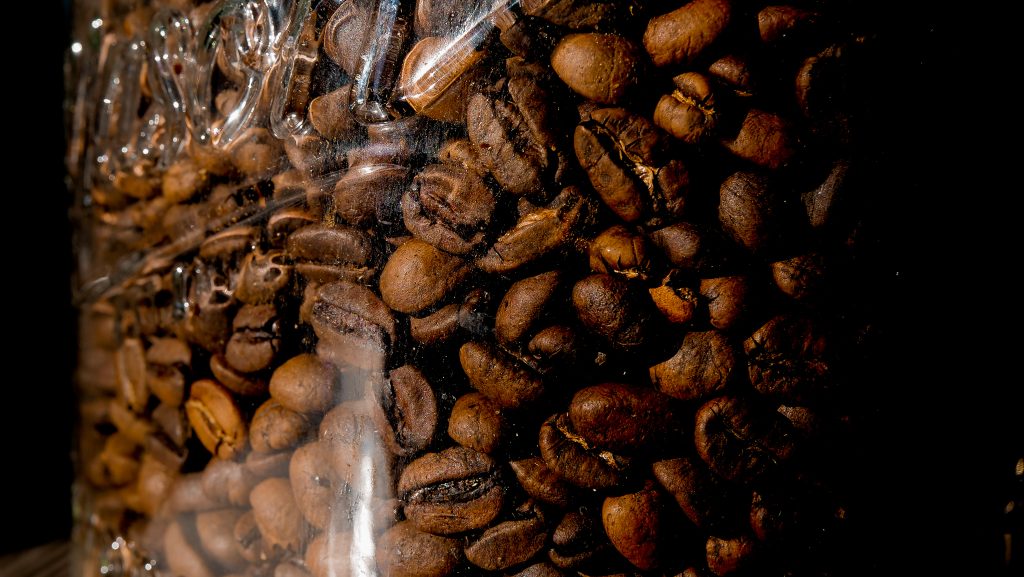
In Conclusion…
From our explorations into all things coffee, we may conclude that it is, perhaps more than any other substance in existence, paradigmatic of the culture of modernity. From controversies regarding altered states of consciousness to the regimentation of life brought about through the reign of clock time, from the exploitation of agricultural workers in the 3rd world to meet the needs of the Western consumer to controversies in the medical profession concerning the difference between medicinal and poisonous substances, coffee is both practically and symbolically encoded with many of the most pressing concerns of the culture of modernity. Our investigations into coffee have served to reveal the myriad ways in which everyday substances are always already embedded within and serve to reflect the complex cultural, economic, and political realities in which we exist. The tremendous extent to which plants play a role in shaping human culture through modification of the patterns of human thought and behaviour has also become clear. We have long ago reached the point that our world would be unrecognizable without coffee.
Footnotes:
1 Cemal Kafadar. ‘How Dark is the History of the Night, How Black the Story of Coffee, How Bitter the Tale of Love: The Changing Measure of Leisure and Pleasure in Early Modern Istanbul’ in Medieval and Early Modern Performance in the Eastern Mediterranean, ed. by Arzu Öztürkmenand Evelyn Birge Vitz, lmems 20 (Turnhout: Brepols, 2014).
2Mark Hay. ‘In Istanbul, Drinking Coffee in Public Was Once Punishable by Death.’Atlas Obscura, May 22, 2018. https://www.atlasobscura.com/articles/was-coffee-ever-illegal
3 Samuel Hahnemann, The Lesser Writings Of Samuel Hahnemann, ed. and trans. R.E. Dudgeon. New York: William Radde, 1852. Pg. 392.
4 Maria Letícia Galluzzi Bizzo et al. ‘Highlights in the History of Coffee Science Related to Health.’ Science Direct, 7 November 2014. https://www.sciencedirect.com/science/article/pii/B9780124095175000024
5 Joseph Kim et al. ‘Safest Roasting Times of Coffee To Reduce Carcinogenicity.’ PubMed, 1 June 2022. https://pubmed.ncbi.nlm.nih.gov/35226750/#:~:text=Abstract,or%20pesticides%2C%20by%20burning%20off.
6 Alice Nguyen. ‘Bitter Origins: Labor Exploitation in Coffee Production.’ Borgen Project, 24 September, 2020. https://borgenproject.org/labor-exploitation-in-coffee-production/
7 Brian Stoffel. ‘Urban Elites, Organic Farming & The Hypocrisy of No Skin-In-The-Game’. 14 June, 2017.
https://medium.com/@stoffel.brian/urban-elites-organic-farming-the-hypocrisy-of-no-skin-in-the-game-b9f95b655686
8 Mark Fisher. Capitalist Realism: Is There No Alternative? Oregon: Zero Books,2009. Pg. 18-19.
9 David Hoffmann. Medical Herbalism. Vermont: Healing Art Press, 2003. Pg. 519.
10 Ibid, pg. 124.
11 Ibid.
12 Ibid, pg. 365.
13 Jan Scholten. ‘Coffea Arabica.’ QJURE (undated publication). https://qjure.com/remedy/coffea-arabica-2/
Illustrations/Images:
- Illustration: Novel “Coffee: From Plantation to Cup. A Brief History of Coffee Production and Consumption” 1881 [x]
- Photos provided by Serena Mor
Old Fence Rows and Buckthorn
Spring is Ever Drawing Nearer
My fingers are itching to be in the earth once more – to sow and plant — bringing me into a deeper connection with the Earth once more. Our seeds have all been delivered and our trees ordered, and we are already busy here on the farm. The sugar shack is getting a new wind break and the chainsaw is sharpened and ready to go. With the snows melted and frost still in the ground it is the perfect time of year to work away at controlling the invasive Buckthorn.
As many of you know, besides being a clinical herbalist, educator and tea blender extraordinaire (a tea nut to some), we are a botanical sanctuary member of United Plant Savers. Gifting back to the Earth, thankful for all she has gifted us, especially plant medicine. So, we have been busy planting and rewilding for over thirty years now. Our goal is to plant as many endangered and native medicinal plants and trees as we can each spring and fall.
Over the years, we have had a few comments about the non-native species growing and thriving on the farm, people encouraging me to consider digging them all out, eradicate the invasive species from the land.
(Invasive species: “An organism that is not indigenous, or native, to a particular area.”)
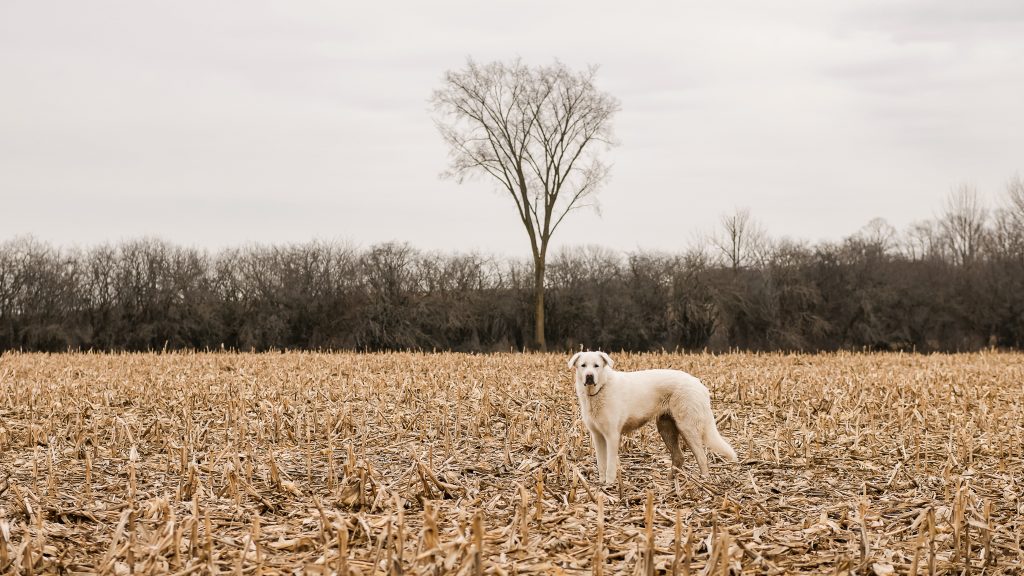
This is easy to say for a person who is not doing the ‘work’ or not possessing a strong love for all who grow and live on these one hundred acres of land. Do we cut down non-native trees, who’s limbs hold nests of baby birds? Do I pluck every Plantain plant from the land? Do we dig up the lilacs brought with the pioneers, that still grace this farmstead — reminders of days gone by? What about her fragrant blossoms that the pollinators seek out each spring? Think about the connection they have already formed to this land.
What about the invasive species that take over an area and swallow up what was there before? These I am trying my best to keep in check and harvest freely for medicine — Phragmites and Garlic Mustard, recently appearing. But Buckthorn is a different story – she has literally kept me awake at night – how do I handle this undesirable invasive small tree?
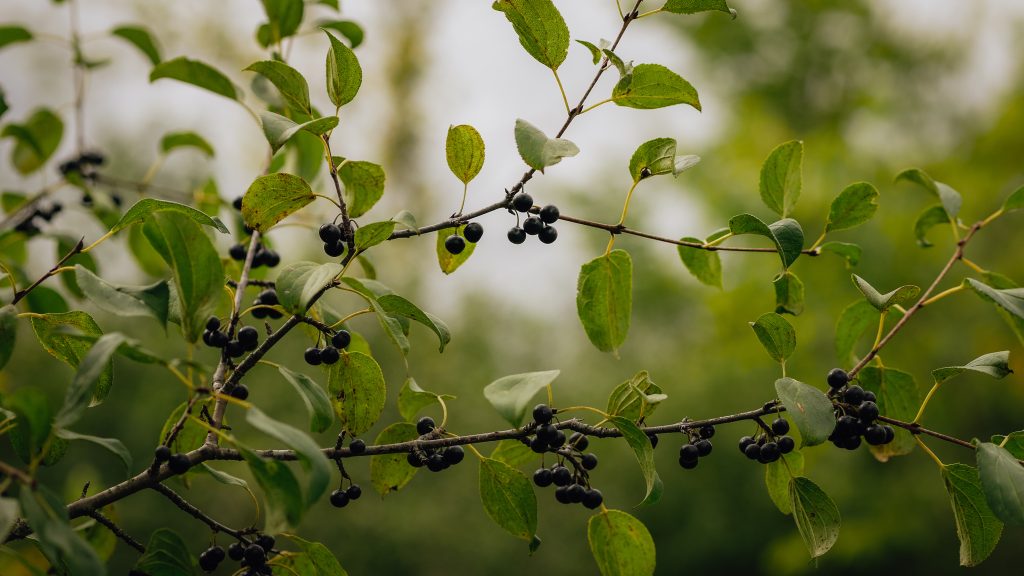
Description of Buckthorn:
Buckthorn’s main stem is erect, with bark smooth, of a blackish-brown colour, on the twigs ash-coloured. The smaller branches generally terminate in a stout thorn, giving it the name Buckthorn. There are many older names by which this shrub has been known: Waythorn and Highwaythorn. The leaves grow in small bunches, mostly opposite. They are egg-shaped and toothed on the edges, small greenish-yellow flowers are produced, which are followed by globular berries about the size of a pea, black and shining when ripe, and each containing four hard, dark-brown seeds.
Medicinal Action and Uses of Buckthorn
Laxative and cathartic.
The berries are used medicinally, collected when ripe and made into a syrup of Buckthorn, which was used as an aperient drink.
Until late in the nineteenth century, syrup of Buckthorn was a most favourite remedy, used as a children’s laxative, but its action was so severe that, as time went on, the medicine was discarded. It is now used almost exclusively in veterinary practice only, being commonly prescribed for dogs, with equal parts of castor oil as an occasional purgative.
Nature’s Wildlife Highway
Buckthorn was brought here with the European settlers as an ornamental bush and to line fencerows. Keeping livestock in and to serve as much needed windbreaks for the newly cleared land. Some people may only see Buckthorn when they look at these old hedgerows, but there, amongst their midst, if you look much deeper you will see the Birch, Wild Apple trees, Maples, Mountain Ash, Basswood, Aspen, Puff balls, Morels and blankets of our beloved woodland flower, the Trout Lily – which takes over seven years to receive her first bloom!
The hedgerows on our farm are over one hundred and twenty-five years old, deep within the bushes and trees are the remains of old rotting cedar zig zag rail fences, that once marked the property boundaries. These rails now offering homes for small critters and insects, slowly decomposing and feeding the soil, and nurturing the surrounding plant life. These fencerows provide wildlife with shelter and food, and well used trails for safe travel. Connecting the travelers to other fence rows and more trails. We can’t forget the help these hedgerows gift our pollinators as well, with over thirty Wild Apple Trees — all a blossom in the spring and a buzz with life. Providing rich pollen and nectar that our bees use for nutritious food and to make their honey. Many of these old fencerows are being cleared on neighbouring farms. Cleared for more workable land and giving the huge farm equipment of today more room to maneuver with ease. Saving the farmer’s valuable time, but at what cost to our wildlife?
Do I dare disturb this delicate ecosystem? Do I disturb the hidden trails within – taking the safety from the Deer, Coyote, Fox, Wild Turkey, Lynx, Fisher, Bear, and many other creatures who frequent these paths. Buckthorn has been a crucial part of the hedgerow, nurturing the young trees and plants. With connections like these the decision is easy, my intuition has always known, the Buckthorn filled fencerows will NOT be disturbed in any way.
This is my heartfelt commitment to this land.
“Look deep into nature, and then you will understand everything better.”
~ Hans Christian Andersen
Photos Provided by Serena Mor
An Interview with David Winston
This interview was conducted as part of Everything Herbal’s ‘Herbal Elders’ series. This series seeks to honour and explore the unique contributions of longstanding members of the herbal medicine community in Canada, as well as abroad.
This interview was originally conducted with Nick Faunus, Penelope Beaudrow and Victor Cirone, in July, 2022.
Reciprocity in herbal medicine
Everything Herbal: I’d like to begin our discussion by considering the place of reciprocity in herbal medicine. What can you tell us about this?
David Winston: Let me start off with a story and introduction. This year I’ll have been studying herbal medicine for 53 years. I started studying herbal medicine in 1969 and at the time all of my friends were interested in one herb, and I was interested in all of the others. Fascinating how today the interest in that one herb has grown tremendously, but I’m still primarily interested in all of the other ones. In 1969 there were no real herb schools, it was hard to learn about herbal medicine. People would say to me what do you do? I would say I’m an herbalist and people would look at me like I was an alien from another planet coming to abduct them. Why would you waste your time with something people did 100 years ago? I fell in love with plants and herbs, with being able to walk out in the woods and the fields and find medicinal and edible plants. My early learning came from a number of sources. Some of it came from books, I would read any book I could find on the topic, and at the time there weren’t that many. One of my first books was ‘Stalking the Wild Asparagus’ and then ‘Stalking the Healthful Herbs’ [both titles by Euell Gibbons] and ‘Back to Eden’ by Jethro Kloss. In reading these books, I was being handed knowledge of the generations, knowledge of our ancestors. And then I started looking for people that I could learn from. And it was difficult. I took a couple of classes from Dr. Christoper probably in the early to mid 70s. One of my friend’s fathers came to America from Germany and was really into organic gardening and farming, which he taught me. I had another friend in high school whose mother had studied Chinese cooking. I knew how to bake and we taught each other. This is one of the things that initially peaked my interest in Chinese herbs, learning to use them in a culinary way.
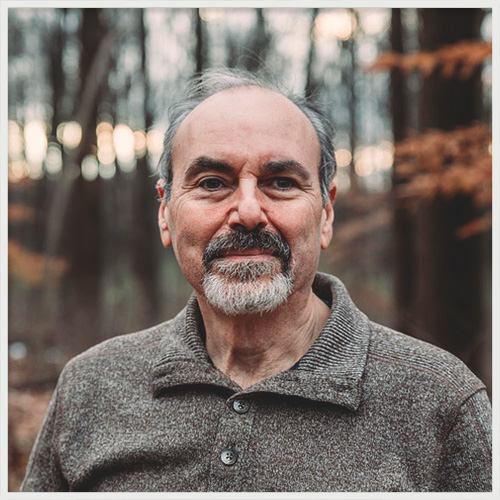
Reciprocity was built in – the fact that much of what I learned early on was not necessarily from a school where I was paying for the information. I remember one time we went to the World’s Fair in Montreal when I was a kid. My parents decided we were going to go for a little vacation up into Northern Quebec. It was a memorable trip. This was at a time when there was a fair amount of anti-English sentiment, which we didn’t know about until we arrived there. My mother did speak a little bit of high school French, but not Quebecois. Most of the time we would go into places and they wouldn’t talk to us. It wasn’t a question of whether they understood English or not, because as soon as they recognized we were English speakers they ignored us entirely, like we weren’t even there. We went into this one store, a general store, and they had horehound candies. I had never had horehound before, but I had read about it. So I had to get them. I put one in my mouth and within 10 seconds I spit it out, it was the most disgusting thing I had ever tasted in my life, or so I had thought at that moment. Interestingly enough, an hour later I wanted to try another, which I was able to keep in my mouth for 30 seconds. And by the end of the day I liked them. It was a gradual process of getting acclimated to the flavour. The guy at the counter noticed I bought these and was trying them, and he said to me in English, ‘are you interested in plants?’ I told him that yes, I was deeply fascinated. He started telling me about his favourite herb, a plant he called black snakeroot. I had no idea what it was he was talking about, he didn’t know any Latin binomials. He had a little bit of this herb, let me smell it and gave me some to taste. Many years later I realized that what he called black snakeroot I would call wild ginger, Asarum canadense. It was one of those experiences of recognition and generosity, facilitated by the plants. This happened even though I spoke English and he primarily spoke French. What made the breakthrough was plants.
I feel so fortunate to have been studying herbs for 53 years, and to have been in clinical practice for 45 years. I’ve got to spend almost my entire life in this community of people who love plants. For a very long time I thought I was the only herbalist in the entire Eastern US. It turns out I was wrong, but the majority of the other herbalists who I later found out about were often folk herbalists in rural communities, well known in their own communities but not beyond that. People like Evelyn Snook in central Pennsylvania, or Catfish Gray in Virginia, or Tommy Bass in Alabama. There were other herbalists too, they just weren’t particularly well known. I grew up in Maryland but we had moved to New Jersey, and there was a woman in Rahway, NJ, Henrietta Diers Rau, who I never got to meet but I found her wonderful but somewhat obscure book, ‘Nature’s Aid’ in the library. Henrietta trained at the British School of Phytotherapy in the UK, she was a practicing herbalist, not very far from where I lived. Some years later, in 1981, the first major US herb conference took place in Breitenbush Oregon, organized by Rosemary Gladstar and California School of Herbal Studies. At that time I was the only herbalist there from east of the Mississippi river. I remember sitting in this large room, in a semi-circle with 69 other people, sitting on the floor, looking at all these faces and realizing: these are my people. It was such an incredible experience to feel a part of something.
“…So many herbalists live truly inspired lives”
If we go back 40 or 50 years, being a herbalist was not something that was widely known, appreciated, or in any way accepted. If you told your high school guidance counsellor that you wanted to become a herbalist, they would have looked at you like you had lost your mind. The reality is that people who took up this work were very isolated, but eventually as we got to know each other, we found out there was an amazing community of creative, curious and interesting people working with plant medicine. So many people in the herbal community were multifaceted and amazingly talented. Our herbal elders, some of whom are no longer with us. Michal Moore, for instance – he was a classically trained musician, and performed on wind instruments in the LA symphony orchestra. Michael Tierra is a concert pianist. Jillian Stansbury is a polymath, she is brilliant in so many ways; she is a musician with an incredible voice, and for fun in her spare time she studies things like quantum physics. It is such an interesting group of people: poets, artists, musicians, as well as herbalists, and I think that speaks to the heart of many herbalists, to the fact that so many herbalists live truly inspired lives. Nobody gets into herbal medicine because they think they are going to become rich and famous. That’s not the motivation. There are people who become well known and make a good living, but that is not the underlying motivation. To a great degree, people fall in love with plants and with the idea of helping others, and that is the real motivation.

Even though I’m not in full time practice anymore I still see patients. I haven’t charged people for helping them since sometime in the 1980s. I just help people. It seemed it was not right to charge people to make money off of their suffering. I’m not trying to suggest that it is wrong for others to charge for their services. My income comes from teaching, writing books, consulting with physicians and industry. When somebody comes to me and they say ‘I need help’, I just help them. For me that is a big part of reciprocity. So much of what I have learned over half a century was shared with me freely and I love sharing it with other people. Whenever I can, and whenever people are interested I’m always happy to share what I have learned. You know the old expression: we stand on the shoulders of giants. It’s true. So much of what I know comes from traditional Chinese medicine, from Southeastern traditions in America, the Eclectics, the Physiomedicalists, from the practices of Ayurveda and Unani-tibb. These traditions are 100s or even thousands of years old. They all inform what I do and what every other herbalist does. Nobody discovered all of the things that St. John’s wort can do by themselves. It has been a gradual process of disclosure taking place over millennia. As we use herbs in clinical practice, we gain unique insights and share them and our collective knowledge just continues to grow. This too is reciprocity. I see so much of this in the herbal community: reciprocity, generosity, creativity. And those are wonderful things to have as a foundation for a community of people who are in most cases trying to make a difference in the world by making people’s lives better.
Accomplishments in the world of herbal medicine
Everything Herbal: What would you identify as some of your major accomplishments in the world of herbal medicine?
David Winston: The greatest thing that I personally have done as a herbalist is in the area of education. As a practitioner, there are a lot of people I have worked with and helped. Sometimes people say: ‘you’re a healer.’ I’m not, the herbs are the healers, the Creator is the healer, I’m not a healer. At best, I’m an educator. Whether I’m educating on a one to one basis in my role as a clinician or educating students about the wonders of herbal medicine, it’s a deeply fulfilling role. I may be giving an herb walk and sharing with people who may have never been exposed to herbal medicine before, or lecturing to my two year herb studies program, where thousands of people have studied. The program is designed to teach people to become clinical herbalists. Half of the students who come into this program are already medical professionals, MDs, NDs, DOs, nurse practitioners, acupuncturists, veterinarians, and other health care professionals. The other half of my students are people who have been self studying herbal medicine for years or even decades and they really want to improve their skill level so that they can help people in more profound ways. Adding herbs to your toolbox, so to speak, makes a huge difference. It’s not that herbs can do everything – they can’t. But where herbal medicine is strong tends to be where orthodox medicine is weak and vice versa. When I say herbal medicine, understand that in my view herbs are not foundational. What do I mean by that? The foundations of health are a healthy diet, adequate good quality sleep, exercise, healthy lifestyle choices, and stress reduction. Those are the foundations of health. Any herbalist or any practitioner of any sort that is not working with all of those things is missing the boat. Nobody ever became sick because of St. John’s wort deficiency. The idea is that we want to do everything we can to help people. We start with the foundations of health, and when we get to therapeutic modalities herbal medicine is incredibly useful. Most herbs are relatively nontoxic, there is a fairly low rate of clinically significant adverse effects especially if you know how to use herbs appropriately.
“It is more important to know the person who has the disease, than the disease the person has” – Hippocrates
In my first two year herb studies program I had two students. That was in 1981. I was thrilled that anybody else wanted to learn about medicinal plants. Today we have students from all over the world. My goal in teaching people is not to teach them to be good herbalists; my goal is to teach them to be great herbalists. When I say great I don’t mean as a comparison to someone else, I mean each person in their own unique way. Each of us is capable of greatness based on our unique knowledge, intelligence, skillset, passion, creativity; each of us has the ability to take this information and do unique and wonderful things with it. But I also believe that if you really want to be a great herbalist, then there are a few things you have to understand and the first thing is to stop focusing on treating disease. Hippocrates is believed to have said more than 2000 years ago: “it is more important to know the person who has the disease, than the disease the person has”. He was right then and he’s right now. What he means by that is if you have 5 people, all diagnosed with rheumatoid arthritis, the treatment for each will be based upon their unique requirements as individuals. From an orthodox medical perspective the treatment for a given disease seen in different individuals is often the same. As an herbalist, I look at 5 unique people. Yes they all have rheumatoid arthritis, some are female, some are male (hormonally speaking), some are old and some are young, some have underlying GI issues, some have circulatory issues, some have cardiovascular issues, and the more you can treat the person who has the disease, the more effective your protocols are by far. If you have somebody with bacterial meningitis, don’t call the herbalist, reiki healer or chiropractor. You want them in the hospital with iv antibiotics. It is not about creating a dichotomy between orthodox and complementary medicine. They both have their strengths and weaknesses. The key is helping students to understand how they can most effectively help people.
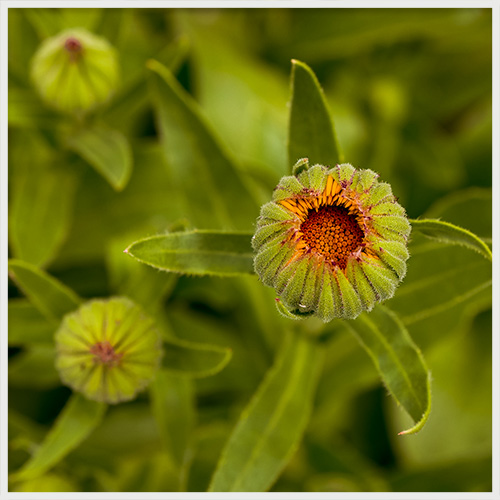
46 years ago I was introduced to the concept of energetics by one of my early teachers who in my opinion is one of the great herbalists of the 20th century: William LeSassier. William is the person who introduced me to herbal and human energetics, which allows the practitioner to match specific herbs to the person. When you focus on the disease, you are missing out on the energetics and the constitution of the patient, which is required if you are to treat the person. William also introduced me to Chinese medicine and Chinese herbs, as well as a lot of obscure western herbs like evening primrose. Everybody who is reading this is probably is saying ‘evening primrose seed oil, I know about that.’ But I’m not talking about that, which I don’t think is even all that useful. I’m talking about the herb Evening Primrose (Oenothera biennis), the leaf, flower or root bark. It is a common native weedy plant, it is an incredible medicine used for things like GI-based depression and inflammatory bowel disease, it’s a wonderful medicine that almost nobody knows about. I credit William again with changing my mind and my entire direction in herbal medicine. Before what I had encountered was along the lines of: this herb is good for headaches, this herb is good for depression, etc. You see this all of the time with these little soundbites of information about herbal medicine that get circulated in books, classes and the internet. For example, St. John’s wort is the depression herb, Saw Palmetto is the prostate herb, or Black Cohosh is the menopause herb. There is one problem with each of those statements: they are wrong, wrong and wrong.
Take St. John’s wort: when I teach on the differential treatment of depression and anxiety, we differentiate more than 14 types of depression based on the underlying pathophysiology. When you treat a person who is depressed, you need to understand what is actually causing the depression. Is it GI-based depression, inflammation-induced depression, old age- induced depression, blood sugar dysregulation-induced depression? The studies show that most pharmaceutical medications like SSRIs and SNRIs work about 40% of the time. St John’s wort also works about 40% of the time if you just give it for the disease entity depression. But if you actually treat the person who is depressed, I can say from my own clinical practice (there are no studies on this) 60 – 65% of my patients with mild to moderate depression have very significant improvements, even to the point where they don’t feel they are depressed at all anymore. This is huge when compared to 40%. Is it perfect? No, but the point is that we have a significant improvement when we are treating the person rather than the disease.
“…That we have helped to teach people how to be great herbalists, is something I’m very proud of.”
For me I think the accomplishment I am most proud of is to be able to look around and see a much bigger herbal community than existed when I first started. People who have been part of my programs are a piece of that, and to know that we have spread that information, that we have spread that knowledge, that we have helped to teach people how to be great herbalists, is something I’m very proud of. Today I look around the world and there are people who have graduated from my program who have their own schools, who are well known herbalists that have written many books, who have these incredible practices. Of course it is not just because of my program that they accomplished these things, it was just a piece of their development. But the fact that I can help people with that one piece to me is a blessing. It makes me very proud to be a part of this community and to continue to pass on what I have learned, to share it and have our traditions continue.
“In the US we spend more money per capita on healthcare than any other country in the world”
Some years ago I was the keynote speaker for a conference called the Florida Herb Conference, organized by Emily Ruff, a wonderful herbalist. I called my speech ‘I Have a Dream.’ I started off by saying ‘you’ve heard these words before by someone far more eloquent than I, but I have a dream too, and my dream is that within my lifetime I hope to see a time where almost every mom, dad, grandmother and grandfather knows basic kitchen herbalism for their family, where there are community herbalists in every community and clinical herbalists available in any clinical setting.’ Why? I believe without a shadow of a doubt, and I’m talking now about the US, (in Canada things are a bit different) in the US we spend more money per capita on healthcare than any other country in the world yet we have worse health outcomes. We are behind every developed country when it comes to infant mortality and life expectancy. We are close to the top when it comes to obesity and cancer, but in all of the health measures that you want to be good at, there are many underdeveloped countries that have much better numbers and outcomes than we do. I believe that really well done herbal medicine can help us create a sustainable practice of medicine not only in the US but around the world. There are countries like India, China, Japan, even Germany where herbal medicine is part of mainstream medicine and it allows them to have a more effective medical system with fewer adverse effects and a greater number of options. That’s my dream. That’s my goal. To make this not alternative, but a part of the mainstream, not just mainstream medicine but mainstream understanding and knowledge. I hope that at some point everybody knows basic herbs to use for common ailments. Most people already know that if you are constipated you can take prune juice or that you can use aloe for a burn. There are lots of things like that that people could learn and use at home, thereby preventing for example the unnecessary use of antibiotics. Antibiotic resistance is a huge problem today. How many times could we give somebody antibacterial herbs for a UTI and thereby avoid having to use antibiotics altogether. How many times do we see people being given antibiotics when they have a viral infection and they don’t work at all? Yet we have herbs that would be perfectly appropriate in that situation. Are herbs the answer to everything? Absolutely not. Are they an answer that can help us to create a better practice of medicine, one that is better for the planet and better for the people and animals on the planet? Without a doubt.
“As a clinician one of the greatest gifts that you can give yourself is to keep an open mind.”
Everything Herbal: I’ve been fortunate to go to many herbal conferences over the years and have heard so many speakers. Out of all the speakers I have listened to, I can still see you on our stage at the Restorative Medicine Conference. I was in the front row doing the introductions and you opened for us. You sang a song, and even though I had no idea what you were singing, it penetrated my soul and made me cry instantly. To me in that moment, and even now reflecting back after all of these years, it was a profound healing experience. I still even get emotional about it because I have no idea what happened in that moment, but I know that something happened. You were the portal for something awe inspiring to come through, and it was a great gift.
David Winston: As I said earlier, I think that the plants are the true healers but many people in the herbal world have gifts that go beyond herbal knowledge. Many are inspiring, wise, and stewards of the green world. In addition to being an herbalist, I write poetry, I sing, I garden and love photography. These things bring me pleasure and help me to see the world in a different way and express myself creatively. I always wished I was better at visual arts. Unfortunately I’m not a very good artist, although both of my parents were very good artists. I have some significant visual, hand/eye coordination issues. I was born severely visually impaired and I didn’t actually see until I was about 18 months old. I had 3 surgeries on my eyes by the time I was 5. There are certain things that I just don’t do as well as most people do. When I was a child there was no diagnosis of dyslexia, or ADHD, although I would have been diagnosed with both if I was born 15 years later. People think of them as disabilities, and they are challenges for sure. But they also bring unusual strengths and skills if you are fortunate enough to have the necessary help navigating the differences. I was talking about this before when I talked about being great in our own unique ways. I don’t consider myself great in any particular way but I am striving to be the best that I possibly can be in every single thing that I do. Now obviously I fail more than I succeed but you keep trying, you keep trying to grow and become a better person, clinician, parent, friend or partner.
As a clinician one of the greatest gifts that you can give yourself is to keep an open mind. I always tell my students the worst disease a practitioner can get is what I call “hardening of the mind”, where you start to believe that everything you know and think is true. I am partially kidding when I say this, but I always tell people after 53 years of studying herbal medicine I now feel comfortable calling myself an advanced beginner. Why? It doesn’t matter how much you know, it is still a fraction of what there is to know. You always want to stay open to the process of continuing to learn. This is true for anybody, whether an auto mechanic, a scientist, a farmer, a physician, an herbalist or an artist. It is openness to creativity, to new ways of seeing, thinking or being that allows us to grow professionally and as human beings. How many examples do we have of musicians who become famous for a certain style and their next album comes out and its totally different and their fans don’t like it. But as an artist, there is something that pushes you to grow and experiment. To stay stagnant and just keep doing the same thing over and over and over again doesn’t serve that purpose and ultimately doesn’t serve the art. As an herbalist or as a clinician you have to stay open minded to the fact that everything you believe is true is subject to change. That doesn’t mean it will change, but it could. When we get dogmatic and when we start allowing ourselves to be put up on a pedestal, we are in dangerous territory. If you are up on a pedestal and everybody is looking up at you, invariably you are looking down, its an uncomfortable place to be. Something about human nature is that while people love putting others up on pedestals, they also love tearing them down.
“… Recognize that the plants are the healers.”
It is important to stay humble, to recognize that the plants are the healers. Art, music and creativity are also great healing forces. So is vulnerability. Recently in class a student asked a question and it was about somebody going through a really hard time. I didn’t say to them ‘oh you should do this and that’; instead, I allowed the experience that was shared to touch me, just like that song touched you. The experience of suffering that was related in class touched me deeply and reminded me of an experience in my own life. It was a very humbling experience; being able to share vulnerability and fragility with others allows people to recognize and connect in to their own pain, their own suffering, their own fears, their own doubts. When we can do this, we begin to recognize that we are not alone in our sufferings, and not alone in the world. In any traditional form of medicine, there is no separation of body, mind and spirit. Of course, there are times when you have a simple wart and I don’t need to know what’s going on with you emotionally. I can simply say, ‘here try some celandine, put it on twice a day’ and more often than not the wart will disappear. But if we are talking about more serious health issues like depression, anxiety, autoimmune disease, cardiovascular disease, all of these conditions don’t just affect the body, they also affect the mind, the soul and spirit too. All of these levels are deeply interconnected, they are all part of the same organism.
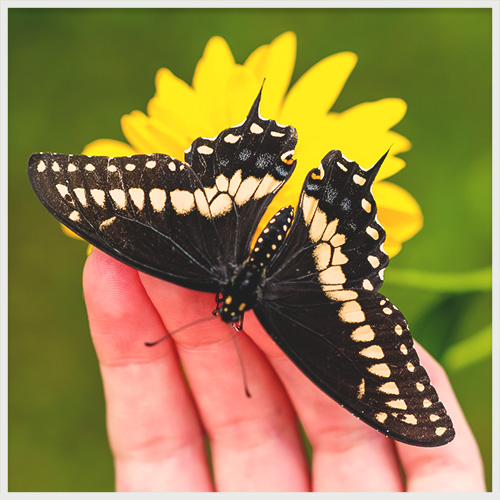
This is also where complementary medicine can fall short. There was a diagram created by Kenneth Pelletier in the 70s of three interconnected circles labeled body, mind, and spirit. That is supposed to represent holism. There is only one problem with that: it is not big enough. If you put a big circle around those three interconnected circles, that circle is family. Then there is another even bigger circle around that, and that’s community. And then there is yet another circle around that, and depending on what name you want to give it, that’s God, the Creator, Nature, Gaia, whatever concept you want to put in there. What the body/mind/spirit level of the diagram recognizes is that we are interconnected within ourselves, but what it fails to recognize is that we are also connected to everything else, to everything outside of ourselves. When I teach my class on depression, one of the things I always tell people about depression is that it can be a learned behaviour. If you grew up in a household where one of your parents was chronically depressed you stand a 50% chance of being chronically depressed yourself. If you grew up in a household where both of your parents were chronically depressed you have about a 100% chance of being chronically depressed. As an infant and young child you don’t know what is healthy behaviour and how things in the world can or should work. Whatever behaviour that is modelled for you becomes your norm. If the people around you are always depressed, always anxious then that is what you come to believe is normal and desirable.
“To feel that you have a place in the world, to feel connected is essential to health and wellbeing.”
There is also a part of the brain known as the mirror neuron network. If, for example, your significant other is chronically depressed or anxious, the chances of you becoming chronically depressed or anxious skyrockets. Why? Because this part of the brain which allows us to feel empathy, sympathy and connection to others, triggers deep feelings and emotions in us that are indistinguishable from our actual emotions. For most of us when we see somebody who is suffering and we feel it, not just ‘oh that’s too bad’, but when you really feel it ‘oh my god thats terrible’, you want to help and do something. That is the part of the brain that mirrors the behaviours of others, and if you are in a relationship or even living in a place where other people are experiencing those things on a regular basis, it is very hard for you not to respond and get pulled into that mindset, whether it is anxiety or depression or hopelessness. We are deeply affected by others, and in many indigenous traditions if somebody is ill you don’t just treat that person, you treat their entire family. The next circle after family is community, and so many of us no longer live in functional communities. We are isolated and separated, and this causes major issues for human beings, who are innately tribal. By using the word ‘tribal’ I do not necessarily mean a native nation, although that is certainly tribal. I certainly don’t mean the terrible tribalism that we have in the US: red vs blue, liberal vs conservative, etc. That is tribalism at its worst. What I mean is that we feel the need to belong. Unfortunately that seems to be one of the appeals of so many of these hate groups that are out there now. You have people who don’t feel like they belong anyplace, who feel like outcasts and feel scorned and belittled by society. Often, they find acceptance and comradery in such movements and they get caught up in a group that is bounded by hatred. To feel that you have a place in the world, to feel connected is essential to health and wellbeing. I talked about it earlier when I was describing sitting in a room with 69 other herbalists at a young age and feeling that I had finally found my people. Being able to find others who accept us for who we are, and participating in a functional, healthy community; this is unfortunately so rare in today’s world.
“You are part of something bigger than yourself”
The last circle, relating to one’s relationship to a higher power (again, whatever name and concept you have of this is fine), helps us to recognize that we are a small part of something much greater than ourselves, something that pulls us out of our ego, pulls us out of our fear, doubt, isolation, separation and out of our belief that the world begins when we are born and ends when we die. This perspective reminds us that yes, each and every one of us is sacred and blessed and yet each one of us is a speck of dust. We are both magnificent and insignificant at the same time.
This is the importance of having a spiritual practice, whether you have a religion or not. The connection to a higher power is the essential piece. If you don’t believe in an entity, you can achieve the same thing through Nature, Gaia, it doesn’t matter, as long as you believe you are part of something bigger than yourself. That is a really useful and helpful orientation for human beings to have; it is arguably what allows us to become human beings in the first place. If you ever go some place where there is almost zero light pollution, and I’ve been to places like this in the mountains of North Carolina or in parts of Canada, New Mexico, Maine Ireland and Costa Rica, and you look at the night sky it can be breathtaking. Instead of seeing a few bright stars or planets, you see the entire milky way. Sadly many people have not had this experience today. When you look up at such a sky it is magnificent, you enter into a state of awe. It makes you feel so small but at the same time connected to something so vast. To me that is the power of healing, those moments that literally take your breath away where you’re just in awe that the world is so magnificent, so beautiful. For many of us that experience is so far away from our daily lives, and we lose sight of it, we lose sight of the joy and the newness and the discovery and the wonder of the world that we were born with as children. For many people today, the world is not a place of wonder. It is a place of fear, hurt, prejudice, or inhumanity. I think that herbs, nature, meaningful ritual, forgiveness, compassion and love can contribute to the healing this core wound of disconnection that many of us suffer from today.
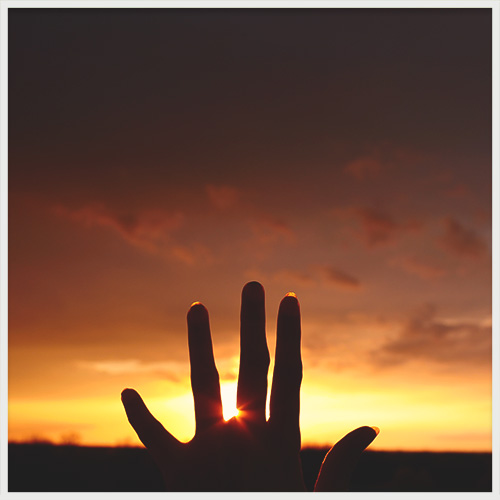
“Originally I was going to be a farmer…”
When I was in high school I used to have an organic farm. It started off as a 20 or 30 by 80 foot plot and eventually I got more land down the road. I had two acres and a roadside stand where I sold organic vegetables in the summer, in the late 60s and early 70s. Originally I was going to be a farmer, I was growing herbs and vegetables, and the one thing I didn’t grow was flowers. I thought who cares about flowers. Today I realize I was mistaken. While I still grow many herbs and vegetables, today I love flowers. And three of my favourites are fragrant roses, irises, and peonies. The irises I grow are old fashioned fragrant irises. The modern ones often have no odour, but the old varieties are really fragrant and they almost smell like a combination of cinnamon and bubble gum, a very unusual combination. Every year, when the irises start blooming I go out every single day and stick my nose in those flowers and just inhale deeply. Think of it as primitive aromatherapy. When the peonies are in flower, I go out there and I smell them too. The roses start blooming before any of the others and continue blooming in through the autumn. When I go out and smell these flowers I am so uplifted by their odours. Yes the night sky in a place where there is no light pollution is spectacular, but smelling a fragrant rose is also magnificent. Smelling one of those fragrant irises is magnificent. Magnificent things, healing things can be huge things that literally stop you in your tracks, as well as little things that for a moment bring you back to a place before you were weighed down with all of your worries, to a simpler, better place of healing.

Let’s talk a bit more about the integration of herbal medicine with the conventional medical system…
Everything Herbal: …It’s an important issue that many people don’t think about in a lot of detail. It seems like such a distant possibility. What are some ways that this might come about? What are some steps that practicing herbalists can take to do what is necessary to get to a point where the practice of herbal medicine is widely accepted, integrated, and thereby helping a greater number of people?
David Winston: Often in the herbal/alternative/complementary medicine community there is an attitude of us vs them. Tribalism, not the good kind. The mentality is that the medical establishment and the pharmaceutical industrial complex are out to get us. Granted, pharmaceutical companies are not big fans of herbal medicine because it certainly cuts into their profits. Between 1995 – 1998, many of the big pharmaceutical companies jumped into the herb market and came out with their own lines of herbal products. Within a few years they all dropped it, they realized there was simply not enough money to be made no matter how good their products were. It wasn’t close the level of profit that they got from their pharmaceutical medicines. It is true that orthodox medicine is not necessarily open to herbal medicine, but my belief is that mostly what we are dealing with is a lack of knowledge. Doctors go through this incredibly rigorous training over so many years, and when they graduate they have limitations depending on what state in the US they are practicing in. There are regulations, as well as insurance and liability issues, that keep people in their own little silos. Firstly, if we are to think about this issue, education about herbal medicine is vital. During the period between 1995-1998 herbs were hot and they were in the media all of the time. I was getting 4 or 5 phone calls a week from physicians saying ‘you know I’m interested in these herbs, I want to learn more about them.’ The media has this tendency where if something is wonderful then eventually the pendulum turns and it becomes something of suspicion. And sure enough, around 1998 we started seeing all of these articles both in the medical literature and in the popular press about herbs being dangerous.
“…One of the things that happened was that more people who were taking pharmaceutical medications were taking herbs simultaneously.”
With the increase in the use of herbs during this period one of the things that happened was that more people who were taking pharmaceutical medications were taking herbs simultaneously. There were legitimate reports of problems like herb-drug interactions and adverse effects. For example, St. John’s wort, which is a very useful plant for many different health issues, but is also the “poster child for herb-drug interactions”. That is because St. John’s wort not only affects phase 1 liver detoxification via the CYP1A2 and CYP3A4 and CYP2D9 pathways, which are enzyme isoforms that the liver uses to metabolize and break down pharmaceuticals as well as environmental toxins. It is also because St. John’s wort affects phase 3 detoxification, which takes place in the kidneys and the bowel, via the p-glycoprotein (P-gp) drug transport system. The fact that St. John’s wort up-regulates and/or down-regulates both of these systems means that it can have a significant potential for interactions with some pharmaceuticals. The good news is that, with the exception of St. John’s wort and a handful of other herbs, herb-drug interactions turn out to be fairly rare and clinically significant events, meaning they can cause a dangerous interaction, are actually even rarer still.
This is not to say herb-drug interactions can’t happen, because they can, but the danger in most cases is overstated. When looking at herbal safety if we look at statistics, taken from American studies, the number of deaths from properly prescribed pharmaceuticals (not including overdoses) is between 95 to 120 thousand people per year. The number of Americans who die from over the counter, supposedly safe NSAIDs, is 17 to 18 thousand per year. The number of Americans who die every year from food, everything from food poisoning to choking to anaphylactic allergic reactions, is about 9 thousand. These are somewhat older statistics, they could have gone up or down a little bit within the last decade. The number of Americans who die from herbs, in the last year that we have any information about this, was 37. That was before Ephedra was banned, and almost all of these deaths were from Ephedra. Is this to say that herbs are entirely safe? They are absolutely not. But this statement needs to be put into perspective.
“We can divide herbs into three categories: food, medicine, and poison.”
Your food herbs are generally safe, unlikely to have significant adverse effects and they can generally be used in significant quantities. These are things like blueberries, cinnamon, ginger and garlic, but also mild gentle herbs like lemon balm, chamomile, hawthorn berry, etc. We are not talking about allergies, because with German Chamomile there is a report in the literature of a person who had very severe ragweed allergies having a cross-reactivity reaction to chamomile, developing anaphylaxis and dying. There is one case in the entire literature out of millions of cups of Chamomile being drunk every single day. For that one person Chamomile was not safe, but anyone can have an allergic reaction to any food, any drug, any herb, any cosmetic so that is a separate issue. Your medicines on the other hand are stronger acting, they are to be used with more knowledge and usually for a limited period of time. These are herbs like Goldenseal or Ephedra back before it was banned. You don’t just take these everyday because they are good for you. You take them because you have a specific medical issue usually under the guidance of a trained clinician. And then finally your poisonous herbs should be left alone and only used by clinicians who are trained to use them, they have the potential for overt toxicity. We can think of digitalis, for instance.
Understand that what we need to do is to really educate people, not just mom and dad, grandma and grandpa, but the medical profession as well. Medical doctors don’t get much if any training in herbal medicine. I do teach at a couple of medical schools, where they get a one class introduction to herbal medicine but even that is the exception. Most physicians have no information, and what they are reading in the literature often contains a lot of incorrect information. The literature is often based on fear, many of the purported herb-drug interactions are based on in vitro studies meaning it is done in a test tube or petri dish and those rarely pan out when we start doing in vivo studies (in a living organism). Then there are many things in the literature that are a single case reports, meaning one person took something and had a bad reaction to it. If that was a pharmaceutical that would never get into a journal. That happens all of the time and you cannot ascribe causality to someone taking something and having a reaction. The reaction could have occurred for many reasons, or it could be an idiosyncratic reaction. If it is an herb that someone has a reaction to however, that will get put into a journal. Then it becomes part of the literature, and it reinforces the view: ‘oh, see herbs are dangerous.’
“Where herbs are strong tends to be where orthodox medicine is weak and vice versa.”
As I said earlier, where herbs are strong tends to be where orthodox medicine is weak and vice versa. If you have someone with chronic skin problems who has been to 20 dermatologists and nothing helps, that is one of the places where herbs shine. If you have somebody with treatment resistant mild to moderate depression (severe depression is very treatment resistant no matter the approach), who has been given various SSRIs and they didn’t work or caused significant adverse effects, herbs can work beautifully there. Herbs are not only effective in many cases for prevention, they can be used in treating many issues where orthodox medicine offers few options. There are some major issues in medicine today, one of them I mentioned earlier is drug resistant bacteria. Most people have no idea that there are studies showing dozens and dozens of herbs that can be given with an antibiotic and it shuts down the multiple drug resistant (MDR) pumps in the bacteria allowing the antibiotics to become effective again. Herbs can work incredibly well in conjunction with orthodox medicine. The more we can get out there and educate people and share this information the better.
I would like to point out though that there are many issues holding us back in the herbal community. One is that most of us don’t know how to do research. As herbalists we need to learn how to do simple, basic but good research and start publishing the results. What happens in your office is interesting but that is empirical, it is not proof. In addition to herbalists learning how to do research, herbalists need to stop thinking in a silo and start reaching out to other practitioners. Throughout my entire career, I’ve always worked with other practitioners. I act as a consultant to over 100 medical doctors and naturopathic physicians throughout the US, Canada, and Europe, and I love that relationship. I learn new things all of the time in this role. I don’t have the answers to everything and they don’t have the answers to everything, so that kind of cooperation creates movement, it helps get the knowledge out of the silo into the mainstream.
“We need to start having a better dialogue within our own community.”
One last thing I’d point out about the herbal community, there is often a significant lack of consensus about what things mean. I remember Rosemary Gladstar saying ‘the only thing herbalists agree on is not to use aluminum cookware.’ She was basically right. One of my books is called ‘Adaptogens: Herbs for Strength, Stamina and Stress Relief’, the second edition came out in 2019 the first in 2007. There were several reasons I wrote the book. One is that I got tired of people calling herbs adaptogens that aren’t. I also thought it was really inappropriate that people were using this term adaptogen to mean whatever they wanted it to mean. I had someone ask me ‘why do scientists get to decide what an adaptogen is?’ It’s because they created the whole idea and concept! The word and concept of adaptogens didn’t come from TCM, or Ayurveda, or from the herbal community – the concept of adaptogens came from Soviet research starting in 1947. They get to define the concept because they came up with it. Adaptogens are not the same as a rasayana in Ayurveda, they are not the same as qi tonic or kidney yang tonic in TCM. There is some overlap, but an adaptogen is its own thing. There is a lot of sloppiness in my opinion especially when it comes to nomenclature and terminology in the herbal community. 10 herbalists will give you 10 different definitions of an adaptogen or even worse, an alterative. If we can’t even communicate amongst ourselves, if we can’t create a consensus about what our terminology means, it becomes very difficult to communicate to someone outside of the herbal medicine world. We need to start having a better dialogue within our own community. I’m not suggesting that we become homogenized in our thinking, I don’t mean that we all have to use the same herbs in the same ways. I’m not talking about standardization. But we do at least need a consensus on terminology, I believe this would be a very useful thing.
The funny thing is that with adaptogens, there are only 8 or 9 herbs that are actually well researched and fit the definition. There are another 5 that I’d call probable adaptogens, the evidence is weaker but suggests they may well be adaptogens. And then there are another 12 or more that I’d call possible adaptogens, where the evidence is actually very weak. As herbalists we need to up our game and come out and say ‘we have something worth knowing about’ instead of just sitting there saying ‘I’m just going to do my own thing.’ Anybody who is an herbalist knows they have something of value to share, so let’s make the work we do stronger, let’s continue to educate ourselves, let’s grow our knowledge, our community, and then bring it out into the world and say: ‘here is this incredible gift that we’d like to share with you.’
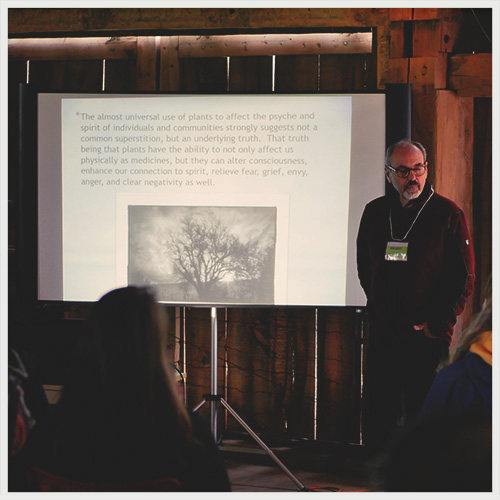
To conclude…
Everything Herbal: What is something heartfelt that you could share with new students or people who are just getting into herbal medicine? You speak of your love of herbs, but tell us about how this love shows itself.
David Winston: I don’t know if this is a direct response to your question, but I mentioned earlier that if I was born later I would have been diagnosed with both dyslexia and ADHD. I tend to get bored or distracted easily, unless a topic is deeply interesting to me and I can continue to learn about it. To me one of the blessings of herbal medicine, and this is true of medicine in general, is that as I said earlier I still only know a little bit of what there is to know. And I am just as enthusiastic and excited about herbs and herbal medicine today as when I first fell in love with plant medicines. The passion has not left me. When I am walking on a trail in the woods and I come across a plant that I’ve never actually seen before except in a photograph, it is just enthralling, it is like meeting my new best friend. It doesn’t have to be a showy plant. In the UK there is this plant called Pellitory of the wall or Pellitory on the wall. I have tried growing it here in the US and I’ve had limited success getting it to grow well and spread. It is used as a kidney trophorestorative, basically a food for the kidneys. I moved to my present home with my wife in 2014, and there is this plant I did not know growing on my property. I saw it multiple times and it wasn’t very showy, it’s green, you almost can’t see the flowers, and last year there was a great deal of it. I was going to go pull it up but then I thought to myself, I should look it up first. I discovered that it is called Pennsylvania Pellitory. It is in the same genus as the plant from the UK, but a different species. Immediately my reaction was ‘oh my goodness, it is growing right under my nose, and it really likes growing on rock walls just like the Pellitory of the wall in the UK!’ My questions then lead me to investigate, but I don’t have the answers yet. I found no ethnobotanical history of using this plant. Here is a relatively obscure plant with no history of use in the US, related to this English plant that I’ve wanted to use for years but haven’t had easy access to. So now I’m very excited and trying to find out any of the chemistry of the plant so I can compare it. I’ve tried tasting it (I do know it is not toxic!) to see if there is an organoleptic similarity, but unfortunately the English Pellitory is not very strong tasting or smelling. Now I am wondering if this can be used in a similar way to the other plant, and the answer at this point is that I have absolutely no idea. I don’t have access to phytochemical testing, so I have to see if there is any data or literature I can find, but the possibility of discovering an analog to an affective medicine makes me want to learn more.
People say if you learn something new it is a good day, and that is really true for me.
What can I learn today that I didn’t know yesterday, what new plant might I come across, what new use can I find for this herb or that herb, all of that to me is thrilling and I will continue with this work as long as I’m alive and mentally able. I have one of the largest private herbal research libraries in North America and I am constantly going back and looking at old books. I have books from the 1580s through to the present. I will take an old book off the shelf and be surprised by something I didn’t know, just as I can be surprised by some new research that comes out. The same can happen in class, when we are going over a case history and somebody says something that I didn’t know or think about before. It is just marvelous for me to be able to continue to learn. By continuing to learn, I am better able to share, better able to help others and hopefully in the process I contribute to making the world a better place for us all.
David Winston, RH (AHG) is an Herbalist and Ethnobotanist with 53 years of training in Chinese, Western/Eclectic and Southeastern herbal traditions. He has been in clinical practice for 46 years and is an herbal consultant to physicians, herbalists and researchers throughout the USA, Europe and Canada. David is the founder/director of the Herbal Therapeutics Research Library and the dean of David Winston’s Center for Herbal Studies, a two-year training program in clinical herbal medicine. He is an internationally known lecturer and frequently teaches at medical schools, professional symposia and herb conferences. He is the president of Herbalist & Alchemist, Inc. a manufacturer that produces herbal products that blend the art and science of the world’s great herbal traditions.
In addition, David is a founding/professional member of the American Herbalist Guild, and he is on the American Botanical Council and the American Herbal Pharmacopoeia Advisory Boards. He was a contributing author to American Herbalism, published in 1992 by Crossings Press, and the American Herbal Pharmacopoeia (AHP) , 2000-2018, the author of Saw Palmetto for Men & Women, Storey, 1999 and Herbal Therapeutics, Specific Indications For Herbs & Herbal Formulas, HTRL, 2014 (10th edition) and the co-author of Adaptogens: Herbs for Strength, Stamina and Stress Relief, Healing Arts Press, 2007 & 2019 2nd Ed, and Winston and Kuhn’s Herbal Therapy and Supplements; A Scientific and Traditional Approach, Wolters Kluwer/Lippincott, 2008. David has also published hundreds of articles in medical and botanical medicine journals and conference proceedings. He is also a member of the AHPA Expert Advisory Council that created the second edition of the Botanical Safety Handbook, CRC Press, published in 2013 (3rd edition in press).
In 2011 David was a recipient of the AHPA Herbal Insights award. In 2013 he received the Natural Products Association Clinicians award and was awarded a fellowship by the Irish Register of Herbalists. In 2018 he was the Mitchell visiting scholar at Bastyr University and in 2019 he was awarded an honorary DSc degree from the National University of Natural Medicine (NUNM) in Portland, OR.
You can find David online at davidwinston.org and his herbal training program available at herbalstudies.net
Photos provided by Serena Mor (excluding David’s first photograph)
Lady Slipper: A Gathering of Women and Plants
A Magical August Weekend…
So often we think of plant medicine as medicine for fixing and working on ourselves! But at Lady Slipper, the plants offered the medicine of connection, acceptance and appreciation.
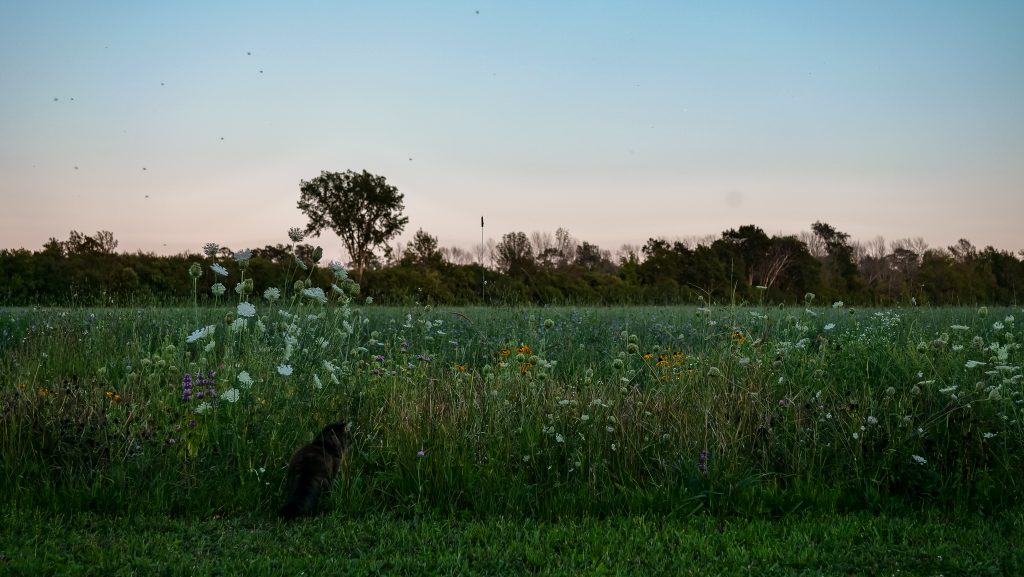
It was a beautiful weekend. The days were warm and sunny with a caressing breeze. The nights were bathed in the light of the waxing moon. The women came together to sing, laugh, share wisdom their bodies, plants and their hearts carry. The plants rejoiced in being seen and honoured. The food was delicious and nourishing. It was a beautiful weekend.
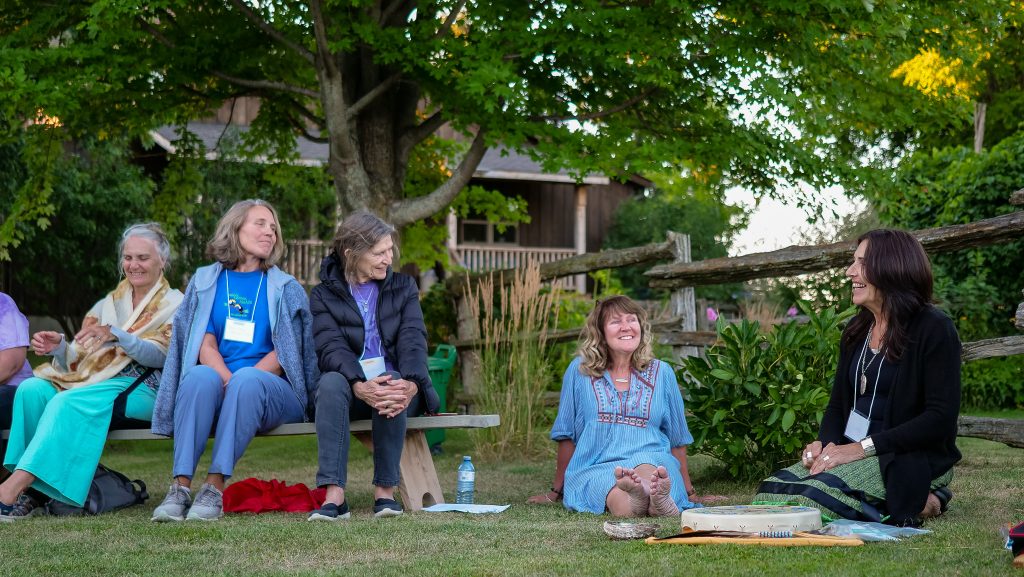
A gathering of women is a special time. It is a time to become more than a mother, wife, daughter, sister. It is a time to walk with the unique beauty each woman brings to the world. It is a time to swear like women swear, weep like women weep and talk like women talk. There was lots of talking and listening.
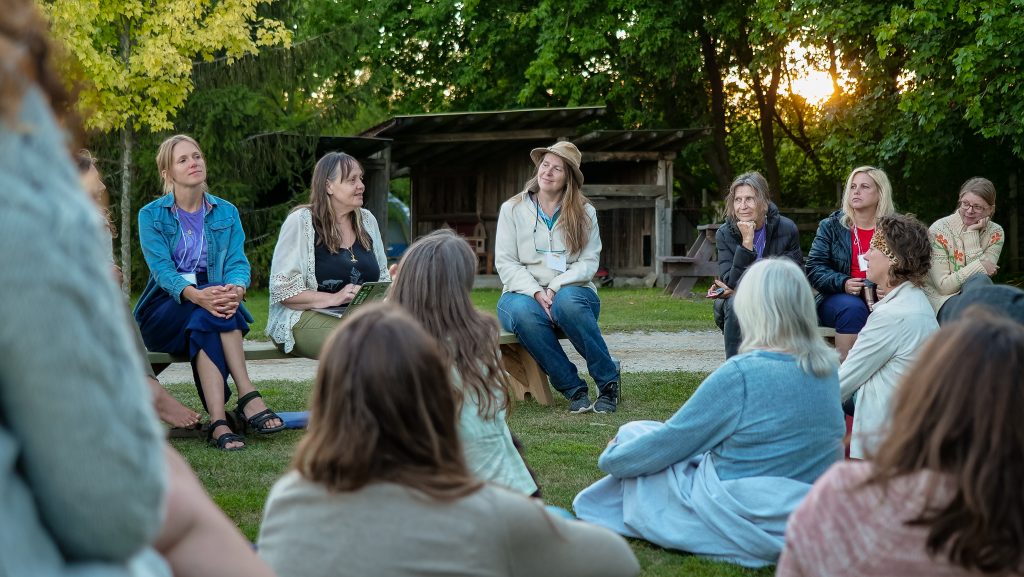
I remember walking by a picnic table where a group of women sat and overheard Laura Gilmore, a woman comfortable in the wilderness of the forest, explain how wolves move through the wilderness and porcupines perch in trees with their back to the world. The women at the table listened intently absorbing the knowledge of wild things.
Then there was Christine Denis’ erotic monograph of the Lady Slipper. With the lights twinkling behind her, Christine reclaimed dirty words used to describe female genitalia. In reclaiming these words, Christine banished the shame each women has been made to feel and returned the power and beauty of the female anatomy.
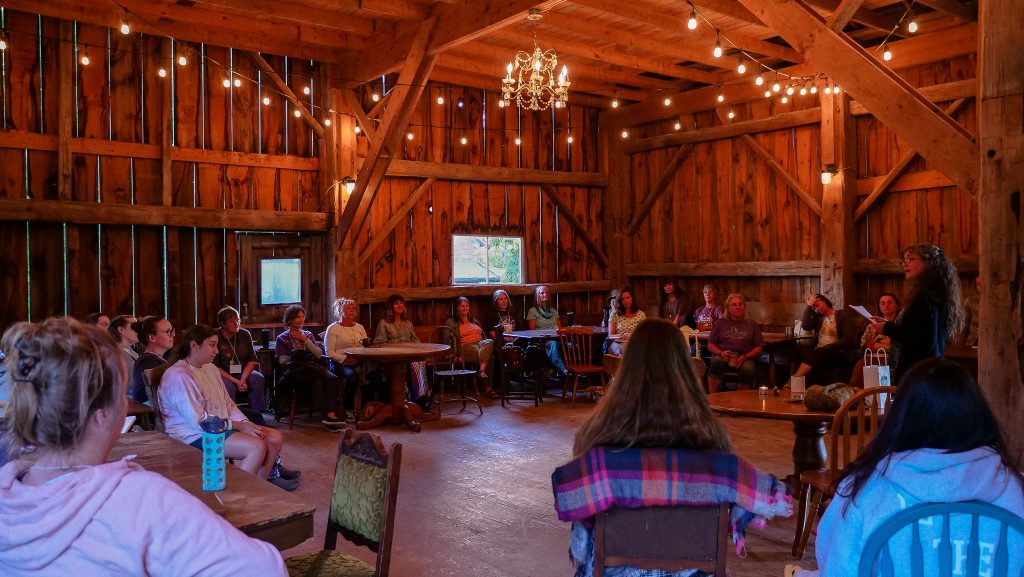
Penny Beaudrow in the meantime, created a safe place for women to connect with the earth. Laying on the ground, each women opened her heart to abundance of life with all its gifts and trials.
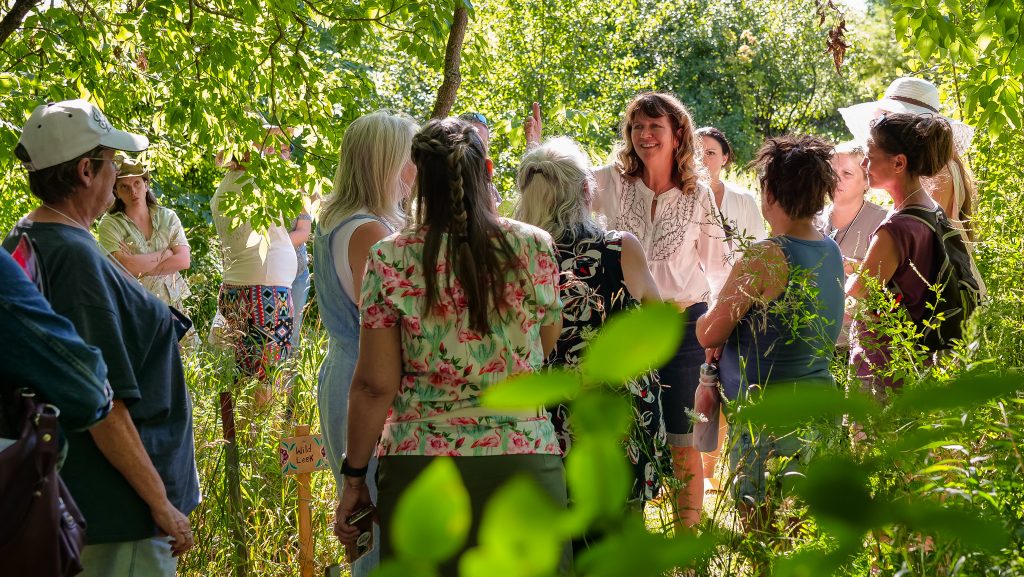
Lauri Hoeg offered each women an opportunity to name the medicine they are gifted. She showed them how to make a small pouch to help them remember the medicine they carry.
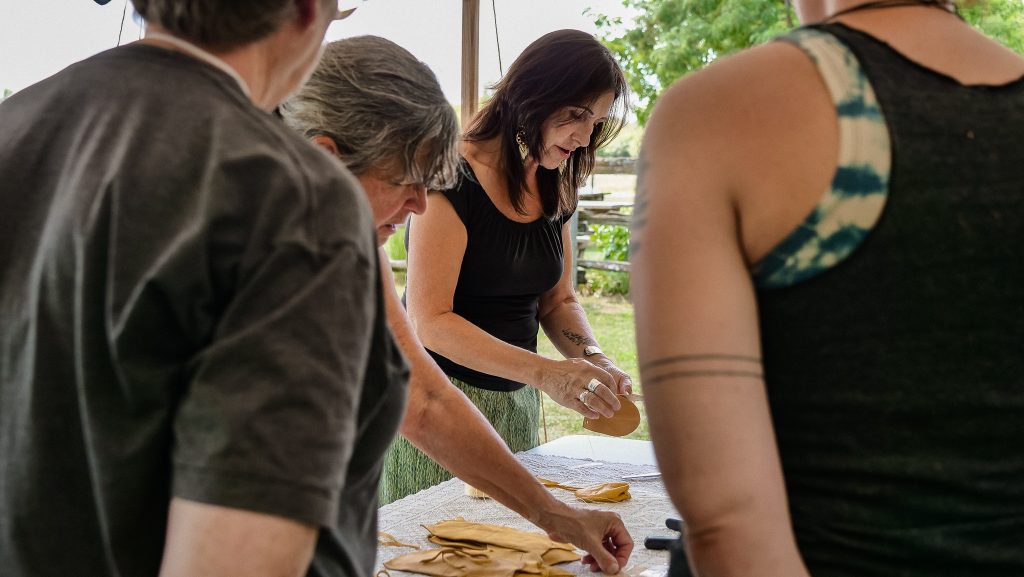
Mama, unfortunately I was not able to sit with her during her sharing. But, all weekend long we felt Mama’s joy and support. The open acceptance and interest in others was a palpable experience throughout the weekend.
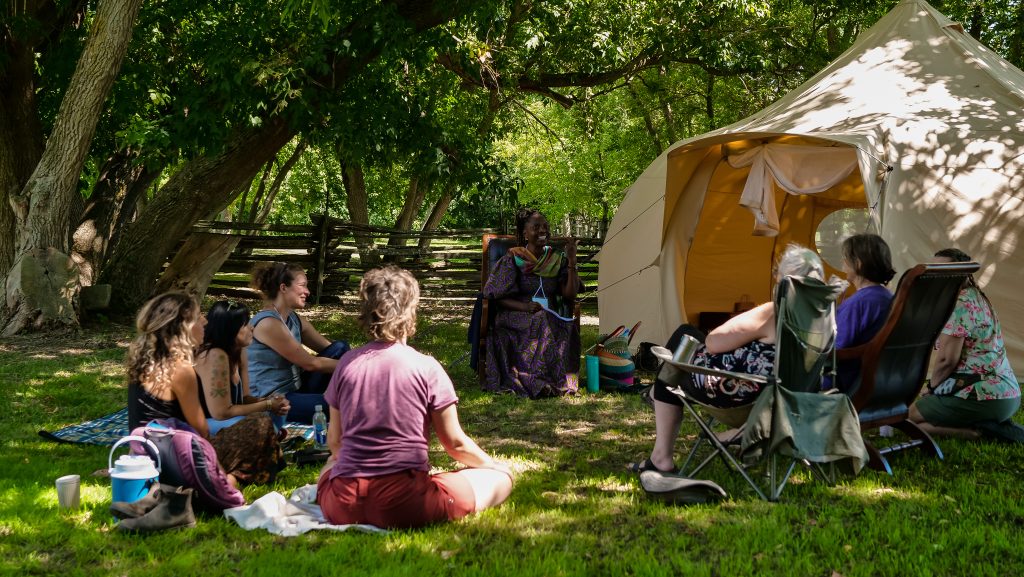
Dayna carried us through the weekend with her beautiful music, and in the background our volunteers, Evelyn, Chelsea, Candice, Charlee, Serena, Red, Debbie and the talented hair braider Rachel, tended to all that needed to be done. Without their efforts, Lady Slipper would not have seemed so easeful and carefree.
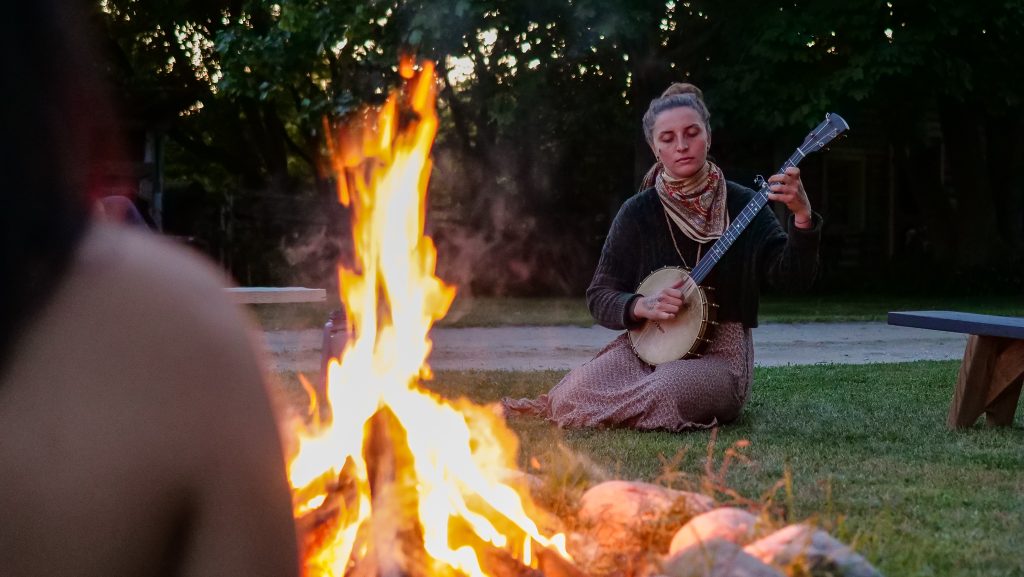
Penny and I want to thank all the women who came and helped make Lady Slipper the beautiful weekend it was. Your smiles, laughter, interest in plants and kind words, brought the true medicine to the gathering. Again, thank you.
Yours, Abrah
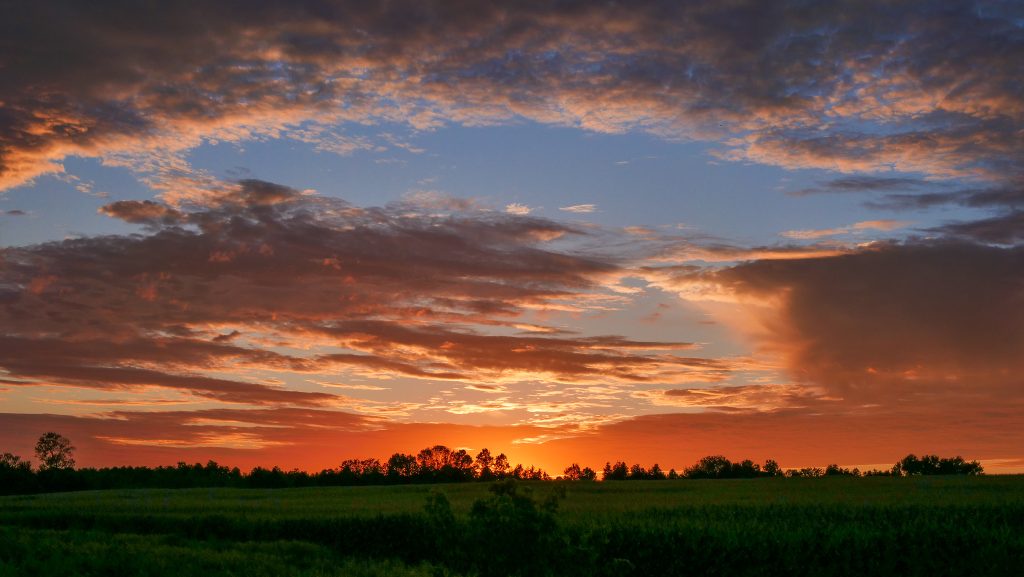
Photos by Serena Mor
An Interview with Steven Martyn
This interview was conducted as part of Everything Herbal’s ‘Herbal Elders’ series. This series seeks to honour and explore the unique contributions of longstanding members of the herbal medicine community in Canada, as well as abroad.
This interview was originally conducted with Nick Faunus, Penelope Beaudrow and Victor Cirone, in 2021.
How and why did you first get involved with herbs?
Steven Martyn: To be perfectly honest I think it was marijuana – it was a “gateway” plant for me… to other plants! But actually, it was all part of a time in my life when I felt pretty lost and had actually moved away from nature in my orientation: sex, drugs, rock & roll was my basic orientation. I think that plants, among a few other special beings, helped bring me back into alignment with nature. And then I really specifically remember yarrow, up on these little ridges in Muskoka, just thinking this plant was something else, that it had clearly come from some other place and landed here. That was my first plant, I was 17. It’s been an ongoing engagement since then, but in a way that food or any of the other essentials of life are an ongoing engagement. I don’t even really think about herbs and working with plants as an activity separate from the rest of my existence. I just slowly learned more and more over the years. I was lucky enough to encounter this phrase by Susun Weed, which was that you could only really learn about 3 plants a year. That was a good phrase to learn. I have kept at it, and it’s been 40 years now, and I am probably around familiar with 100 plants.
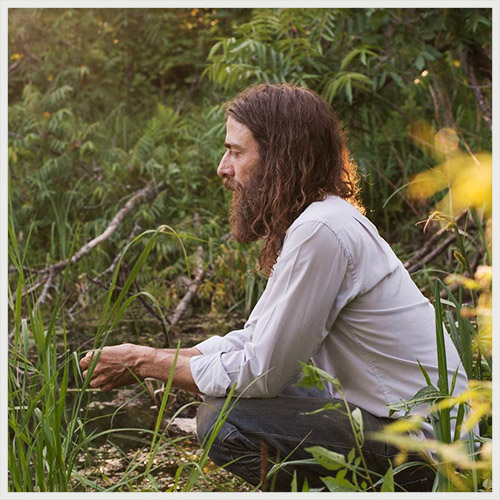
The depth of it, too: when you yourself get sick, I find that really shifted everything for me. It’s one thing knowing about the plants and having intuition and treating other people, but then when I got really whacked with Lyme, my life was dependent on my knowledge and every little thing I did I could feel expansively. Plants like dandelion that I kind of knew about, had felt some of their effects, but overall thought they were kind of minor players, suddenly became these major players in my health, and actually still are. With pretty much everybody I treat, dandelion is one of those ubiquitous herbs; everyone should take it basically, everyone over the age of 40 for sure.
How did your practice with herbs develop?
Everything Herbal: Can you tell us about your trajectory in the herbal medicine world? How did your practice with herbs develop? Can you give us some history and background concerning how things grew from the time you started? I remember the teas you developed [The Algonquin Tea Company], you were involved with the food co-op to distribute them.
Steven Martyn: I struggled. Nick, you met me in the really early days. I was interested in harvesting for you, and then the tea company all circled around at the same time. That all had to do with trying to make a living. It was one thing giving people herbal advice, but I didn’t know how to charge. I hadn’t gone to college. I didn’t feel I had any right to charge for anything. In the early days it was just friends and family I was treating, anyone who was willing to try my remedies. And then you gain confidence, and you realize you have to make a living, and I wanted to do this for a living. If it means working with the plants to generate income, harvesting and selling the plants, then that’s what I’ll do. Pretty quickly you could see that the wholesale prices you’re able to get didn’t really result in a living. You are competing against the 3rd world and against industrially harvested and processed herbs. When you are doing things by hand, it’s a joke. I remember figuring it out in those days, almost 30 years ago. I think I was making $2 an hour if you included travel time, deducted your gas, your mailing expenses…The idea of value added processing, of holding onto the herbs for longer and making them into something then came to me.

“I had always been a huge herbal tea person.”
People would come up to visit me in the north here, and they’d be like: you can drink tea up here? Yeah, practically all of these plants are good for tea! It took lots and lots of years of experimenting. I partnered with Kim Elkington, who had more experience on the business end of things, and I thought: tea, let’s do tea. It was an incredibly naïve proposition, but then it’s pretty much like having a kid. Once we gave birth to this thing we couldn’t just abandon it and say this is a terrible idea. Basically for 20 years I tried to make a living at it, we scraped by but oh man, it absorbed so much of my energy. It all comes down to conviction, whether you can carry out something like this. The commercial viability of it was terrible. If I had really done the numbers and worked it all through I never would have done it. It was totally following your dream; and then it turned around and ate me. I finally got away from it, and only then I had time to do other things. This coincided with me being really ill with Lyme and after I got better I really felt like I had a debt of gratitude, I had to help other people, there were so few people around talking about herbal treatments for Lyme and everybody was beginning to feel really panicky about it back then. Having a grounded approach and a proven approach is crucial. When you’ve proven it with other people you know the herbs had an effect, but you don’t really know the inner medicine of the person’s shadow and how all of that turned and made it able for them to get better. But, going through the healing yourself, that’s when you really get to know all of the deep inner things that go on as part of the healing process. Those herbs became – even though I had already known them for 20 years – allies in a big way. We also stepped up the school [The Sacred Gardener School] and to a degree, mostly by word of mouth, I stepped up my healing work which I didn’t really have time for during the 20 years that I was involved with the tea company.
Everything Herbal: After the tea company, how did you move into what you’re doing now, your writing and teaching, for example?
Steven Martyn: I always found there was a pretty huge demand for herbal workshops where you can show people how, in a really integrated sense, to grow the plants in the best way possible. I naturalized the plants; I don’t really row crop here at all. I have a patch that is 30 feet by 40 feet of angelica and it just does its own thing. I have other patches of different plants like that. Every now and then with some of them you have to turn them over or plant something else or give them some help but generally they are living a pretty wild existence, they are not domesticated. When you can show people the plant in that state is when many of the teachings can come through. And I’m emphasizing that, because if the plants are not growing in their natural setting, if they are not growing in the way they like to grow, a lot of their medicinal teachings can’t be seen because you’ve removed them from their true context. The broader the ecological context, the more the teachings can extend out.

I’ve been able to learn things in this way partly because I’m not trained, and to a degree it’s intentional. Initially it wasn’t intentional, it was just a form of rebellion. Throughout my life, anything where boxes were involved and I was going to get put in one wasn’t going to work out well. Mostly I followed the path that I did through instinct but in the last 15 or 20 years, it’s become more intentional that my medical allopathic understanding has remained undeveloped. Instead, what I develop is my deeper relationships with the plants, and my deeper knowledge of the practice, the actual practice of working with the plants. Because of my lack of training, ironically, I would say that I’m one of the few real traditional healers around. I’m not thinking about things allopathically. I sometimes explain things to my clients that way because they have to believe what’s going on. If I have one explanation, about how the plants are working with the land and with your body in an equivalent way, and I have a kind of allopathic, scientific gobbledygook explanation on the side, then some patients are that much more convinced. And let’s face it: half of healing involves ensuring that people are convinced of the process. You can’t just give them an herb and expect that it will work. At least 70% of healing is believing it’s going to work and if you can actually see it and believe it in an integrated way with nature, it resonates internally as well as externally. Unlike teaching abstractions about chemicals and how they are interacting in ways that we have never even seen, it’s all just on faith. The whole scientific project is pretty much on faith, you can’t see it.
Everything Herbal: Letting the plants develop in their natural environment: the importance of this is really only now being demonstrated by science. It can take a long time for science to catch up to what has been known intuitively for centuries, even millennia. Much current research in plant and soil ecology focuses on how plants need to have a compatible environment in order for optimal growth patterns to be expressed, and explores the intricate symbiosis of plants and the bacterial ecology of the soil. The biosphere as a whole is only now being given pride of place in scientific discourse. Science has caught up to these traditional ideas, and has now quantified them. Even 10 years ago, bringing up the idea that a huge percentage of our body is made of bacteria would have you laughed out of the room. But today this is cutting edge science.
You were ahead of the curve, your intuition brought you there, you weren’t able to express it with the magic words of the scientist but you still came to the same observations and conclusions that the academic community eventually came to, in their way. The academic community has trouble translating the intuitive, many academics have been trained to short-circuit the intuitive parts of their mind in an effort to develop a so-called rational, calculative mental capacity. Dissociated mentation that overtakes one’s intuitive, and imaginative, capacities and capabilities.
Steven Martyn: Definitely. And that is what I was saying about shying away from that kind of knowledge because I know the power of it. I always tell this story: I took a forestry course, a tree marking course – you do basal diameters to determine how many trees you’re going to be able to cut – and for 2 years I couldn’t walk through a forest without seeing basal diameters! It took that long to get rid of it, and it’s the same with herbal knowledge. I do these intuitive healing courses with herbs, I’ve done them now for probably 20 years, I’ve had literally hundreds of people come through, and almost consistently the professionally trained herbalists are the worst at the intuition-based exercises. The people who consistently do the best are the people who are totally fresh, who are new to working with herbs, who don’t know anything about herbs. It’s pretty clear to me that the left-brain overrides the right-brain, and you have to guard against that happening.
What message do you have for our young herbal enthusiasts?
Everything Herbal: Can you speak to some of the ways that social media is impacting people’s perception of what an herbalist is and does? There are many romanticized and even sexualized portrayals of herbal medicine on social media today – efforts to sell products by way of alluring and seductive imagery. What do you think of this trend?
Steven Martyn: I don’t really see any of that because I don’t spend any time online and I don’t go out, so I’ll take your word for it that this has been going on. Isn’t it kind of across the board that everyone thinks they know everything because they can access YouTube or whatever? Even if you have something memorized, putting it into action is a whole other story. In general, like with herbal products, I’m not for regulation. If you make good stuff, word gets out and you’ll sell more and more; if you make crap it doesn’t go anywhere. In a sense all of these things, in the economy of reality, self-regulate. It drives me crazy, all the hoops that people have to jump through in order to acquire a title. There is no category for lay herbalists, people that are just learning and trying stuff. I definitely see the odd thing that I would consider a mistake but very few that would actually be harmful. Let’s face it, herbalists, every herbalist I know, have different compounds, have their own individual approach. No two herbalists I know make up the same prescription of herbs for a given condition. You get good at it by doing it, by practicing, and if you are denying people their right to practice, then it’s going to be pretty hard for them to get good at it. Again many people who come to study with me already have an herbalist degree, but they can barely recognize the plants. Unless they worked with somebody like Michael Vertolli, who really takes you through a year of learning by way of the plants, then it’s all abstract and academic and they go ‘oh I can put this and this and this together in order to get this result.’ For me, right now we are making salves, I look at what is out there primarily to work with, what’s in season, what is calling to me when I walk outside. Nick was actually the first one to teach me how to make creams, to reveal the tricks of emulsification. Things get better and better, you get better at stuff with time and practice.
Everything Herbal: People ask me all of the time who I’d recommend as a good herbalist. My answer is always: look for the person who sees lots of people, not the guy who is famous or who has a big persona. You need to work with the people who are actually doing it all of the time, absorbing it, growing from it. That’s the key. There are a lot of popular people, but they aren’t actually doing the real work.
Steven Martyn: The culture of it here is weak, let’s face it. Primarily because of OHIP. I put a huge amount of it down to this: if we were on an equal playing field and people had to pay for a herbalist or for an allopathic doctor we’d all be pretty busy, I can tell you that. But it’s not a level playing field and there are all of the other restrictions that have come in through the drug identification numbers and this whole world… I want to call it the matrix…
Everything Herbal: The Codex Alimentarius?
Steven Martyn: Yes, the Codex. I knew I was in the ballpark. I understand all of these people say it’s to “protect the people” – it’s not at all, it’s an industry. People protect the people. If someone is a crappy herbalist and you hear bad things about them you’re going to tell others. I do. Or if they supply you with crappy plants, I’d spread the news. But if people have helped me then I hold them up, I give them praise. That is again what self-regulating is about. We don’t need all of these huge agencies to mediate between the public and us! It’s absolutely ridiculous. Like we haven’t all been herbalists for what, 300 thousand years probably? And now we need regulating?
“People protect the people”
Everything Herbal: They have taken the plants away from us, and it is our natural and inalienable right as living creatures to participate in earth based healing practices. When it comes to production, it’s been licensed and given over to those who can pay, it’s a crime against humanity. No one seems to grasp that – you can’t seem to get that point across.
Steven Martyn: It started centuries ago, when the monks took it away from the people and all of the knowledge was hidden in Latin, and the written word served to formalize and encode the knowledge of the oral culture and traditions. In a sense what’s going on now is the final nail in the coffin of a centuries long process.
Everything Herbal: In all of your involvement with herbal medicine, where do you think you’ve been able to make the biggest difference, the largest impact?
Steven Martyn: I have no idea. It really wouldn’t be for me to say, I suppose. But I’ll tell you in the last class I ran recently there was a herbalist who has been to a couple of my offerings over the years and I was grumbling about the tea company and kind of saying it was a waste of time. She piped up and said no man, that tea inspired so many people and connected so many people with the plants that actually grow here. That would be an example of how things come back around at you, and you don’t even know what it is that you’ve done. You’ve set a certain kind of thinking loose and then all of these other people emulate it in their own ways. I feel like because that just happened to me, that must be significant and I did pour my heart into the company for at least 20 years, so hopefully all of that energy goes somewhere.
And with the Lyme work, I also have had a lot of gratitude come back towards me, helping those who had no other person to go to. Lots of people just have to see me once or twice because they are lay herbalists themselves and with some good coaching and watching out for this or that, learning to adjust your dosage, with good education, they’ve managed to get better. I think it’s probably still among the most complex diseases that you can have – especially because you usually just don’t have the borrelia, you usually have the bartonella and the babesia and yeast problems, usually it is all very complicated. The goal is to tease that all apart and recognize the overriding issues and patterns, to learn to perceive the different interrelated layers. You don’t always hit the notes you are trying to hit until you get feedback from patients, and learn to take the information their body is giving you and adjust what it is you are doing accordingly. I’ve done the most work with Lyme in the last 5 years or so. It’s pretty gratifying because again I’ve been there so I know the desolation and desperation that you have in that state and when you find somebody who can help you, oh man. It’s such an emotional balm as well as a physical gift.
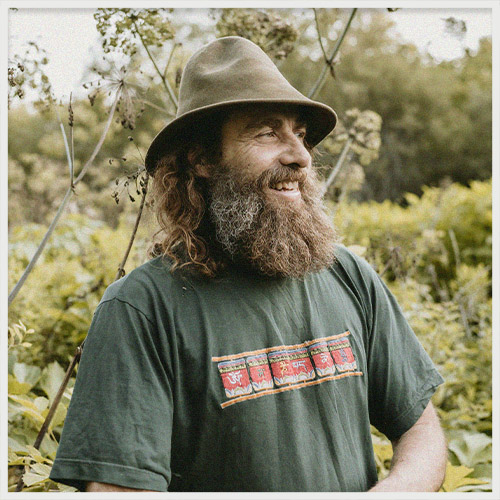
Everything Herbal: What you’ve described is the difference between being a healer and being a “doctor” in the current system. Our pharmaceutically based, conventional medical system actually teaches you to avoid emotional and spiritual connection with your patients, doesn’t it?
Steven Martyn: Oh for sure. I get it, too. I can only treat so many people with Lyme, for example. It is draining. If you’re open to folks, you have to be careful with your energy. I do lots of things, I do qi-going, and I eat the right food, and meditate to replenish my energy. If you don’t learn to safeguard your energy, I don’t know how you can even be a healer. Just seeing one person after the other, you are using up your energy, you are literally giving them your energy through the healing relationship. I know there is this idea with people who practice therapeutic touch that you are just channeling the energy. That may be true but it is not like an open channel, it is all tied in with your energy as well, with your light… and with your darkness. I love the traditional idea of healing, I suppose it’s from central America: you come to me to heal something and I’m the one who takes the drugs and then I take your illness into me and I wrestle with it and I work it all out for you and then ooof; you’re healed. And I’m kind of somewhere between that myself, because I definitely hear people’s physical ailments, I understand herbalism and the actions and dosages of different plants, but mostly what I’m listening for is what they are really trying to heal, so that other level of things takes our energy and it’s not just an allopathic equation that says this disease equals this herb. You’re going deeper with people and are trying to find what they are really working on.
“Our physical body, I’ve come to realize, is our spirit’s protector.”
All of the spiritual challenges we are faced with today, all of the personal and collective karma, all of the stuff that that is in the land and in our food, all of that is coming at us all of the time from different directions and our physical body is protecting our spirit from it. Your physical body absorbs all of that stuff and it morphs it into an illness so you can deal with it without it destroying your auric field. More and more I see that, that there are these very distinct layers that make us up as whole human beings. Our physical body is like a guard and protector for us as spiritual beings. We always think ‘oh I’m sick there is something wrong with me’; no, you’re sick, there is something right with you. That means your body is actually working, and it’s working on something, it’s not a bad thing. What is it working on? What are you trying to process that you can’t process spiritually or emotionally? And your physical body is doing it for you, it’s protecting you.
Everything Herbal: That’s the other contradiction with our new, modern medicine: the idea that suppressing all of these things that your body is doing is what leads to “cure.” When a disease is suppressed, it is driven deeper into the organism; the more it is suppressed the more damage it will do. Eczema of the skin that is suppressed with antibiotics or steroids, for example, can 5 years down the road turn into asthma. It’s not a different disease, but the same disease pushed to a deeper level of one’s physical being. Encouraging symptoms and working with them rather than against them is what is required for true healing. This is true on the physical as well as the mental and emotional levels, which are not always so easy to separate. That is what we do as herbalists; when we see someone’s symptoms, we actually encourage those symptoms in many ways. That is contrary to the establishment’s model. Do you ever have any issues with that, with threats from the establishment? I guess you’re not really connected so much with the conventional world, but do you have to deal with that at all,
do you have any issues with the mainstream, conventional society and their judgments?
Steven Martyn: I live a pretty marginal existence, and so that is one of the consequences of living the way I do, you can’t get right in the trough there with everyone else. That is a piece of it, but mostly I don’t deal with it directly, I deal with it through other people. Just in the last week I’ve had two people come to me wanting to get off their puffers with asthma. And with regularity I’m treating and helping people who are going through conventional cancer treatment, but they are doing all of the conventional stuff more and more. I feel like everything that has happened with COVID has driven the fear of anything labeled alternative even deeper into people. At the very least it’s a wedge, so people who were leaning that way are now really going that way, and vice versa. The level of fear is unbelievable and it is completely generated by the allopathic world.
Do you remember Essiac? If you Google that now, everything that comes up is negative. It’s a trip. I had recommended Essiac for someone who was going through conventional cancer treatment and told them you can make your own or you can buy it in the store. What I didn’t know is that the company has been bought out a couple of times and it’s all extracts now, it’s not even really made with herbs anymore. That’s a whole other big topic. And the hysterical claims that are made to slander natural healing: ‘This Essiac formula is not only a scam, it might even cause cancer!’ The people who make this claim cite some 30 or so studies, but if you actually look at how the studies were done, typically, it’s in this very narrow allopathic way. The idea that you could be brining toxins out of the body with the herbs, that you have initiated a cleansing process, never comes into the discussion. So if they test the blood at the wrong time and it appears to make things worse, then Essiac causes cancer now! Anyways, in my mind it was a perfect example because it was once so widely used: 30% of the women who had breast cancer in the 1970s and early 80s took Essiac. 30%! That’s a huge market share. And now they are taking it down, they are making sure it’s discredited. If you ever watch conventional TV like CBC or anything like that or listen to the radio they’ve been going after homeopathy for years now, they’ve completely “discredited” it. Homeopathy is one of the most widely used and successful forms of medicine, it is practiced throughout the world… but everyone is just imagining that it works, right? And anything herbal that starts to rise to the top will just have the legs cut out from right under it. Claims are made about contamination from heavy metals, or this or that danger or risk. Always with the fear mongering…
Everything Herbal: We have to deal with these kinds of things all of the time. Maybe 25 years ago we were sent samples from the original company making the Essiac tea, and we looked at their product and we wouldn’t have used those herbs to give to the dog, they were of such poor quality. This is another issue that happens all of the time: people judge the effectiveness of herbs based on poor quality products that are badly made, with no vitality, no life force. And yet another issue is that the vast majority of people come to see an herbalist when all the other approaches have been exhausted and have failed. We get everybody coming to us right at the very end of their health journey, when the chances of cure are greatly reduced, and that is never considered when judgments are passed about the efficacy of the practice.
Because we are talking about herbs and the quality of herbs, let’s bring this to a close and talk about how many herbalists and manufacturers take and take from the plant world without being trained or taught to give back.
What do you feel about how we should be giving back? What about endangered plants? What about conservation?
Steven Martyn: I suppose I do teach about this, but not necessarily using those words. Once you are tied in with the plants, with a family of plants, you become their protector. This is my experience. If I harvest from some place, my degree of care for that place goes up. And sustainability is of course the key. How do you know it is sustainable? Only if you really know the plants and how they grow, otherwise you can’t possibly know. You can make a rule, like say a quarter of the plants here I can harvest or something arbitrary that you’ve read somewhere, but you don’t know. You can only know if you’ve seen those particular plants growing for a few years, you’ve harvested them, you see whether they come back or not, and if you’ve done that many times in many places you start to develop a good instinct for what you can take and what has to be left behind.
I’ve learnt the hard way, I’ll admit it. There’s the odd thing I’ve overharvested in the past and then have come back and it’s not there anymore. Sometimes plants are more fickle in the wild, too. I taught this plant related college class for 14 years, and I’d bring them on the property and I’d tell them to not pick certain stuff and avoid walking on other stuff. One year, a big class came through and if you ever mention that anything could have psychoactive properties, or that you could smoke it, the little fuckers would circle back and take whatever it was that you were talking about. One time this happened with lobelia, I was talking about what happens when you smoke it, it’s part of a smoking mixture – I didn’t give all of the components I was just talking about lobelia – but someone came back and they took the grandmother and grandfather plants, they took the old ones. That whole patch just disappeared; the next year it was gone. The level of disrespect: lobelia is a powerful plant and so when it felt disrespected, poof! It vanished, it was gone.
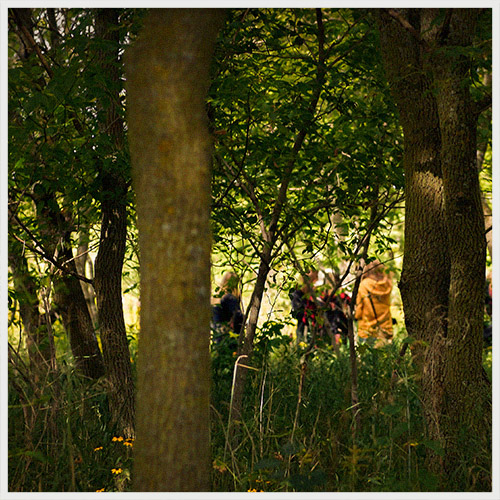
The tea company used to have to harvest about 120 pounds of burdock a year and I didn’t grow it so that all had to come from the wild. I harvested it in such a way that the patches all got bigger. So after you’ve dug some up you get the seed, kick it into the ground, kick all of the burs open and work it into the soil. I’ve come back the next year and there’s twice as much to harvest, now some of those patches I don’t harvest from at all, and the people with dogs are cursing me! And now they are 30 feet by 30 feet and we can have 5 of us there harvesting all day and it is still sustainable. It is this practice of tending to the plants. I have quite a nice little video on elecampane and my work with that plant to perpetuate it and make the patches of it stronger.
This is what I call wild culturing: you’re looking at the way things grow naturally and you are helping them grow that way. A real simple example would be with something like chamomile. People might pretty quickly notice that you can’t mulch your chamomile or it won’t perpetuate, they need to seed so you need some open soil around them. Every plant has its requirements for self-perpetuating. This video demonstrates the ecological diagnosis, the relationship between the environment and the plant, where it is and why it is there and how that works in relation to your body, and about this way of harvesting that is actually creative as opposed to destructive.
You are perpetuating something.
Steven Martyn has more than thirty years experience living co-creatively with the Earth, practicing traditional living skills of growing food, building and healing. An M.A. (traditional plant use), B.F.A. honours, artist, farmer, wildcrafter, builder, teacher, writer, visionary.
Steven created Livingstone & Greenbloom in 1986, Toronto’s first green landscaping company. In 1996, he created the Algonquin Tea Company, North America’s premiere bioregional tea company. He has given talks and run workshops internationally for more than twenty years. Steven taught plant identification and use as well as wilderness skills at Algonquin college for 11 years, and at the Orphan Wisdom School for eight years. In 2014, Megan and Steven started the Sacred Gardener Earth Wisdom School. Steven released his first book The Story of the Madawaska Forest Garden in 2016, and his second, Sacred Gardening, in June 2017. And now, “The Roundhouse” A meditation and guide to building a hand-made house with local materials” March 2022. You can find Steven online at thesacredgardener.ca and on his Patreon.
The Illusion of Facts and the Truth They Cover
A further discussion By Steven Martyn
These are very hard times for herbalists in Canada. Not because of the pandemic, but because of many unseen external factors. One factor that is noticeable for those who care to look is the extreme tilt of the healthcare field toward allopathic medicine and Medicare. There is a long history of how allopathic medicine came to be the most popular form of medicine in North America. I’m not getting into that here, yet it is worth noting that this monopoly on health care does not exist everywhere. World wide allopathic medicine is not even the most popular. For many countries, where the playing field is level and where the people are given a free choice, Homeopathy is the most popular, such as in India. In other countries traditional forms of Herbalism are the most common, such as China making them number one and two with allopathic medicine bringing up the rear.
Right now, herbalists have preventative medicine as well as treatments for mild and severe cases of covid, but the general public will never know about them because they aren’t covered by the Media, and are even taken down if posted publicly on the internet. Naturopaths, the most common practitioners next to allopathic doctors in this country have been forbidden to say anything about herbs for building immunity. They can only indorse what the allopaths approve of for prevention. Which I think is only vitamin D, a product made by or in conjunction with or by the pharmaceutical industry.
Why, you ask? Well, the government and the governing boards for medical and naturopathic medicine as well as Google would say it’s “in the interest of public health”. I say it’s the good old boys club.
Just to be clear, I do not believe in all the illuminati conspiracy stuff, where these mysterious players and the elite are all in agreement and working together to enslave us. In reality this conspiracy mania has to do with our psychological need for male authorities in our life (who often have been absent or abused their power) to be transparent, accountable and protective of our interests. In mythical and psychological terms conspiracy paranoia is about the “dark father”. As Joseph Campbell and his study George Lucas understood well, implanting the joke in star wars, Darth Vader (dark father).
The fact is for anyone who can see, we’re already enslaved, and have been for roughly four thousand years. We escape the pharaohs of one dynasty only to be enslaved by the ruling class of another. So part of the conspiracy accusations are right. But these parts are not hidden or big news, so they are not conspiracies. Admittedly, it’s true and always has been that the most wealthy families rule. They are the players and it’s their game. To hold on to power, they don’t even need to kill you anymore, they can easily tilt you off the field. They can control every aspect of public life now more than ever, including what you think. But no, they are not working together. Even the Gandhians in India have a very hard time working together and agreeing on what to do. You think egomaniacal, greedy, power hungry men are all working together seamlessly behind the lines? That is just not happening. But sometimes in plain sight there are alliances made between controlling agencies.
Alright, that’s the background. Now to focus specifically on what we are up against in Canada as herbalists. There’s a lot to cover here so forgive me for painting a picture in broad strokes. I’m sorry to say this, but a good piece of this has to do with Medicare. Now I know, our so called ‘health care’ system is enshrined as part of the Canadian identity, and I hate to be the one to burst your bubble but Medicare does not represent the will of the people so much as the will of good old multinational corporations. Simple proof that Medicare is not about our health is that while we rank in the top three for spending per capita on allopathic medicine, we ranked 17th in the world on the public health index. Something doesn’t add up. Should these numbers not correlate?
Medicare cost the taxpayers in Canada over $265,000,000,000 in 2019, before the pandemic. That’s 265 billion dollars a year, in a country of 38 million people! The majority of that 265 trillion goes to the pharmaceutical industry. Billions more go to insurance companies through the doctors and hospitals. Then there the doctors, who on average make over $300,000 a year, with many making over $2000 a day. And a good part of the rest goes to high tech equipment manufactures, many of which are subsidiaries of or related to multinational corporations that also happen to supply the military and nuclear power industry. Not surprisingly the nurses, probably the most valuable asset of the healthcare system, are the lowest paid.
Of this unbelievable abundance of funds, herbalists and homeopaths, the most popular healing modalities in the world, receive $0.00. And we the taxpayer pay for it all. On average we shell out $7,000 per person for ‘health’ services, 95% of which we do not need. Now that’s a racket!
With that kind of money you can create a self-feeding loop that just grows and grows like a virus infecting everyone in its path, even if you’re wearing a mask. Medicare and the government are far more interested in the corporate GNP than your health. By providing free allopathic doctor visits for everyone and free pharmaceuticals for over one million (mostly elderly) people (who take tons of pharmaceuticals) and partial pharmaceutical coverage for everyone else, the trillions of healthcare dollars generated through taxes are all used up.
Medicare claims to offer coverage for a “wide range of therapies”. Look into it and you’ll see behind their doublespeak. They only offer therapies under the allopathic umbrella. No herbalism, no homeopathy, no Traditional Chinese Medicine, no body work, not even massage, which they briefly allowed in the 1980’s and 90’s and then said was too costly.
So, to return to my first point, why would anyone look for an alternative like herbalism when you would have to pay for the consultation and the remedy out of your pocket? And this is why the only clients most of us herbalists get in Canada are people for whom allopathic medicine has repeatedly failed.
The second agent that’s painted herbalism out of the picture in Canada is the media. The huge rise in herbalism and other alternative healing modalities from the 1970’s-90’s was covered to some degree. But now the media has clearly stepped in line. For the last twenty years there has been virtually no mainstream media information supporting the use of herbs. Positive stories about herbalism or other alternative therapies have become strictly taboo. The CBC for one, seems completely invested in the big Pharma show, or maybe it’s the other way around. The only herbal stories I’ve seen covered in the past decade are about the ‘scam of homeopathy’ and contaminated herbs from China.
The third agent limiting the rise of herbalism is the enforcement of a world wide Codex that makes the herbal industry conform to regulations which are completely based on allopathic testing of “medically recognized herbs”. I was part of an herbal tea company for many years and watched the enforcement of the Codex come in. It took them about twenty years to figure out how to enforce it because there were so many small herbal companies. How would they police such a thing? But they eventually figured out if they went after the distributors they could shut down any big players that might cause some economic losses to the pharmaceutical companies. Eventually, through the distributor of the teas they found us. The government agencies working to enforce regulation demanded we change our ingredients. They said to me, a herbalist of twenty years at the time, that if we used the word ‘tonic’ on our box, then the product had to have Nettle in it. This was ludicrous. This tea had Sweetfern, Red Clover, Raspberry leaf, and roots of Burdock, Yellow Dock, Dandelion and Echinacea. These are mostly traditional tonic herbs!
The Codex and a half a dozen other restrictions about testing and production made it so the only herbal producers left on the board had to be big enough to join the corporate agenda. And again, all in the name of “public safety”. Most small producers of herbal products gave up. And many were funded (bought out) by the pharmaceutical industry. Suddenly these herbal products looked different and appeared in abundance, being shelved with the rest of the pills in pharmacies and grocery stores; bought out by the very agent that lobbied for the restrictions in the first place.
It’s only gotten worse in the years since I left the company. More and more I find myself, as a small time folk herbalist, up against a growing wall of ignorance and restrictions. And all I’m trying to do is heal people and make a humble living. Not $2,000 a day. I’d be overjoyed to make that in a week.
Looking at it all from a distance I see the trickiest part for regular folk to gain an understanding of what’s happening, let alone accept, is that the new level of ignorance is clothed in facts. We’ve been duped by the emperor’s new clothes. So splendid and convincing are these facts, that our faith sews them up into a garment that doesn’t actually exist, but is still able to hide the naked truth.
My body knowledge and faith move me in a different direction, and from this perspective, I see behind the camouflage of facts. Scientific and statistical facts can be incredibly deceptive. You might be wondering what I’m talking about, and think that “a fact is a fact from which we conclude the truth”. But if we look at history in retrospect, this isn’t how most of our scientific truths have been found. Any major new truth scientists have found in the last few centuries they’ve stumbled on accidentally, or a hypothesis comes into their heads “out of the blue”. This is the deeper meaning of the story of Newton’s apple or Einstein’s realization of quantum theory.
These days, because it’s such big business, I don’t know of any ‘pure’ science that’s being done. To make it clear, it’s not because scientists don’t want to explore unknown avenues for the sake of knowledge, it’s because there’s no funding for something that isn’t going to make money. In herbal research no one studies common herbs, which intentionally or not have come down to us as healers, through our ancestors. How can you create a demand for something that already grows in the backyard? Sometimes rare herbs are studied with big pharma money, with the aim of later synthesisation. The only serious herbal studies carried out these days are related to mass commercial use. These studies seldom use the herb as it is, they use an extraction. Apparently, for empirical reasons of consistency. But I’d say it’s the same old thing, they don’t want to do all this expensive testing on something from the backyard that you could just cook up at home.
In scientific methodology one does not just observe or just be and wait for information to come. Only artists are allowed to do that, right? This is where these two split apart but are in fact from the same origin. In science one first has to postulate a hypothesis, a theory or idea that can be proven through experimentation, and the collection of data. When you look at it that way, you can see how the whole thing starts to slide away from the naked truth, right from the start. And why art can easily capture truths empiricism is unable to even grasp.
We must realize in the process of scientific investigation it’s not just the question that frames the answer, but also the way in which this question is phrased. Then, even when our presumptions have sent us in the wrong direction right off, we continue on blindly collecting ‘legitimate’ facts until we can prove our theory. At this point we’ve backed ourselves into a closet of perception, only accepting garments fitted to our likening. So our conclusions are incredibly biased by what parts of the information we are able, and willing, to receive.
Scientific facts are just like a photo. Significantly the idea of using ‘facts’ as a means of defining reality came into vogue around the same time as photography did, about a hundred and fifty years ago. When we look at a photo we don’t really question its reality (or we never used to). And still don’t if it’s what we already expect to see. We think the photo, like a fact, is a reality. But it is not. At best it’s a mini two dimensional static reflection of a particular time and space in reality. The first inherent bias in a so-called ‘objective fact’ or a photo lies in where we point the camera, where we point our inquiry. Even given that this framing is just a reflection of a small slice of reality, there’s also the possibility of distortion or outright manipulation within that biased ‘framing’. And this is exactly what we do with our scientific facts.
I’ve spent the time questioning what ‘facts’ are here because as I see it, they’re an integral part of the illusion that keeps us locked in the exploitive allopathic industry with no place to turn. We’re mesmerized by the corporate magicians. Our eyes follow the ark of facts while the other hand has covered over the prize.
Another essential part of turning people away from traditional herbalism, that works hand and hand with ‘facts’, is to completely diminish, deny, or disprove all the herbal traditions and healing wisdom of the past. Unless it conforms to our ‘scientific standards’ – our frame. If it does then it’s usually diminished by being considered ‘primitive’ and ‘superstitious’. The truth is that truth won’t be captured so easily in our little gilded frame of reason. The truth is more obvious and more elusive, hiding behind the ‘magic’ spell of facts conjured by modern medicine.
The hidden truth is that disease is not the enemy but comes to us as a healer. They are an important part of the web of life in the natural world, including how we have become what we are. These beings have a purpose of their own. And while it might seem like a random collision when we get ill, they are a synchronized part of reality that has come to help us evolve and better ‘fit’ our environment. Two other truths that are not well known are, the body is perfectly designed to protect and heal itself by getting sick. And that, the body gets sick to protect our larger body, our soul. Even if it has to die in the process.
Significantly, we should keep in mind that people throughout the ages have understood disease is caused by isolation and imbalances with our living relations, which include our ancestors, the Earth and all her children. None of whom science even recognizes as sentient.
My understanding from working as a healer for thirty years or so is that an external form of disease comes to meet the dis-ease within us. The one trapped inside calls to the other to be released. Disease comes to touch our inner corruption so it can be released physically and spiritually; comes to create flow and connection again, to correct our imbalances.
Maybe we were born with the darkness in us or it was shot into us as a hateful dart by another in this life, but this dark seed always touches and takes root in our shame and our most corrupt feelings. And so, we harbour the disease by keeping it isolated and to ourselves. Negative feelings host the ‘seed’ of the disease within us. Then, as the seed grows, it manifests its outer physical form. When our neglected or abused relations have come to us and made us sick, they often come with a heavy hand because they’ve been kept at bay so long. From such a visit our spirits may get damaged, so our bodies step in and act as the intermediary, as our spirit’s bodyguard. Our bodies assimilate and process the disease or imbalance so that our essence will remain unharmed. The truth is our bodies in sickness are already doing the miraculous healing we need, all by themselves. Mostly, all they need is some time and rest to let them do their thing. But sometimes it goes too far, or goes on too long, or there are too many things to work on at once, and the body needs help. This is when the right food, healing herbs and body work are needed. Not pharmaceuticals, that just increases our distance from the Earth, our relations and ourselves, greatly complicating matters.
The herbs themselves are experts at alchemizing the darkness. They can turn it into flowers. The very way in which the plants balance and heal the dark Earth, they balance and heal the darkness in us to make it productive. Also, keep in mind both the herbs and ourselves come from the star people. We are not just of the Earth. So these old plant relations reach all the way up to the stars and so through their connections they heal not just our body but our cosmic soul.
Allopathic medicines, on the other hand, tests for and treats the symptoms, not the whole person. Exactly like pesticides, herbicides and fungicides in agriculture, modern medicine tries to kill the disease in our body. Not surprisingly, the biggest pharmaceutical companies like Bayer, are the very same companies that manufacture the agricultural chemicals that are poisoning the Earth.
In scientific testing, if the herb or medicine being tested doesn’t kill the cells directly it is deemed ineffective. While this model of testing is great for allopathic medicines, it is completely inappropriate for judging the effectiveness of herbs. Herbs are not just meant to treat the symptoms, they are meant to work systemically to help our body heal itself. From a scientific perspective this would be almost impossible to ‘prove’, because herbs have an extremely complex range of compounds. Sometimes there are more than two hundred naturally present chemicals in just one herb. And, these chemicals work synergistically to effect and enable the unbelievably complex systems in the body, which are still largely a scientific mystery, to heal itself.
Here is an example of the way these different approaches clash with potentially grave consequences, not the least of which is killing traditional herbalism. Recently, in working with a client, who was being treated for cancer by conventional means, I recommended, among other foods and herbs, to use Essiac (for her convenience). Not for the tumor itself, for that I use other medicines like Chaga. I gave it to support her. To help her organs cleanse the radiation and chemo and to deal with the potential release of cancer cells into her bloodstream and lymph during the operation. This client is a well educated well rounded person and like many folks these days she went right to google to find out what she could about my prescription. Yikes, on the internet the first couple of pages of sites that come up are all about the ineffectiveness and even potentially carcinogenic qualities of Essiac!
You should know that for thirty years I’ve made my own version of Essiac for family and clients and have advised many others with cancer to take the store bought concoction. Most of these people used the herbal concoction alongside conventional treatments, and they all healed. So from my own experience I could not be more convinced of this herbal concoction’s effectiveness. And yet, as I read, even I started to think twice about Essiac.
Because of my own doubts and my client’s understandable lack of faith in Essiac, I recommended she not take it. It’s been proven in many ways that half of healing is faith. For her that well had been too polluted to drink from. Instead we worked directly with single herbs, some of which were in Essiac, which grew and were made into medicine here at the Sacred Gardener farm.
In the 1970’s when Essiac came out, over 20% of women with breast cancer took this medicine. Since that time interest in herbal medicine has increased somewhere in the range of 500% and the frequency of breast cancer has almost doubled. So we are talking big big money. The kind of money that might get pharmaceutical companies to create bogus tests results to discredit the product.
Please don’t imagine that this isn’t going on all the time with factual and statistical information. It even happened with studies discrediting the link between cigarettes and cancer for over fifty years until the 1980s when someone from the inside blew the whistle. How do these mega corporations do this? Basically, they can frame or lean the trials and statistics in any direction they want. Like a magician they divert our attention, and unless you pay very close attention to the language they use, you’ll miss the trick. And, if they can’t get the scientists to comply they just shred the results, fire them and hire a new bunch until they find some that will comply to the corporate agenda. Recently, I was told just such a story by a friend. Her father was one of many scientists that were fired when they deemed a new appliance unsafe. He was fired during the safety testing for microwaves in the early 70’s, here in Canada.
One last note about how trials and stats can be used to ‘prove’ falsehoods are the many studies that say “a sample of the results indicate…”. This is apparently to save us from having to read through all the results, but clearly ‘a sample group‘ can and is often selected with a corporate bias. All these tricks are standard practice for industrial and medicinal testing.
In the example of Essiac, most of the internet information I looked at said it was based on 17 studies. Undeniable right? You would think so, but if we look a little closer we find these studies were mostly on the effectiveness of Essiac directly on cancer cells. But this isn’t how the mixture of herbs helps heal cancer. This concoction works systemically. These herbs don’t kill, or even claim to kill, cancer cells directly.
Typically, the origins of Essiac are swept aside and trampled on by the internet. Now I grant you the story of Essiac’s origins has its weak points and isn’t documented in any undeniable way, but that doesn’t mean there’s no truth to it. Before the pharmaceutical age, much of North American herbalism (which was mainstream medicine) was known as Eclectic Herbalism. It used medicine and practices from Homeopathy as well as herbs and herbal treatments from both European and Indigenous North American traditions. Essiac is what I would call an Eclectic concoction.
In Bancroft, back in the 1920’s, it is said an Ojibwa woman passed on the information of the cancer healing herbal combination to her nurse Rene Casey, for a patient with advanced breast Cancer. The chance of an Ojibwa woman ending up in a small town clinic is fairly good. These clinics often held both doctors and midwives. Back then allopathic medicine did not have a monopoly and was more open to working with other traditional healing modalities. The fact that the Ojibwa woman told another woman nurse, and not the doctor, also seems consistent with First Nations protocol. Which, at the time, would have seriously frowned on a woman speaking directly with an unrelated man about anything (let alone a healing cure). So the basics of the story sounds plausible.
The herbs in the combination (that we know of historically from the commercial blend) are a mixture of European and North American herbs. Sheep sorrel, Burdock, Indian or Turkish Rhubarb and Slippery Elm. These are mostly European and field herbs, which is suspicious, because most historically documented First Nations medicine in this area was derived primarily from forest plants and trees. But this doesn’t mean the story was ‘made up.’ There is much documentation indicating the quick adoption of European herbs by First Nations People. By the 1920s this area of the country had been colonized for about fifty years, which is two generations. That’s a good deal of time to adopt the new herbs. Colonial herbs were often absorbed into the First Nations peoples traditional practice and used in the people’s own way, sometimes for ailments even Europeans didn’t use them for. And, at least some of the herbs in Essiac, like the inner bark of Elm, were used for the same thing in both Europe and North American traditions.
I heard Susan Weed mention once that she thought the Turkish Rhubarb in Essiac was probably substituted for Yellow Dock, for commercial reasons in order to make the product more replicable. Turkish Rhubarb being very rare, and all the other herbs in the blend are very common (that anyone could just find in their backyard). I think this makes a lot of sense both commercially and because in thirty years of foraging all over this area I’ve never seen Turkish Rhubarb growing where it wasn’t planted, and never in the area of Bancroft.
Now whether you believe the story or not, as a herbalist the herbal combo does make a lot of sense. There are blood cleansing herbs like Burdock. There are sour herbs for bile flow such as Sheep Sorrel. And the Slippery Elm is soothing and a deeply nutritive herb. The whole combo has anti inflammatory and antioxidant properties. And, in defense of the product Essiac, it’s also worth mentioning that commercially if a product didn’t work at all, if it was “snake oil”, it would not sell more and more, decade after decade and become the world’s most popular herbal cancer cure. Before the internet, that kind of popularity only happened by word of mouth.
Another thing to consider about the negative test results of Essiac is the origin or source of the herbs, as well as the way they have been processed and used. None of this ‘backstory’ information was included in the studies I looked at. This is particularly important to consider in this case because many of these herbs like Burdock, Turkish Rhubarb and Sheep Sorrel actually absorb heavy metals and toxins where they grow. It’s part of how they alchemize and heal that spot. Because of this, a clean source for the plants is very important. This could be why the herbs might actually cause cancer, as one internet headline suggested. The other possibility of why Essiac generated some negative test results from the patient’s blood might be that in the herbs process of clearing toxins from the body, the toxins drawn from the cells are released into the test subjects blood and lymphatic system, which if tested at the right time, might cause negative test results. This is part of why sometimes herbs aggravate ailments before making them better, unlike allopathic medicine which is geared to quick suppression of unpleasant symptoms.
One last thought about Essiac is how it might have changed since its first commercial production. The company’s been bought out a couple times since the 1970s when they first came out in a big way. At some point in the last decade or so the product was taken from the raw herbs, which you used to decoct yourself, and made into liquid form. Presumably they did this to make it easier to take. But with the rising knowledge of herbalism, I can’t help but think this was just another “Turkish Rhubarb” to make the product into something you can’t reproduce at home.
I also have concerns about what the industrial processing might take from the herb’s medicine. Many herbal medicines need to be used fresh or within hours or days of their making because of oxidation. Simply stated, in my experience when stuff is processed enough that it’s become ‘stable’ then it’s also kinda dead. Industrial processing, from the way herbs are harvested and dried to how they are ground and processed into a product, notoriously takes the life out of herbs and food. I can’t help but wonder how much of the old herbal concoction (that you had to prepare by hand and simmer for a couple hours) has been lost to this new ‘pill’ form.
My larger point here isn’t about Essiac as a product and whether or not it works. To be clear, in part, I’m playing the devil’s advocate. I’m not defending Essiac and have no vested interest in doing so, I’m just giving voice to the old understandings that haunt me when they go unheard.
My question is: how could anyone without extensive knowledge of herbs, history, the herbal industry and the pharmaceutical spin, possibly analyze the overwhelming wall of repetitious internet information about Essiac, or herbal cures for other things like the flu? And even if you could see past the veil and analyze it and come to some conclusion different than the norm, who would risk their reputation and be willing to shrug off the insurance companies. Who would take legal responsibility by going against this great electronic edifice of science and industry? Who wants to be that person, a nail with their head sticking up? No one in their right mind, and that’s exactly what they’re counting on. Game, set and match, herbalism 0, corporate medicine 265,000,000,000. But we all pay the price of this loss in many ways.
Good thing I’m not worried about being in my right mind.
Let’s play another game, but this time not in a lab or on paper. Let’s do it here in reality on the Earth, where the paying field is level.
—-
Photos provided by both Steven Martyn and Serena Mor
The Hum of the Honeybee
Welcoming Spring
With Spring just around the corner, I can hardly wait to hear the songs of birds and the hum of the bees, both distant memories, yet sweet melodies to my ears. Living in Southern Ontario, even with the Spring Equinox only a couple of weeks away, it’s hard to imagine the sight of green, replacing the three feet of snow that still surrounds us. However, it’s during these colder months that I sit back and reflect on the early days of Spring where I can watch the world awaken yet again.
I often consider myself grateful to be a beekeeper, getting the chance to bear witness to the intimate life of a honeybee and a hive so full of life. That is, of course, only if we’re lucky enough to have them survive the winter. It is not uncommon for me to lose time in front of our hive, and I often think being around them on a busy midsummer’s day takes the busyness out of my mind.
If you sit with them long enough, they can become your teachers, as they have been for me. They have taught me how interconnected everything is, how far hard work can take you, and that a helping hand can go a longer way than the eye can see. One could argue they are selfless creatures, always putting the welfare of others before that of their own.
Becoming a Beekeeper
It happened by chance, as my partner and I inherited our colony with our first home. Though unplanned, this opportunity took me down a path of understanding on a deeper level where our food comes from, and how much different our world would look without our honeybees. They are a vital part of every ecosystem, among the many other invaluable pollinators that often go unnoticed.
It is said that one third of the food we know wouldn’t exist if it weren’t for our honeybees. Though it’s hard to miss something before it’s gone, I urge you to imagine a life without the delicious crunch of an almond, or the sweet pop of a fresh blueberry on a hot summer day – two of the many foods that surely we’d miss long after they’re gone.
Paying it Forward
With that, I encourage you to pay it forward, as the bees so humbly do for us, working hard all season long to bring us so many of the foods we love, medicine that we rely on, and a habitable and colourful landscape to live in.
In the end, supporting the livelihood of our bees supports that of our own, and there are so many ways to make a difference. Here are a number of ways that you can give back to the bees, keeping in mind that small actions have big impacts – just as the bees teach us:
1. Let your lawn go.
I always like to start by suggesting this one, as it requires no work but goes a long way. Letting any amount of land return to the wild encourages biodiversity and increases the likelihood of wildflowers to blow in and bloom, thus giving your bees more food for their post-hibernation hungry bellies. Trust me, the bees will thank you (and in my opinion, it’s far more beautiful).
2. Plant native wildflowers.
It’s hard to argue the beauty of a meadow abundant with blooming wildflowers, so find out which are local to you, and spread those seeds! This can also be a great opportunity to plant endangered natives species and support those at risk.
3. Avoid spraying.
Keeping things pesticide-free is a great way to avoid harmful chemicals, like glyphosate which wreaks havoc on the bees. Instead opt for more organic and natural solutions!
4. Support your local beekeepers.
Smaller scale beekeepers often have less demands to meet, thus more room to prioritize the health of their honeybees. This is a great way to support your local food systems and can go a long way for those suffering from seasonal allergies.
5. Giving bees trees.
Trees often get overlooked when we think about providing for the bees, but they’re a great source of nectar and provide them habitats, especially in the midst of continuous deforestation and development. Some trees, like Willows and Maples, make up some of the first food sources for them in the early days of Spring.
6. Choose wisely.
I like to say, if it comes in a squeeze bottle, it’s not the honey you want. This kind of honey is often pasteurized (a sterilization process that heats up the honey, thereby losing medicinal value) and contains fillers like corn syrup. Instead you can look for raw, unpasteurized honey – which is both better for you, and the environment.
Photos provided by Serena Mor
An Interview with Rosemary Gladstar
This interview was conducted as part of Everything Herbal’s ‘Herbal Elders’ series. This series seeks to honour and explore the unique contributions of longstanding members of the herbal medicine community in Canada, as well as abroad.
This interview was originally conducted with Nick Faunus, Penelope Beaudrow and Victor Cirone, in May of 2021.
“Tell us about your experience as an American herbalist?”
Everything Herbal: The American perspective on herbal medicine is presumably quite different than in other parts of the world because of all of the repression that the practice has faced in the United States. Can you speak to this history, in broad terms, and tell us about your experience as an American herbalist? Talk to us about the herbal Renaissance in the 60’s and beyond…
Rosemary: I’d like to start by saying that I’m just giving my one perspective, my own first hand experience. Everybody has a perspective, of course. After WWII, and even before that in the United States, herbalism had gone deeply underground. It was still very much alive in ethnic communities, in cities, and country areas where there were ethnic communities. These communities often still had their own medicine that they may have brought with them from other countries, for instance. Definitely our Native populations were still using some herbal medicine, though by this time modern medicine had really made headway on the reservations and there wasn’t a lot traditional medical information that was being passed along. In part, this is because there weren’t very many people who were interested in learning it anymore. In the Southern part of the United States, the Appalachian region, there were very poor rural communities still using herbal remedies – mostly because it was all that they had. They simply didn’t have access to modern medicine. And as modern medicine was being introduced as “the only legitimate system of healing” more and more of these rural communities did come to adopt it. Herbalism had gone deeply underground. Many of the traditional earth sciences and nature based traditions were changing during this time. Food production, for example: our whole food chain was changed dramatically during this same period towards the chemical-industrial model that we have in place today. Even the way that the American families were living – that idea of the “intact” family was beginning to change. After WWII when there was this influx of an amazing amount of chemicals that were being adopted by our food and medical systems, herbalism just became antiquated in this country. There were very few practicing herbalists. The ones that were still living were usually older and they were very vocal about what they were doing, but they were very few and far between. And there were very few herb books – those that were written were mostly about culinary uses of herbs, how to make crafts, and things like that. But they were not addressing the medical side of herbalism.
“Around the 60’s there was a kind of a cultural revolution…”
… And out of that rose a philosophy of getting back to nature. The term ‘organic’ was actually coined in the 60s. Before that people weren’t even talking about ‘natural’ or ‘organic’ food. And so it was out of this fertile soil that the desire to start to use natural medicines emerged anew. I would say that primarily it was coming from a young, disconnected, discontented population – much like what we are seeing happen right now. It is an entirely different issue with today’s generation: they don’t have to resurrect herbalism, but there are a lot of things within themselves that they resurrecting. I was on the cutting edge of herbal renaissance of the 60’s, I was of that age, just graduating from high-school, I was restless and discontented, and I wanted to get back to the Earth. I grew up on a farm, very close to the earth. I had very early training in herbalism because of my grandmother; that is one of the things that really helped me and gave me a head start. I grew up in a very poor farming family, with 5 children. Families like my own were using natural remedies not because they were cool or because they thought they were any better – it was because that’s what they could afford and what they were familiar with. I always proudly say that in my family, with 5 children, there were only two episodes where we had to visit the doctors. Once when my older sister broke her hip, and then again when my younger sister swallowed rat poison. In those cases, the medical society was exactly what was called for.
The other thing that was helpful for me was having a grandmother who was very well versed in herbalism, I like to always clarify this was in the old sense of the word. She used herbs because that is what she was trained in and knew well. She was genetically programmed to work with the plants. We see this in many different humans beings, that there is a deep calling to become involved with the plant world. We see this in different families and communities. My grandmother was certainly one of those people, and probably if I had known my lineage going further back in time I would have seen it there too, stretching back through the generations. That’s how it usually is. My grandmother was a survivor of the Armenian genocide and she use to tell us that it was her faith in God and her knowledge of the plants that saved her life. She really felt it was almost a religious duty to teach us about plants, as food primarily, but also as medicine. How that all ties in to your question is simply that going back to the Earth for me meant going way up into the mountains, learning with a lot of the elders, a lot of Native people who are very into sharing their knowledge with non-Native people because most of the younger generation were not interested at that time in learning. What we found a lot with older people in different cultures around the world was that they were eager to share this knowledge and information with anybody who was called to hear it. Those were my earliest teachers: my grandmother and the elders that I met. They weren’t all elders; there were certainly younger people who were sharing knowledge and information freely with each other, too.
“I was spending a lot of time backpacking, spending time with the plants.”
In 1972 I opened my first herb store in Northern California. There was one other herb store in San Francisco owned by a wonderful elderly couple, it was a landmark. Eventually a third store opened in Southern California. These little herb stores became focal points for large communities to get their plants. There were other herbalists doing this by the way, pocketed in different areas throughout the country. The herb stores were one of the early ways of spreading knowledge, people in the stores weren’t just selling herbs, but also teaching and educating, helping and healing. At that time we were doing all of that very freely – the stores were more like clinics of a sort. Then what happened was around 1974, right after I opened my herb store I started hosting classes. I didn’t know very much, I was in my early 20’s, how much could I really have known? But what I did know was more than anybody else, so I just shared more than I taught in a formal sense.
Shortly after that, I started hosting herb conferences and this was very pivotal. They were actually quite large even from the beginning. The very first one was at Rainbow Ranch in Sedona County, 1974. 50 people came to that weekend, admission was $25, there was food and lodging and dancing and music, much like the events we see today, which are patterned after that first one. We started holding those seasonally, 4 times a year during the solstices and equinoxes. Those events just catalyzed herbalism in the United States. Many people were learning and became teachers; the conferences helped to create seed balls of herbalists that you just tossed out into the wind. We didn’t have really well known teachers at that time, but one of the things that we did do that I thought was always very progressive was that we invited whatever elders we could find that would come and share with us. We had people like Rolling Thunder, Sun Bear, Wallace Black Elk, Norma Myers, Juliette De Bairacli Levy, Dr. Christopher… Our desire was to host these elders who were the treasure keepers of herbal knowledge, carrying it forward at a time when it wasn’t popular, there wasn’t money to be made or anything like that. Somehow or other we knew how to recognize these people, who seeded us, inspired us. We were the children of that time, learning at the feet of these great masters. It was really so grassroots, all underground, that was the beauty of it because what was coming up was from the plants themselves. It wasn’t the white coats teaching us anything, and by that I don’t mean the medical profession – it wasn’t coming from the colleges and universities. It was very grassroots, coming from the Earth, and people absorbing this through the souls of their feet into the souls of their being.
“By the 1980’s herbalism was still pretty underground.”
There was a generosity that to me was so inspiring, there was never any “this is my knowledge, this belongs to me” – it was just what I would call a very eclectic sharing; people feeling humbled by this knowledge and proud to be able to pass it on. By the 1980’s herbalism was still pretty underground. After the conferences it was in 1984 or so that I founded the California School of Herbal Studies, which became the longest running and one of the most successful schools in the United States. It is still going on. It has always been successful from the day we’ve opened it because people were hungry for the knowledge. It was a combination of research and scientific information but definitely based on the heart and soul of plants. At that time almost all of the students and participants who would come to these events were younger people, they all had lots of hair and not much clothing! That was always my joke. Wonderful radical earth based people.
In the mid and late 1980’s we began to see herbalism spreading like a mycelial network – right around that time immune disorders became a major issue, we had the AIDS epidemic and that just skyrocketed the awareness and information about the immune system and immune damage. Echinacea – who I always call the great herbal diplomat – rose up. Even though part of American herbalism, Echinacea hadn’t been used very much apart from within the Native traditions. It was being shipped in massive amounts to European markets, but was not being used in the United States. Here is the beautiful purple coneflower that people were growing in their backyard and recognized; all of a sudden it was being used for the immune system – people used it and saw that it works. It was the first herb that made the headlines. It was beautiful and familiar; people could find it at their garden centers. Then the industry began to grow – we started seeing the herbal industry, which went from pretty much nothing to an enormous global marketplace. This brought with it wonderful success for many herbalists, but it also came with its own set of issues and problems.
United Plant Savers
Around the early 1990’s we first began to address these issues around industry, with herbalism becoming very popular and acceptable again. In 1994 we formed a small organization that has become national and is now spreading internationally, called The United Plant Savers. It was formed completely as an organization that could serve as a voice for the plants; instead of asking what the plants could do for us, we sought to ask what we could do to give back to the plants. That organization marked a real shift in American herbalism; we felt like we had really matured. We had been using plants, teaching about them, spreading the news about them, ‘we’ meaning hundreds and thousands of people at this point, all doing our assigned work here on the Earth. We had matured enough to realize that the plants were sacred medicine, very special medicine, and that we had a responsibility as plant lovers to give back. For myself, during the next 10 or 15 years that became my major work, I focused less on community herbalism, which I’ve always done, less on my work as a teacher spreading information on how we can use herbs, and spent a great deal of my effort, energy and resources on really trying to turn our focus to what we could do to give back to the plants and the earth.
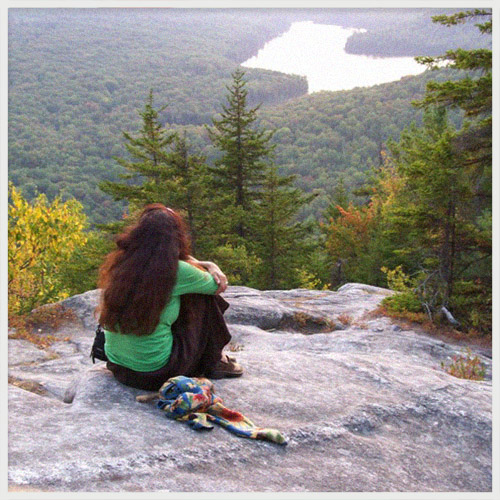
Fire Cider
Everything Herbal: The traditional herbal tonic Fire Cider has been a big issue in American herbalism in recent years, can you tell us about that story?
Rosemary: Fire Cider became another enormous issue amongst herbalists because up until this time, about 6 or 7 years ago when this all happened, herbalists had been very freely sharing recipes, oftentimes not claiming them as their own. Of course if you had a company or a business you often had to trademark your products because you were investing a lot of money in them, but within the larger community there were these traditional remedies that had been exchanged and traded, sometimes for centuries – like Four Thieves vinegar, for instance. Some recipes had been freely shared for decades, like Fire Cider. I had created the Fire Cider formula in the herb school with a bunch of students; it was a very creative process. I was teaching my students, we were making a product that had a very clear intention and we put together this formula that would be low cost, something that anybody could make, whether you are an herbalist or not. Fire Cider is something that you could go to the grocery store and collect the ingredients for and simply make in your kitchen. It is thought up as an easy and accessible tonic for the immune system, something to help ward off flus and colds. This formula I taught the first time in 1979 or 1980 at the California School of Herbal Studies. I printed it because I thought it was a great and useful recipe, it wasn’t any greater than a lot of the other recipes that I made, but it was one of those that became very well known. And it has just travelled out on its own the way that recipes should. My students taught other people, people started adapting it and making it their own, which is exactly what was supposed to happen. In truth most herbalists know that we don’t create anything, we are just vehicles, things come through us, we are building on our ancestors. I might have read that recipe in some ancient book and forgot about it. That is how long this information has been here. But nonetheless, everything was pretty happy, Fire Cider was part of this traditional collection of recipes that were considered to be collectively owned by the herbal community until a company – Shire City – came along. Now this was a young startup company who admitted that they were not herbalists and didn’t know anything about herbs. They had come across this recipe and they made it, thought it was great and shared it with friends, just like everybody had been doing for a little over 3 decades at this point. They started selling it at little craft fairs and started making money from it and they thought ‘aha! we are going to trademark this!’ And that is what they did, without telling a soul. The way that trademarks are set up in the United States is that you have a 6 month period to contest any new trademarks, but this company did not let anybody know that they had trademarked Fire Cider until after that window had closed. Then they started sending letters, very nicely written letters, to all the small companies who had been making Fire Cider and selling it saying ‘oh so sorry we have trademarked Fire Cider, it’s our recipe now and you are going to have to stop selling it.’
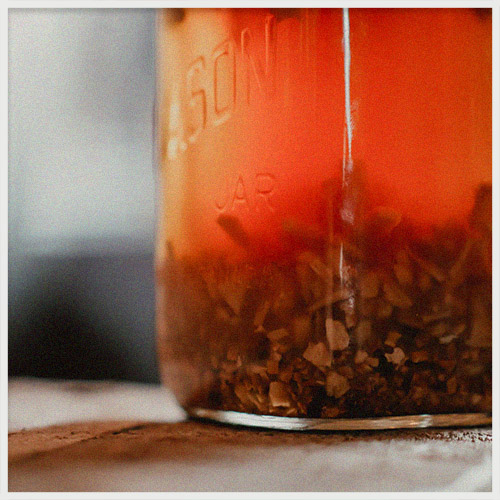
They were dealing with herbalists and they didn’t realize that herbalists are, by our nature, on the outside, on the fringes. We have had to learn to fight for what we believe in. There were times many years ago when herbalists were burnt alive for practicing. During the European inquisition, millions people were classified and persecuted as witches and part of what they did was practice the healing arts. Herbalists have stood up for what they believed in for centuries and we have been practicing a medicine that is illegal in the United States, so we were not just going to roll over. The herbalists Nicole Telkes, Mary Blue, and Kathy Langelier (now known as the Fire Cider Three) along with a group of others, decided that we were not just going to allow this to happen. If Fire Cider was allowed to be trademarked, any of the other traditional products that had been around for 10, 15, 200, 500, 5000 years could also be trademarked. What that would mean is that they would no longer be available for herbalists to make or sell. That just seemed totally wrong to us. It wasn’t a fight against trademark, it was a fight against trademarking traditional collectively owned recipes.
“We were forced to take a big stand”
The company turned around and sued these 3 women. We are not really sure why they didn’t include me in the lawsuit. For one thing, I hadn’t sold fire cider for 35 years, though I used to sell it in my herb store. I stood up for those women, and so did the entire herbal community. We all joined forces and insisted that this is not going to happen, you can’t take our traditional recipes away from us. You can make your own recipes, add something different or come up with your own product names, we wish you all the success in the world, but you can’t try to disrupt our traditions. This case ended up going to federal court, we spent 9 days in court fighting for traditions not trademarks and we won, thanks to our really good lawyers who donated their time to our cause. We are talking 5 full years that this lawsuit went on for. It was difficult and really challenging. There were lots of times when we were just worn out from it, it required lots of money, we all pitched in and helped to pay for it, and so did the whole herbal community.
“The community really rallied to support us.”
We felt that even if we didn’t win the case we won anyways because we stood up, that to me is the thing we always had to keep in mind: just by standing up we had taken a stand for what we believed in. When we did win it was an enormous accomplishment for the entire herbal community. This case was called a landmark case, a precedent setting case. Our victor not only meant that herbalists were protected but also that if you are an artist or some other craftsperson and within your craft there is a well-known product, somebody can’t just come along and trademark it. It doesn’t have to be something that is broadly known and recognized by the general public, as in our case herbalists are considered a subgroup of the population. Shire City argued in their defense that Fire Cider was only popular amongst a small group of people, and so it was fair game. The case was won based on the fact that even though we were a small subgroup of people, Fire Cider was well known in our community and so was to be kept free from trademark restrictions. In other words, this case not only meant that herbalists are now afforded better protection – it doesn’t mean that companies won’t come along and try to do this kind of thing again – but now we always have a case that we can refer to if such a thing does happen in the future. We are proud of ourselves for that, and also really glad that it is over!
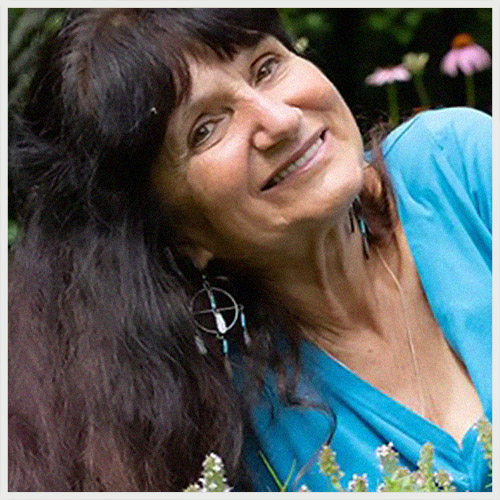
“What are your feelings about the way the herbal industry has shifted?”
Everything Herbal: Your actual battle was against the misuse of the trademark laws by a company that saw a profit making opportunity, which leads to another question: we have watched the herbal industry develop in the same way. I started my business [Faunus Herbs] growing Echinacea. The thing we see today is the institutionalization of herbalism, herbalism becoming part of mainstream culture. In Canada we see it being taken away from us and being given over to a group of people with no grass roots skills, no nothing: bureaucrats who are keen on monitoring and controlling things. And in the United States things are going the same way, things are being institutionalized and monetized. In Canada for instance you can’t even make a claim about a plant without being threatened with jail time. This is something you’ve been able to do for thousands of years, and it has now been taken away from us. What are your feelings about the way the herbal industry has shifted? It is great that herbs are now available everywhere, but there have been so many restrictions placed upon us. Our herbal formulas are works of art, analogous to blues tunes. One you record a blues tune, it becomes stuck forever, with the same notes, the same everything. But that is not what it is in essence. How do we guard against this rigidity coming into the sphere of our herbal knowledge?
Rosemary: We have been fighting this battle for a long time. In the 1980s we had a wonderful herbal organization called the American Herbalists Guild come into being. It is a professional organization and they were founded on the basis that they wanted to create standards for herbalists. They had really good reasoning: we need to set the standards before the government does. The larger herbal community said no, we don’t even want a group of herbalists to create those standards for us, because so long as we stay united in this fight we will eventually win. If we have a small group of herbalists who feel that their vision is the one to go on, then we stat to create divisions and hierarchies in our community. The intentions of these people who wanted to set standards for herbalism were incredible and some of the people who were behind this movement were brilliant practitioners and close friends of mine, but there was another group of us who just argued that we don’t want to do that, we don’t want another group of herbalists who say this is our recognized and acceptable course material, etc. We can see what happens with that: when you look at any institution that has allowed those officially sanctioned standards to dominate, they don’t end up serving the people. In our case, such standards would not serve the plants or the herbalists in the long run. Eventually after many years of dissension the AHG became more supportive of this other way, partly because there were a lot of young herbalists that became involved in the organization.
We have a small organization in America called The National Health Freedom Movement. I have been really educating people about this group and inviting their members to be keynote speakers at our conferences. This organization is comprised of lawyers who go state-by-state changing the laws, advocating for greater health freedom rights. You and I as citizens of a free country should have the right to chose the type of medicine we take and the practitioners that we consult with. Within these laws, called safe harbor exemption laws, are clauses that protect practitioners of non-licensed healing arts. So far in the United States we have 18 states that have passed these laws. I was on the board of directors of this organization for a time, but had to step down because of events in my personal life. Now my main way of spreading this news amongst herbalists is by inviting Diane Miller, a very powerful speaker, to be a keynote at our conferences. It is so important that this information about health freedoms and personal health choices gets out there. We as herbalists don’t need to get legalized by the government, we need laws put in place to provide us with freedoms and protections. These laws demand that we have integrity in our practice by, for example, always clearly stating where we have studied and for how long. This is important. Me, who has never had any formal training, I would just say I studied with my grandmother, founded my own school, and have been practicing for so many years, but don’t have any official credentials. And anybody who felt safe coming to see me would have the right to do so.
The other thing that these laws demand is that you don’t practice outside of the realm or scope of your profession. As an herbalist with very little medical training I won’t use medical terminology or medical diagnostic skills. These laws protect unlicensed practitioners. I am an enormous advocate of these laws, which have become very active right now because of COVID. The National Health Freedom Movement is a more radical group who feels that you should not have anything forced on you with regards to your personal health. Their big stand is health freedom rights for individuals. It is important that we have some form of protection just being herbalists, with or without certificates. It is dangerous when a government body starts telling us: this is how you have to be in order to be a practicing herbalist. I do think that medical standards can be good. There are some people for whom they are necessary, they just feel more comfortable with an herbalist who has medical training or who is accredited. I just think that as free citizens we need to maintain our freedom of choice.
When it comes to your own healthcare and that of your family, it is your right and not the government’s to step in and decide these things for you. People are today forgetting that, they are willing to let the government decide what you are going to eat, what you are going to put into your body, the kind of medicine you are going to use. Benjamin Rush, a doctor who signed the Declaration of Independence, said if we allow the government to decide what medicine we use, we will become a despotic nation. Thomas Jefferson made a very similar statement: the people have a right to choose what food and medicine they use. We have to be mindful; these kinds of regulations often come with good intentions. When the doctors got together in the mid 1800s with the aim of forming a medical association and setting certain standards, they ended up shutting down the Eclectic schools of medicine [a branch of American medicine which made extensive use of botanical remedies], which were some of the best medical schools we ever had in this country. By the 1940s, the last Eclectic school had been closed. These state licensed doctors went on to become the one and only medical system in America – and look at what has happened to medicine in this county, and beyond. Of course it is incredible and wonderful in some ways, but the way that it is set up doesn’t serve everybody, and is not well suited to all health conditions. It has become despotic in many respects.
We have spread this grassroots movement so strongly in the United States and I believe in Canada as well. In the United States I know that there are many thousands of us, community herbalists practicing out of our own homes and there is no way anyone is going to squelch that movement. Grassroots are very strong, they may go underground for a while, but herbs grow really well underground, the roots grow and spread well. You keep preaching and teaching and spreading that information and there is no way that it will ever be squelched again.
It is important to reiterate that this is just my view of American herbalism, we are a strong and very eclectic group and every person you ask will have a different story. I was there when it started mushrooming, and it was a very lively and exciting time. I’m grateful.
To learn more about Rosemary and her work, visit her online at: www.scienceandartofherbalism.com
–
Photos provided by both Rosemary Gladstar and Serena Mor
Rising of The Sap
Tapping a Sugar Maple with Kids!
While towards the end of winter, it often seems like the cold days are never going to end, there is always this one special activity to look forward to…
One late winter day, one of my sons asked me to ‘tap’ our Maple tree – he wanted to taste the sap. Quickly he remembered that back in the bush, in the abandoned shack, there were dozens of old maple spouts. What can I say; while I use maple syrup in my kitchen weekly, never have I enjoyed the sap straight from the tree.
Finding the Right Tree
Many maple species can be tapped for their sap, but we were out to find the sweetest of the all; the sugar Maple. With our tree bud ID, we quickly set out to find one. It did not take long for the kids to forget about me, running around in the bush, finding several sugar maples on their own. Equipped with a drill, spout and small pail, we started the adventure of tapping our first tree.
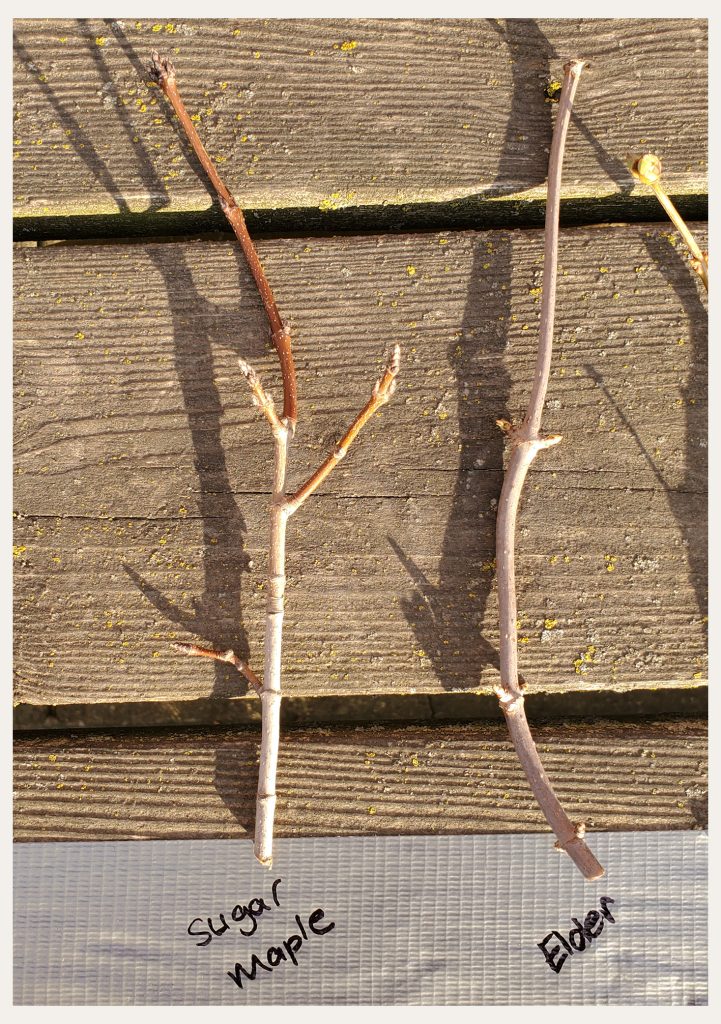
You should have seen the joy and amazement in their eyes, as the sap started dripping immediately. Little mouths, wide open right under the spout. Drip, drip, drip. Oh how sweet Maple’s water tasted!*
Close to lunch time we decided to hang the pail and collect the sap. By the time we returned, which was around 3 hours later, our little pail was overflowing! This got us even more curious. How about we collect 2 days worth of sap, and boil it down to make our very own maple syrup – just enough for one pancake breakfast…
Learning Together
One just has to love the innate curiosity kids bring with themselves. This easy and simple activity of identifying a sugar Maple, tapping it, tasting the sap and boiling it down to make syrup, just enough to enjoy it for one special breakfast, filled our weekend with joy, harmony and countless memories made. Not only have my children now experienced the taste of fresh Maple sap, but on a very small scale, they now know the basic process of how to make syrup in our own back yard, with next to no professional equipment, but only what we found in the kitchen. That weekend, we left the car in the garage and appreciated the gifts Mother Nature has offered us. We had each other, surrounded by crisp winter air, the warming rays of father sun and fresh, sweet Maple sap. An activity guided by the sun and the wheel of the year.
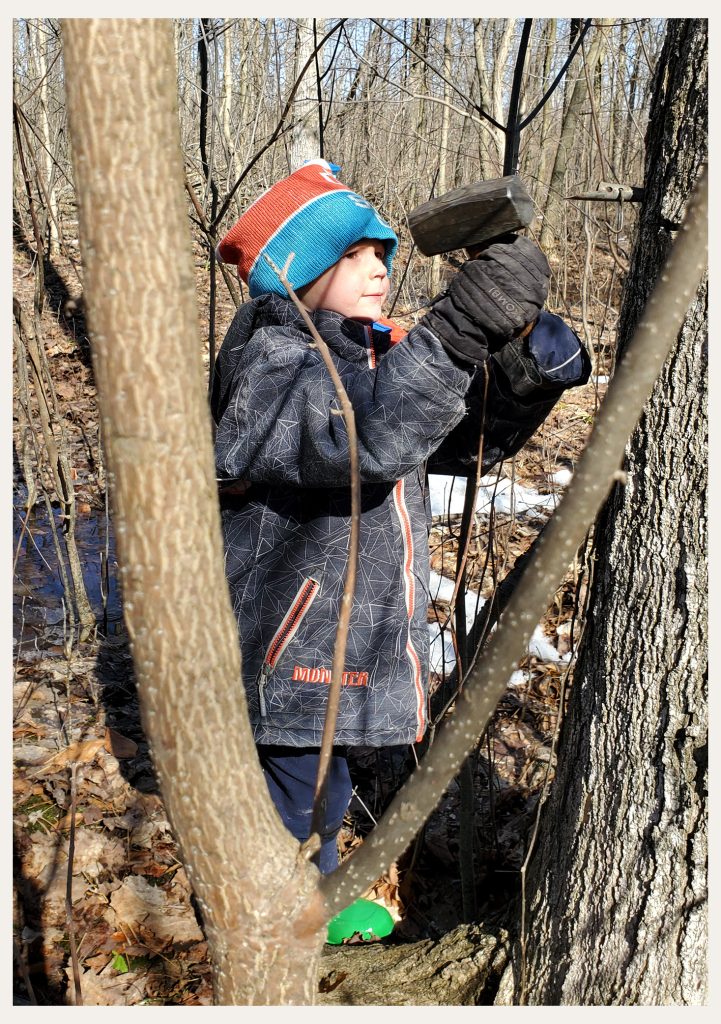
Following the wheel of the year is what brought us as a family closer to nature as well as closer to us, ourselves. While times can be busy and many of families are feeling a ‘disconnect’, it really does not take a lot to find your way back to the natural world and the myriad of gifts that are offered to us.
Reconnect to Mother Nature!
With all that being said, let us help you reconnect with Mother Nature!
At The Lion’s Tooth, we have designed a program to help busy families who feel disconnected from nature and their ancestry. Through 12 digital and in print magazines, with easy and accessible lessons and activities, families can re-connect with nature and learn to use plants like their ancestors did.
It’s time to find your way back to Mother Earth and live by the cycle of the sun. Connect to the wheel of the year and learn foundational knowledge about common wild plants and their many uses.
To learn more and to sign up, visit us at thelionstooth.ca
You can also connect with us on Instagram and Facebook @thelionstooth.ca
*while maple sap has several amazing health benefits, please be aware of the advised cautions when consuming it raw. Please research before drinking.
Featured header photo provided by Serena Mor, and blog photos provided by Evelyn
Friend, Foe, or Phlox
Three years ago, a common wildflower almost killed me. Three years ago, the same common wildflower saved my life.
Today on my run I felt the telltale signs: vertigo, nausea, hives creeping up my arms and legs, a burning sensation in my throat. I wasn’t surprised when I rounded a cliff and saw her sticking her straight stalk and vibrant blooms up through the sedge and clover. Wild phlox. P. paniculate, one of the 65 members of the Polemoniaceae family. If you gave a kid a box of paints and asked them to decorate the forest, what you would get is phlox: huge neon splashes of purple, pink, pearly white, and red stochastically sprawled across the landscape. They are bright as phosphines burned into your retina after staring at the sun. And their perfume is sweet, powdery, bordering on synthetic. It reminds me of the floral perfumes young girls would wear in high school, to mask the animal funk of their pheromones.
I’ve always been allergic to Phlox. It runs in the family. My dad’s eyes water and he starts to sneeze the day they bloom. And like clockwork, I’m usually right beside him, wheezing and steering clear of the beautiful wildflowers that others pick to accentuate their foraged bouquets. However, three years ago my allergic immune disorder had been especially inflamed. Courses in antihistamines, steroids, and experimental drugs treatments had all proved completely ineffective. And I’d recently moved into a two-hundred-year-old farm house deep in the mountains, unknowingly in the middle of a huge patch of phlox.
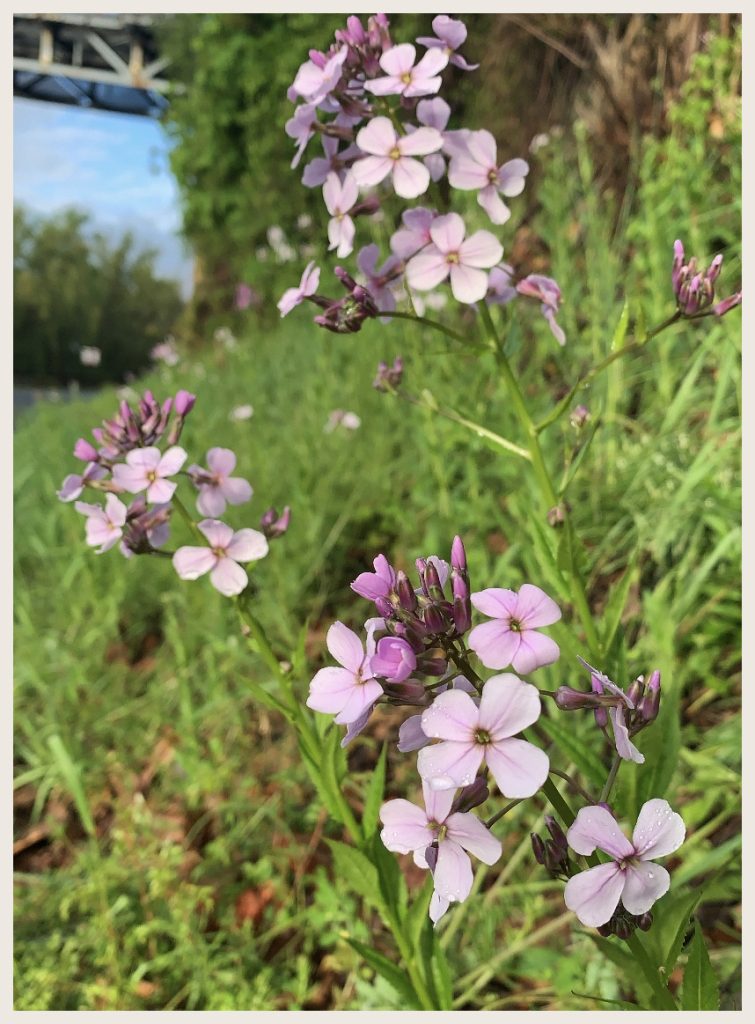
I was very busy so I didn’t pay attention to when it first began. I’d been ghost writing a young adult chapter book a month for the last seven months while researching and finishing my own novel. I’d been juggling cascading health issues, travel, and an unhealthy relationship. So, when I first sneezed, I didn’t think much of it. I walked past a magenta bundle of phlox on my walk home from my favorite coffee shop. “Hello, you beautiful little demons.” I thought almost affectionately. But the truth was, even though I’d always been deeply tied to plants and local ecology, the fast-paced emotionally draining nature of my life had given me vegetal myopia. I was always having animal encounters, but my plant encounters had blurred and begun to fade into the background.
Two days into phlox season something was different. This was not my typical reaction. I was wheezing, but the reaction was deeper than normal asthma. I felt like I was at altitude, a serious runner who suddenly could hardly scale a flight of stairs. I turned beet red from head to foot and started to pee blood. I couldn’t swallow and my kidneys ached. People with long-term health issues will understand the term treatment fatigue. I’d been in the hospital so many times, and been subjected to so many failed treatments, that a stubborn part of me kicked in hard. I would not go to the hospital unless I absolutely had to. Phlox season would pass. I would get through it. Drink tons of water. Shut the open windows. Focus on work. Hide the seriousness of this episode from friends and family. But three days in I entered another realm entirely. I couldn’t move or breathe. I developed a fever, something that can happen when your immune system is thoroughly freaked out. My eyes swelled shut. I started to hammer Benadryl, hoping it would at least blunt the worst of the symptoms.
I started to live in my huge living room, once an old bar in the carriage inn turned house, crawling around my stacks of books blindly, unable to write or read or even sit still. I’m not sure how it happened, but I found myself listening to hundreds of hours of herbal podcasts, lore about local plants and cures, and interviews with ethnobotanists. Unable to sustain reading, I blinked blearily through my collection of wildflower and local plant identification books, tracing the illustrations of phlox with a hive-covered finger. “What am I supposed to be doing?” The Phlox had forced me to sit still enough to realize that I had to change my life. Strangely, I’d strayed off the “path”, by staying too firmly on the path. As a child I ate dirt, kept notebooks full of drawings of my favorite plants and mushrooms, and bushwacked through the forest. But driven by financial need and a narrative I didn’t own, I’d been moving at a pace not suited to the plants and not suited to my own body.
In other cultures, still more attuned to the wisdom of plants, it is common to do plant meditations or work by ingesting a small amount and asking questions. Vegetelistas in South America will ask for plant dreams. But in our fast-paced culture, we don’t often go to plants and ask for medicine. Sometimes the message has to get loud. Phlox realized I was never going to show up on my own. So, she decided to come to meet me. And dream through me. Finally, on day six, ready to admit myself to the hospital, I dragged myself outside, wearing a kerchief around my face and drapes of clothing to protect my skin from the wafting pollen. I hobbled down the road to where she was blooming in a technicolor patch. “What do I need to do? What do I need to do next?”
The answer came immediately. And it came in a tumble of technicolored voices. It’s time to move at the speed of plants. It’s time to study us. To devote yourself to us. I dragged myself back inside and signed up for every local class on herbalism and plant identification walk. I gathered all my books on ecology, plants, herbalism, and trees, and ordered more. Much to my partner at the time’s consternation, I turned my living room into a compost heap of books and pressed flowers and notebooks spread across the floor like fallen leaves. Within a month I was doing an apprenticeship with a famous herbalist (an experience that was controversial and wild and perhaps someday deserves its own essay). And within a month I was healing my own health issues with tinctures and teas I had made myself. Deathly allergic to most antibiotics, I suddenly had another method of treating small infections. A year later, diagnosed with acute kidney failure, I tapped into the plants before beginning a medical intervention. What do I need to do next? I asked, this time more confidently. And they helped me, showing me what to eat and brew and do. When I managed to correct my kidney numbers in the course of the week my doctors were stunned.
When I look back on my life, I can finally see that the phlox saved me. They brought me back into an intimate collaborative relationship with plants. They reintroduced me to a speed of life, rooted and seasonal, that was much better suited to my own tricky body. They were bright and showy and insistent enough that they caught my attention. My deep, undivided somatic attention. And eventually they guided me to the tools to deal with their own wily medicine: strong nettle infusions during allergy season. They were an initiation, squeezing me until I burst open, flower-like, into an expanded vegetal awareness. I’ll never forget day seven of phlox season when I found that I could breathe again. I walked out my front door to see that my new peony bush had recently produced a salmon-pink bloom. And below her crown-vetch was creating little purple fairy crowns. Cleavers bordered the walkway down to the road. Poison ivy embraced the old oak. Mushrooms bubbled up from below the porch. All that year I’d felt alone, trapped inside a draining relationship, living far away from towns and friends, working so hard I didn’t have much time to relax. But suddenly the plants arrived en masse.
“We’ve always been here. And we always want to help.” The phlox twinkled across the road, her color already fading, making way for the orange of day lily season. “Remember to remember us. To greet us. That is the medicine”, she said. “You must know that you are never alone.”
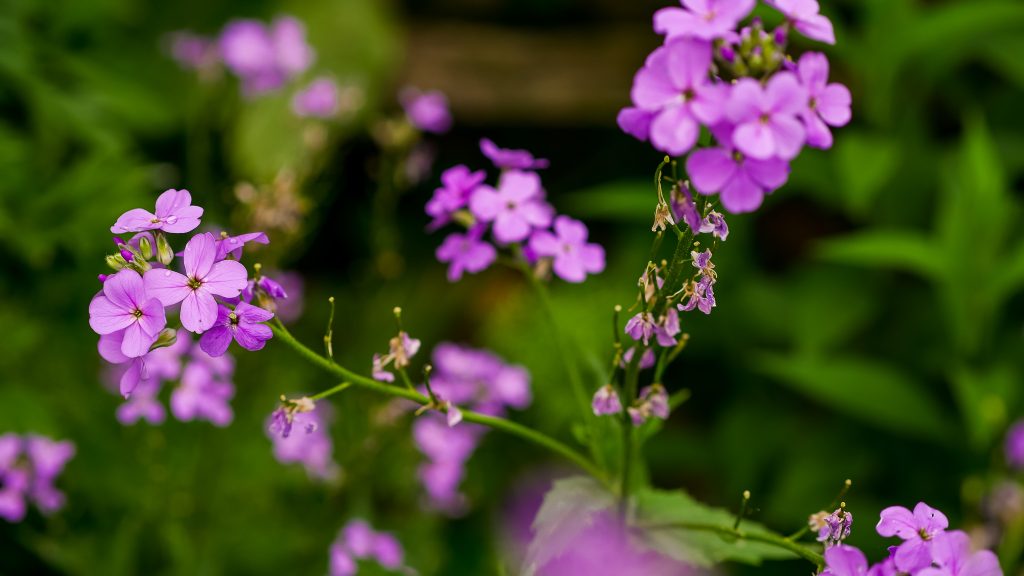
Note: The photos featured in this blog are of plants from the family “Brassicaceae” and not “Polemoniaceae” which is true Phlox. While both are very similar, true Phlox has five petals and five stamens and plants from the Brassicaceae family (Dame’s Rocket) have four petals, and 6 stamens.
First Photo provided by Sophie Strand
Final Photo provided by Serena mor

